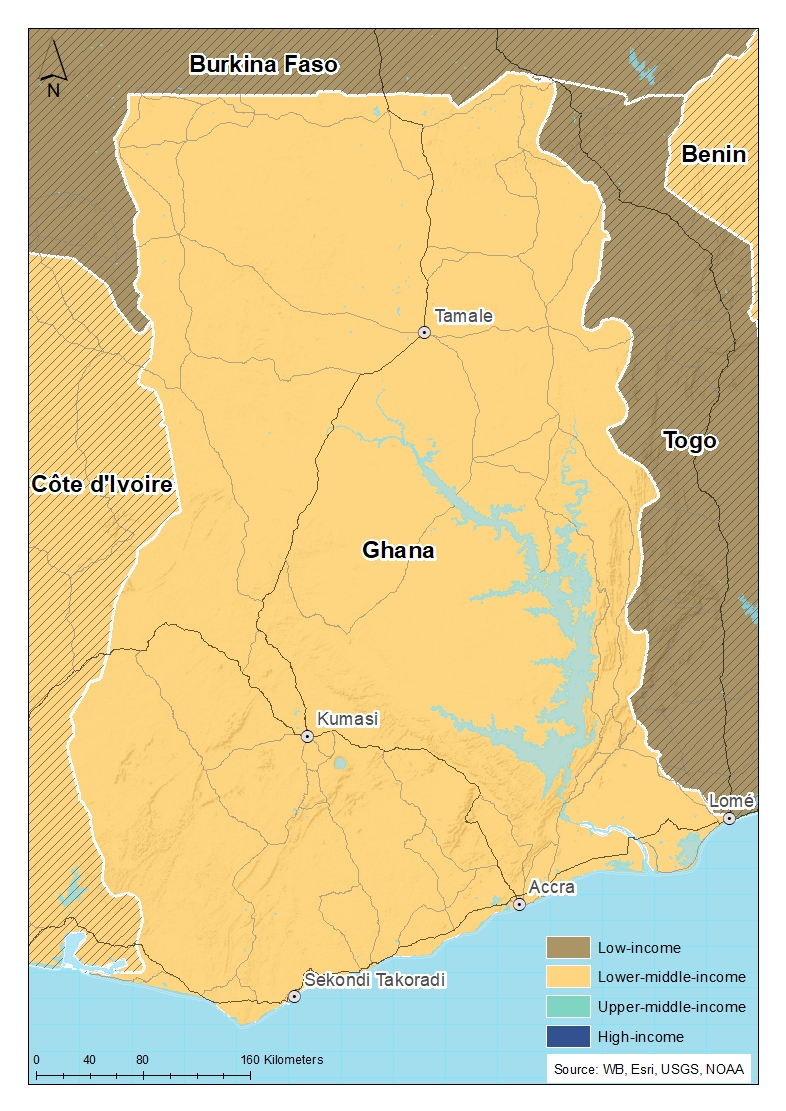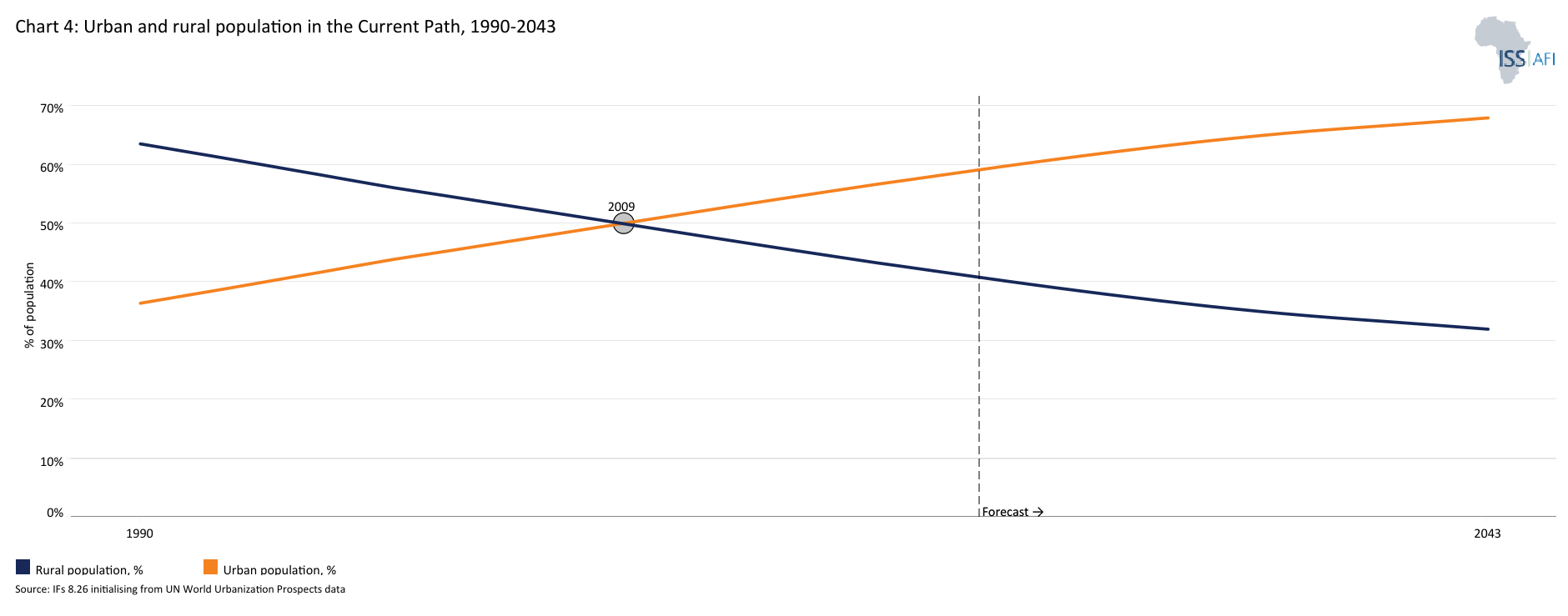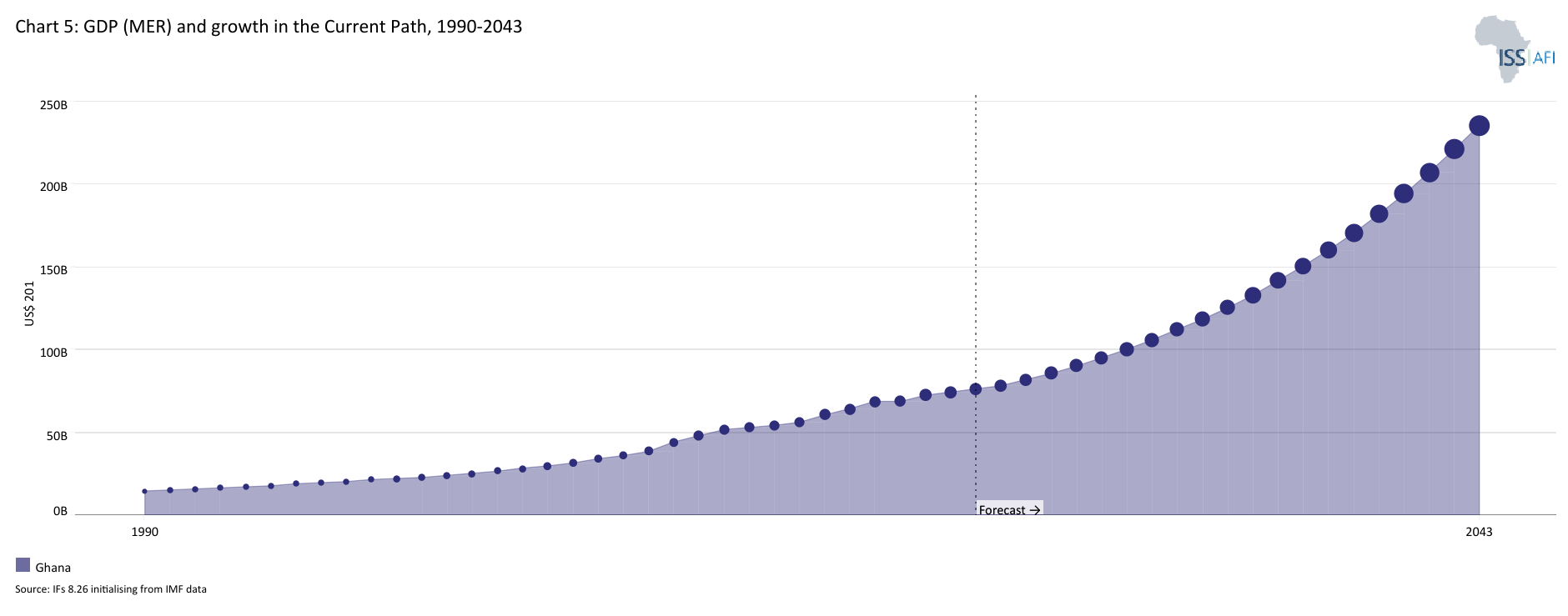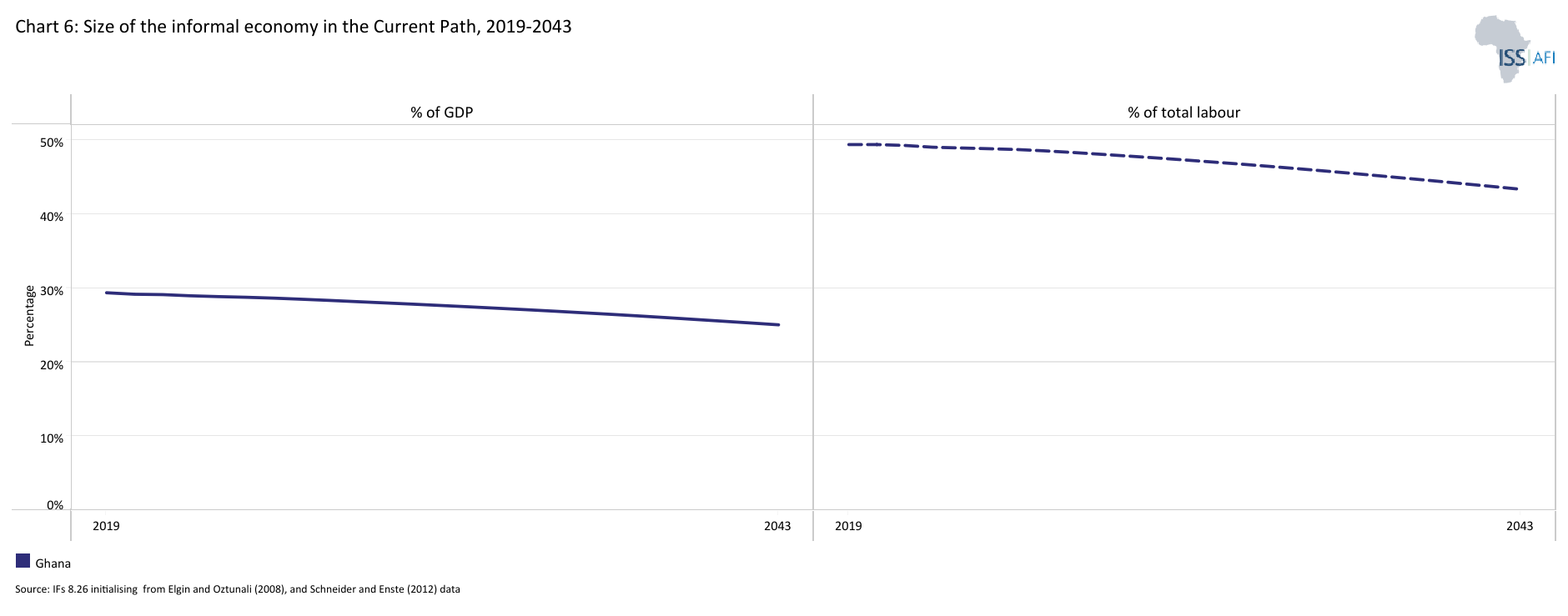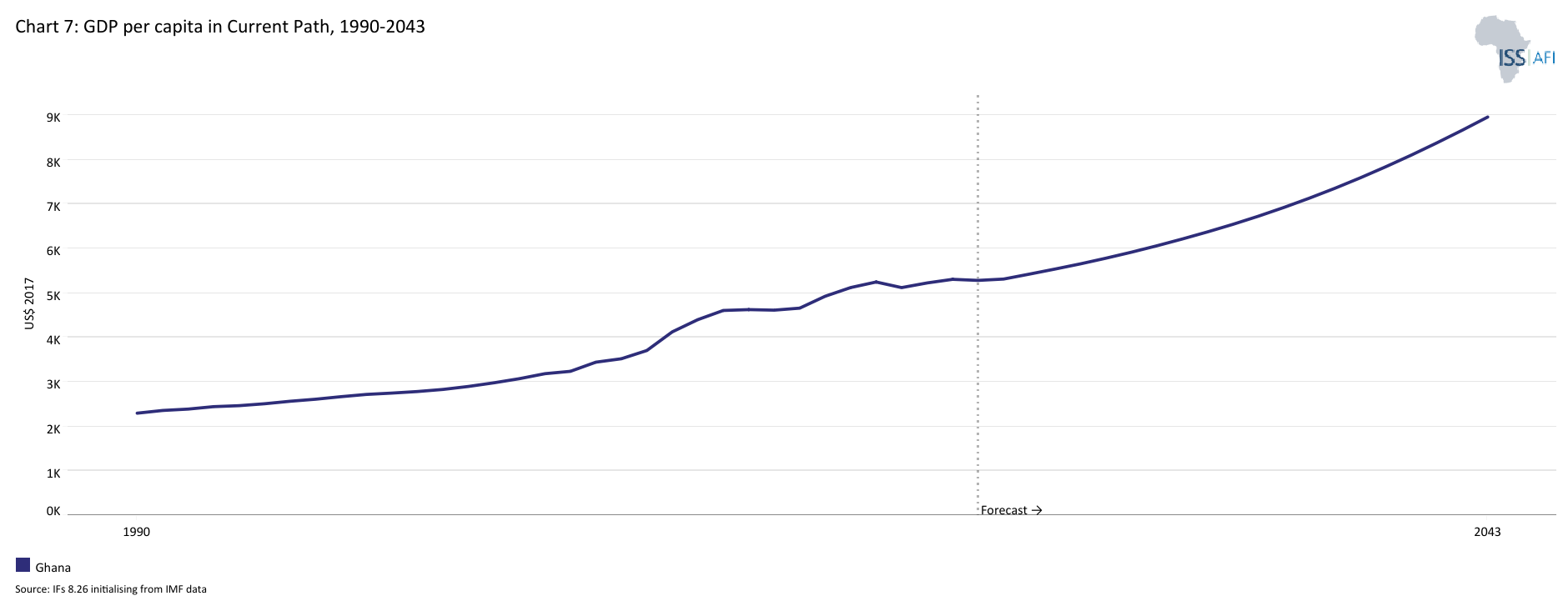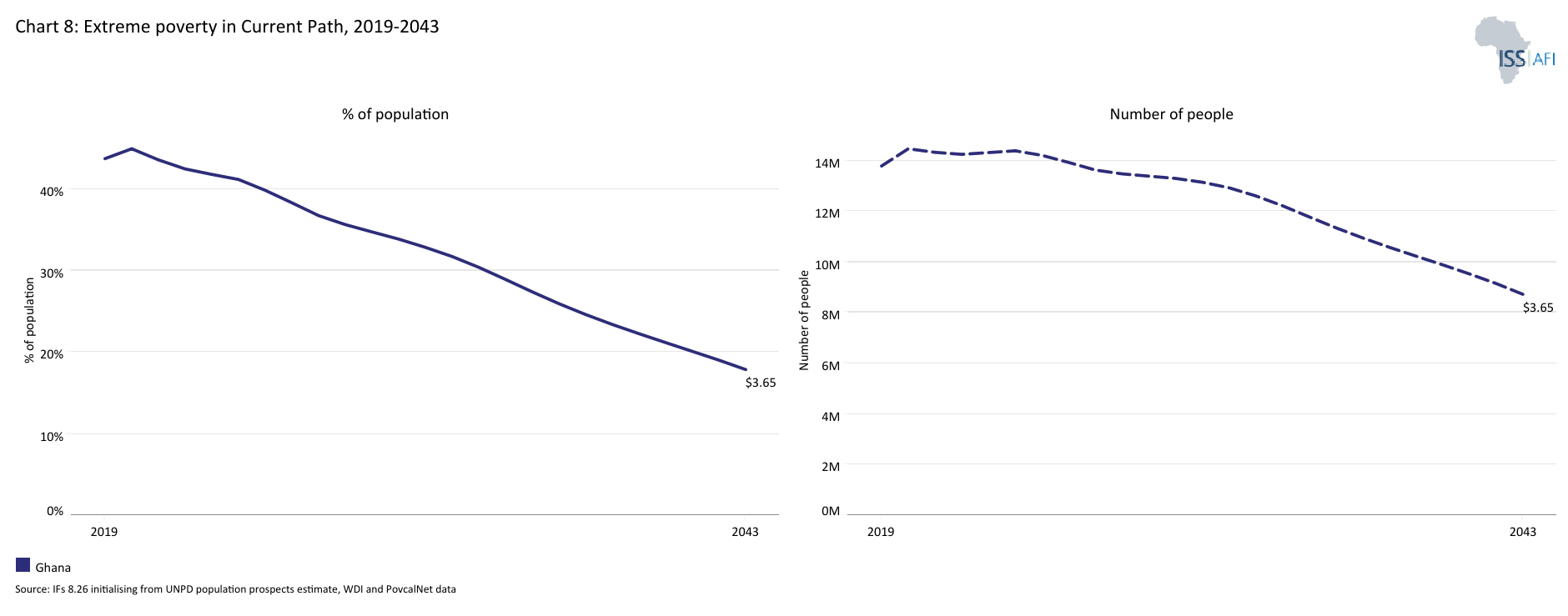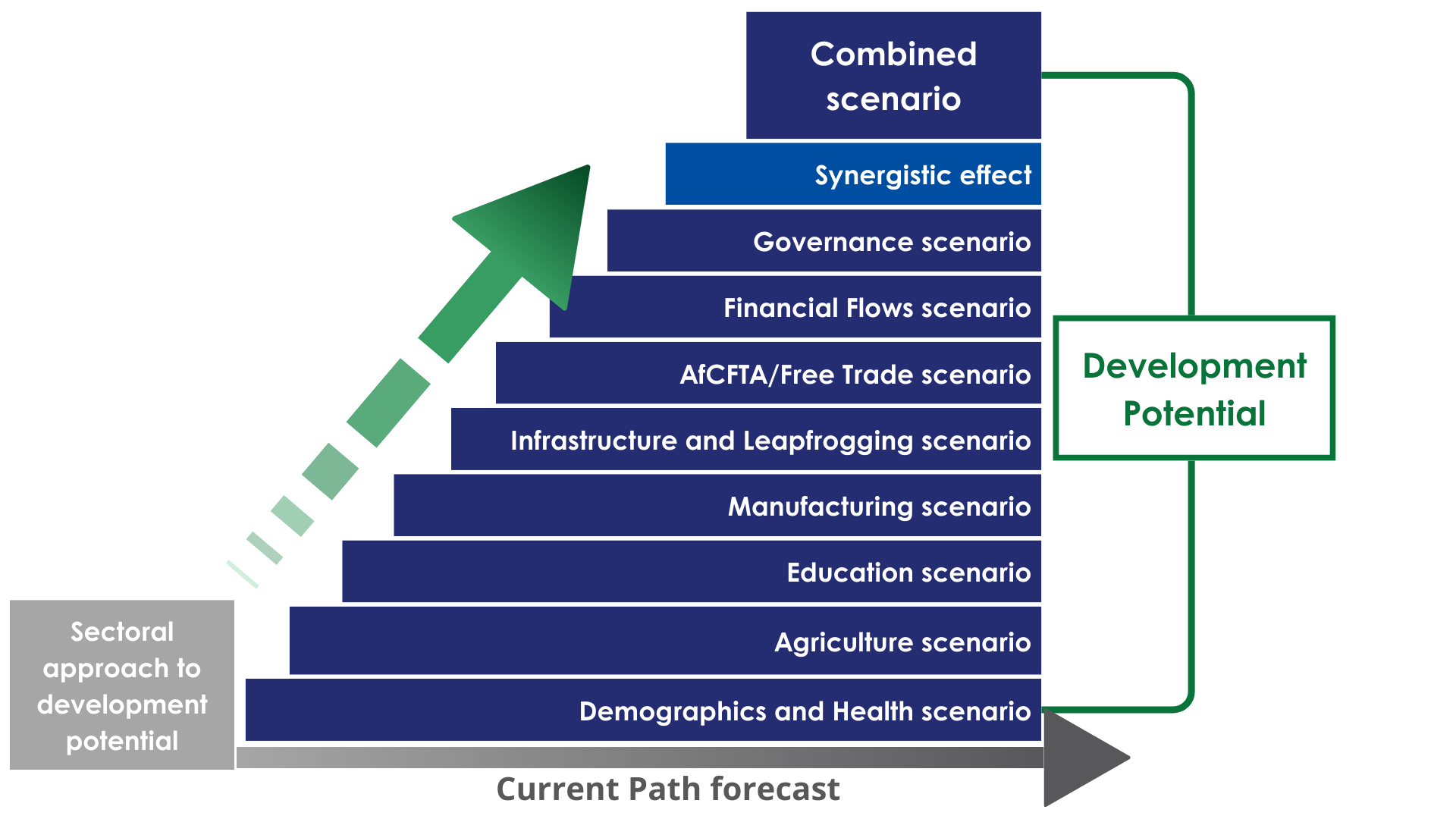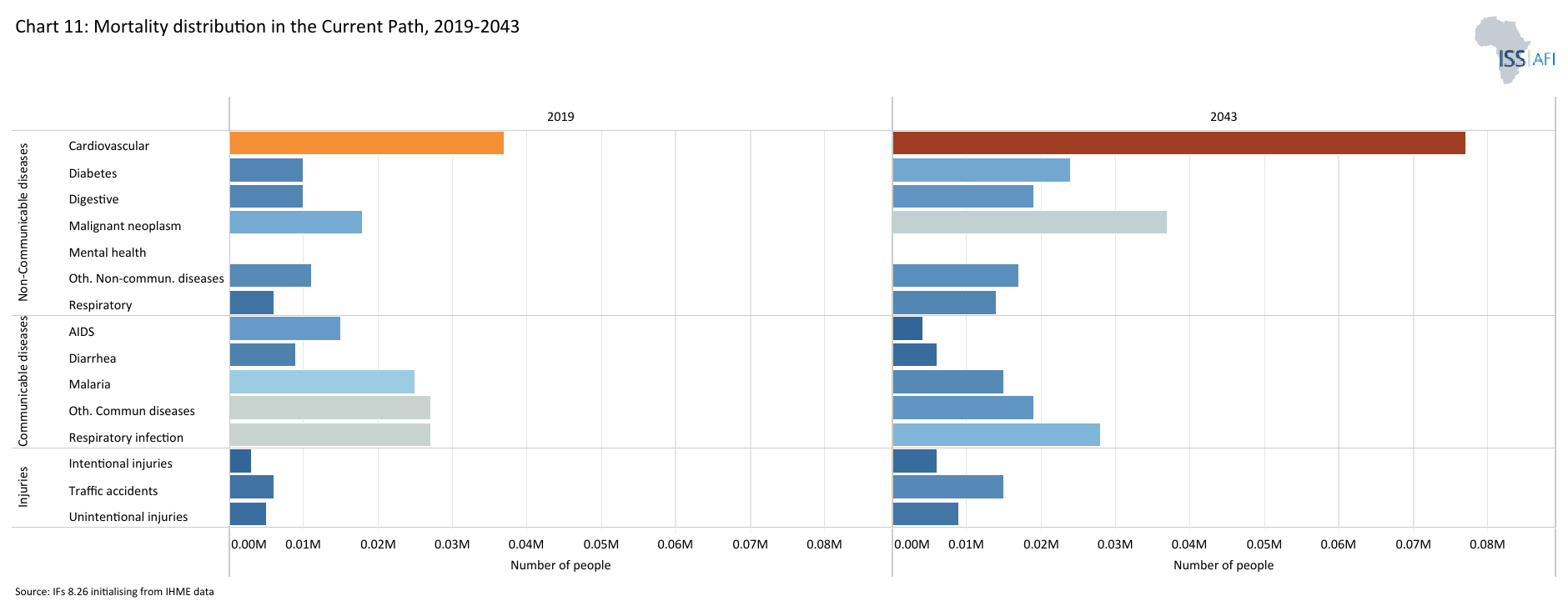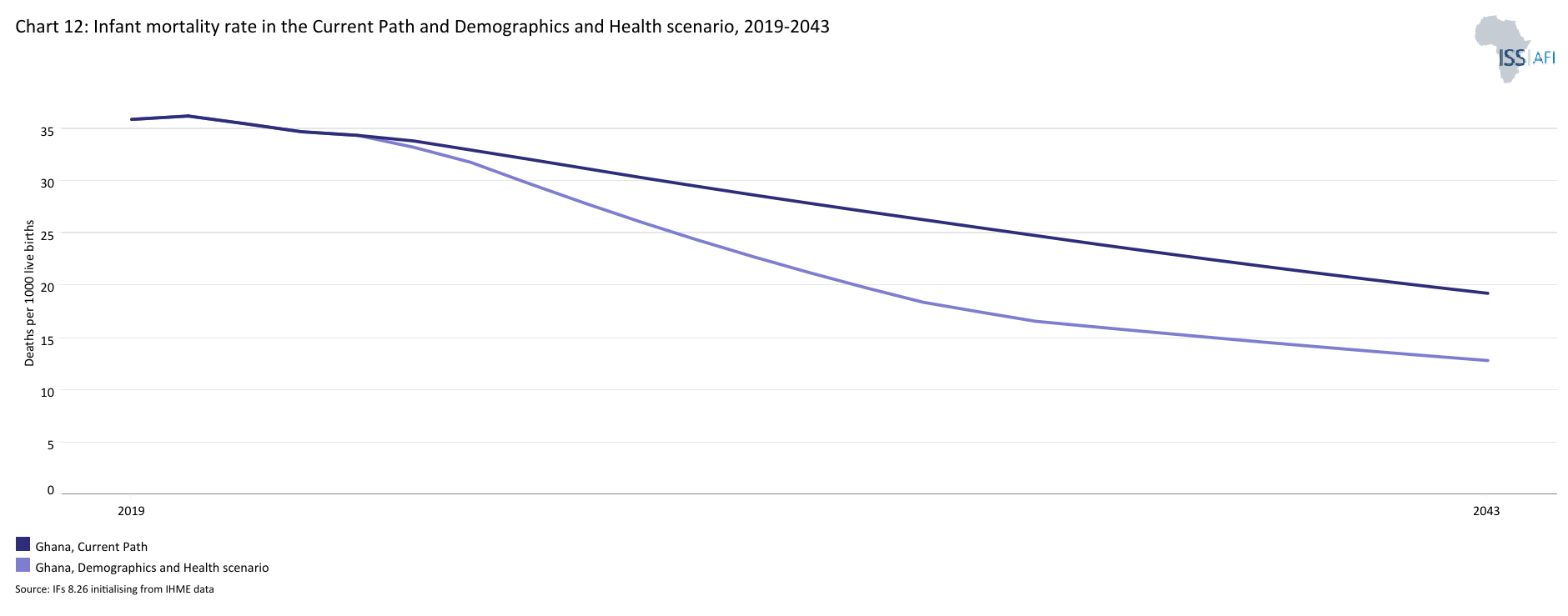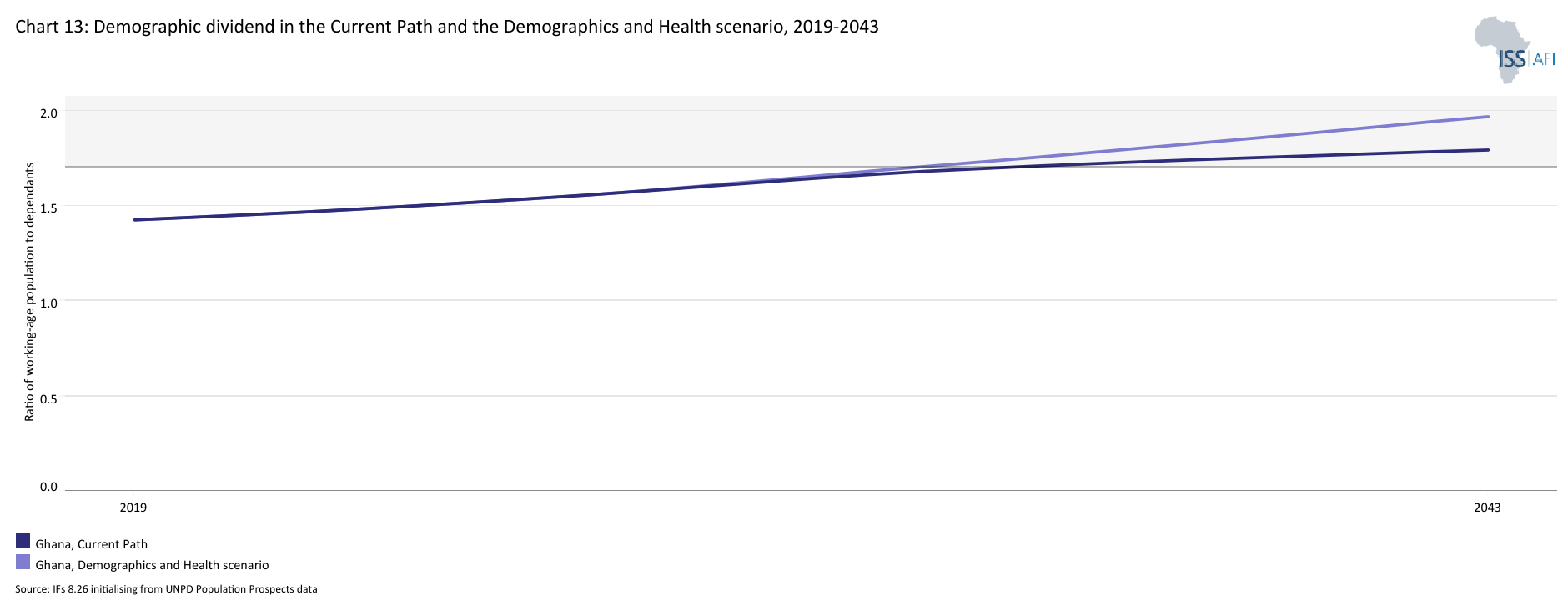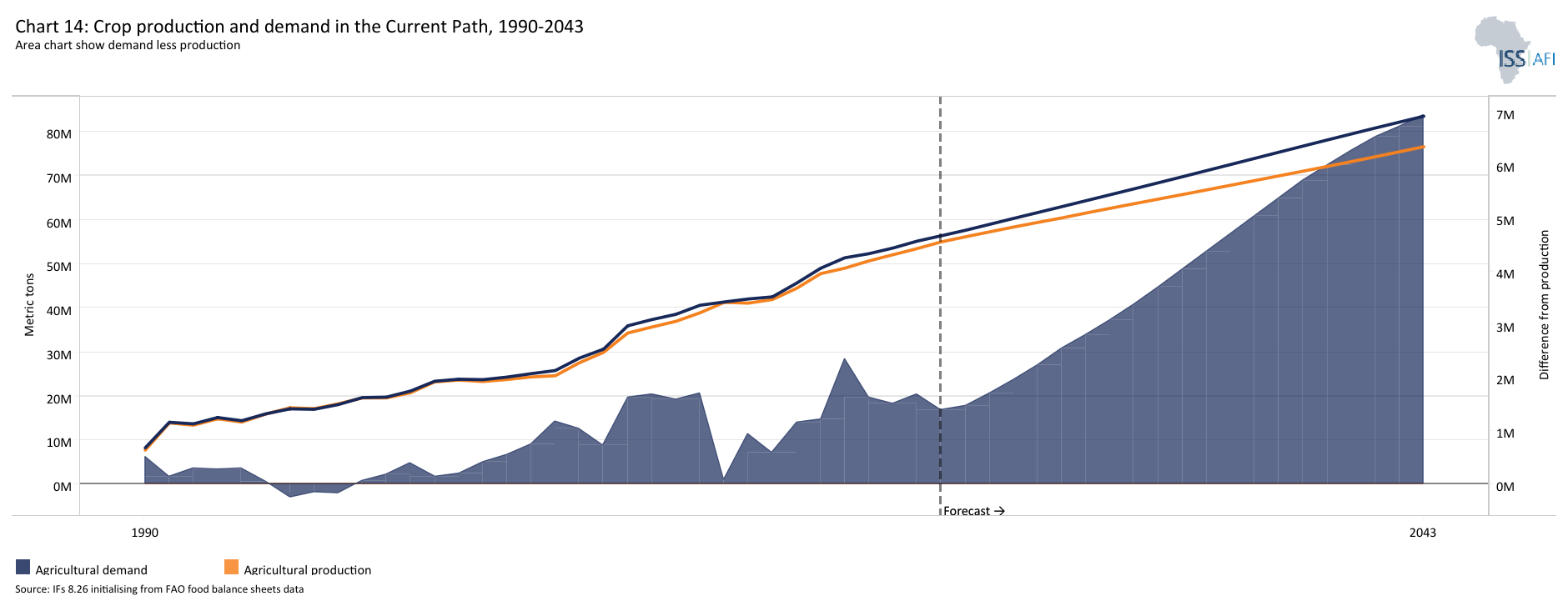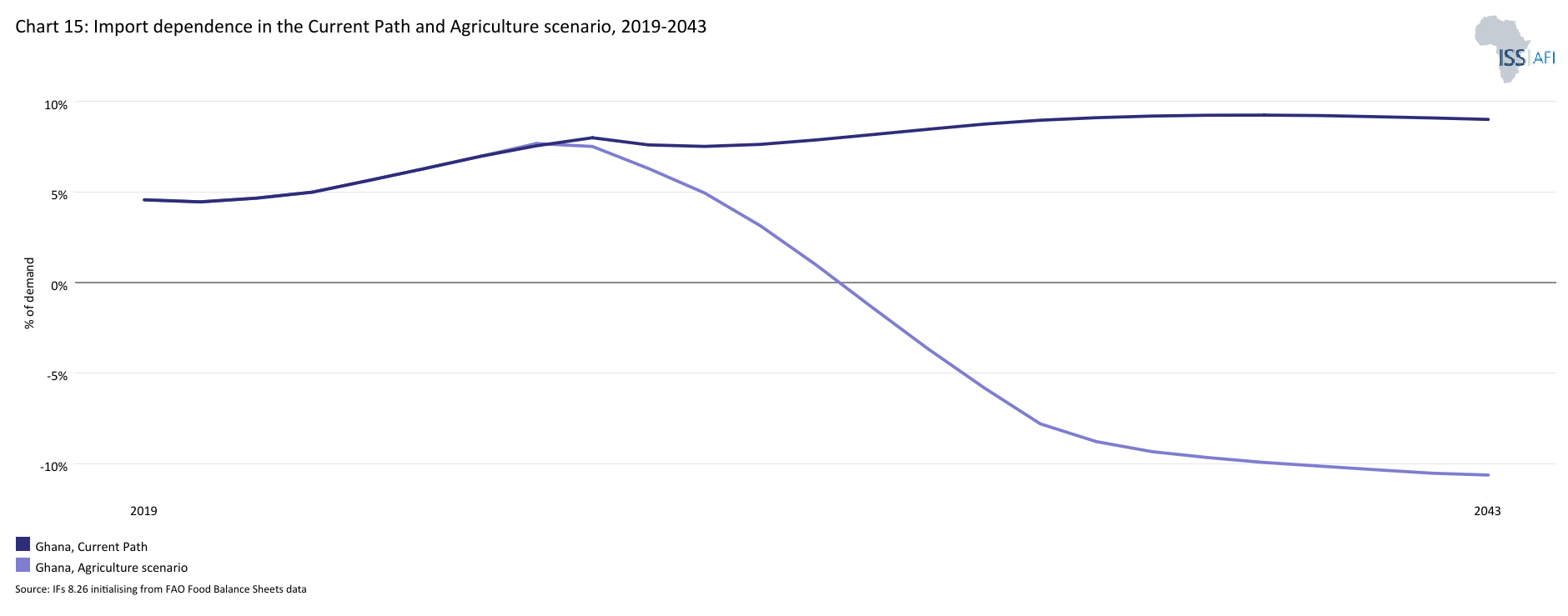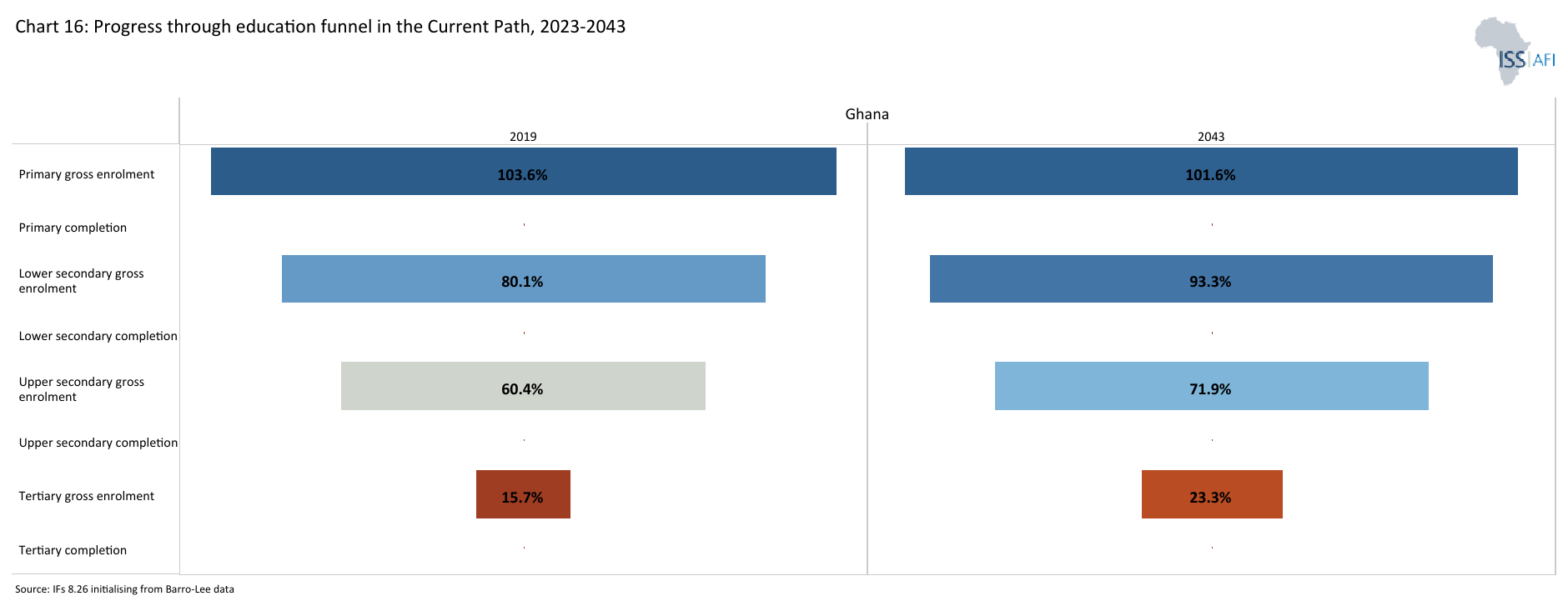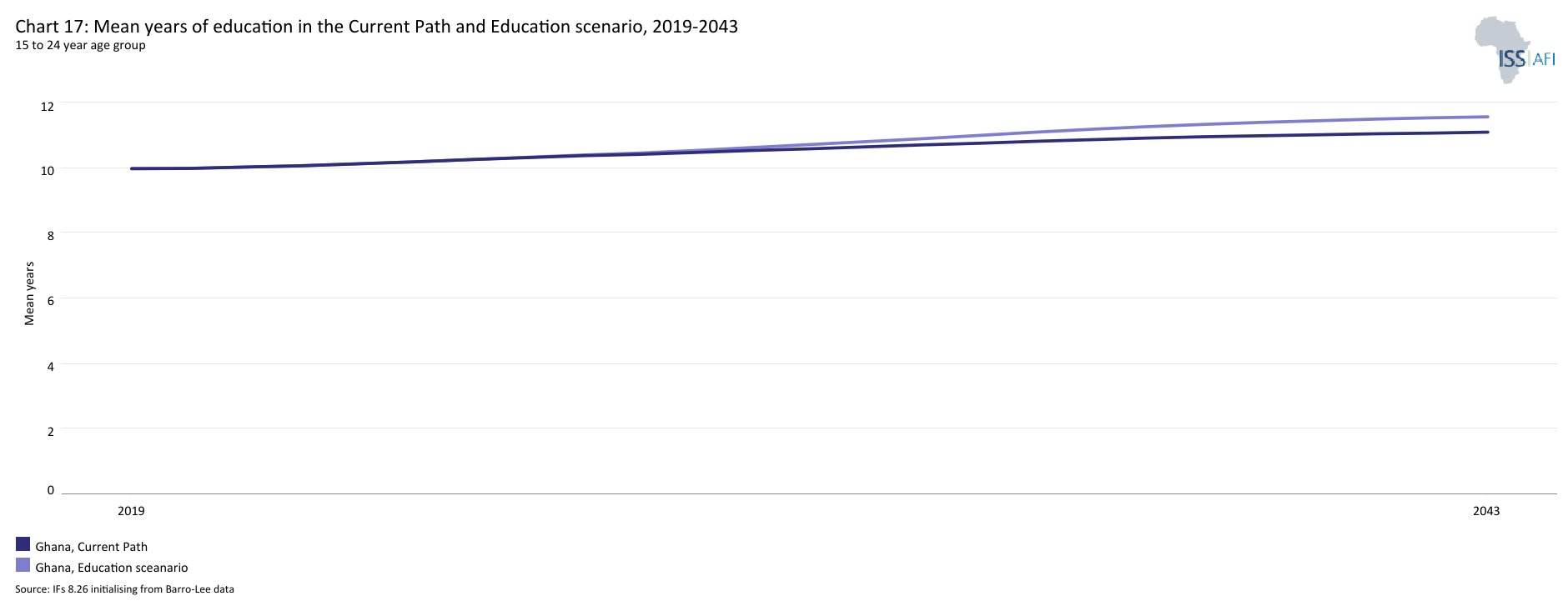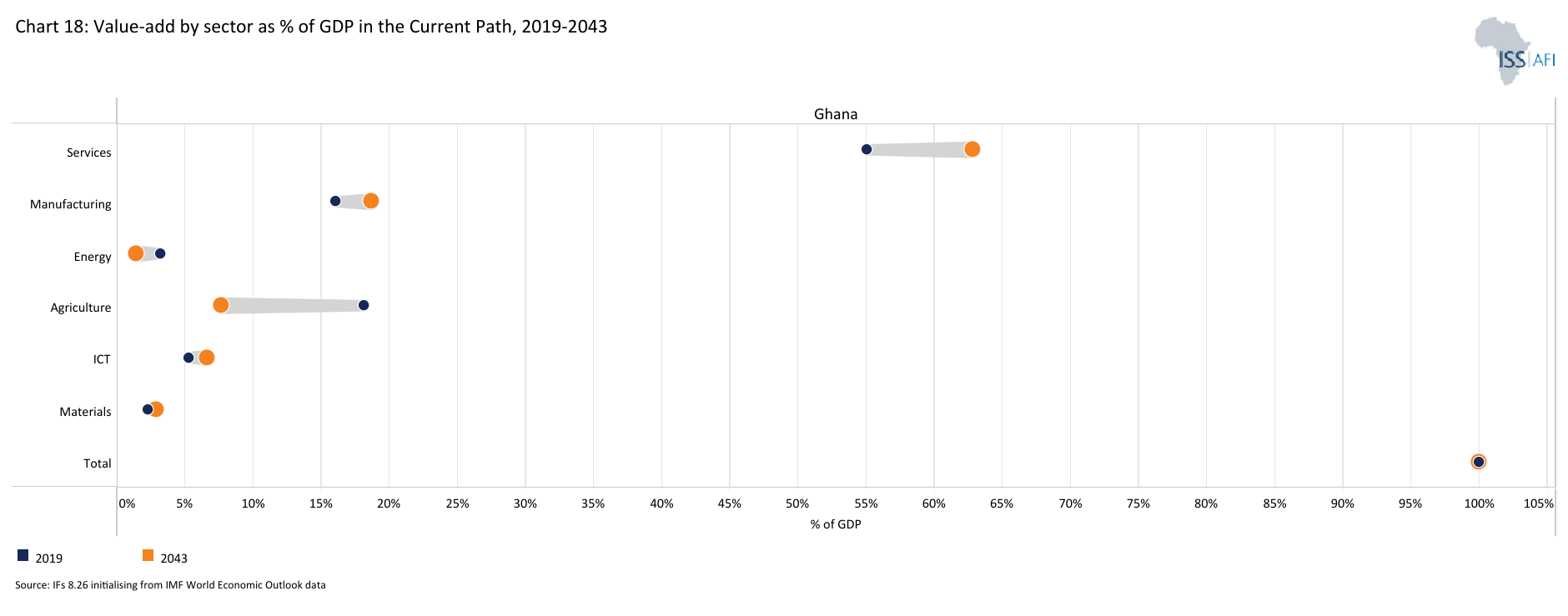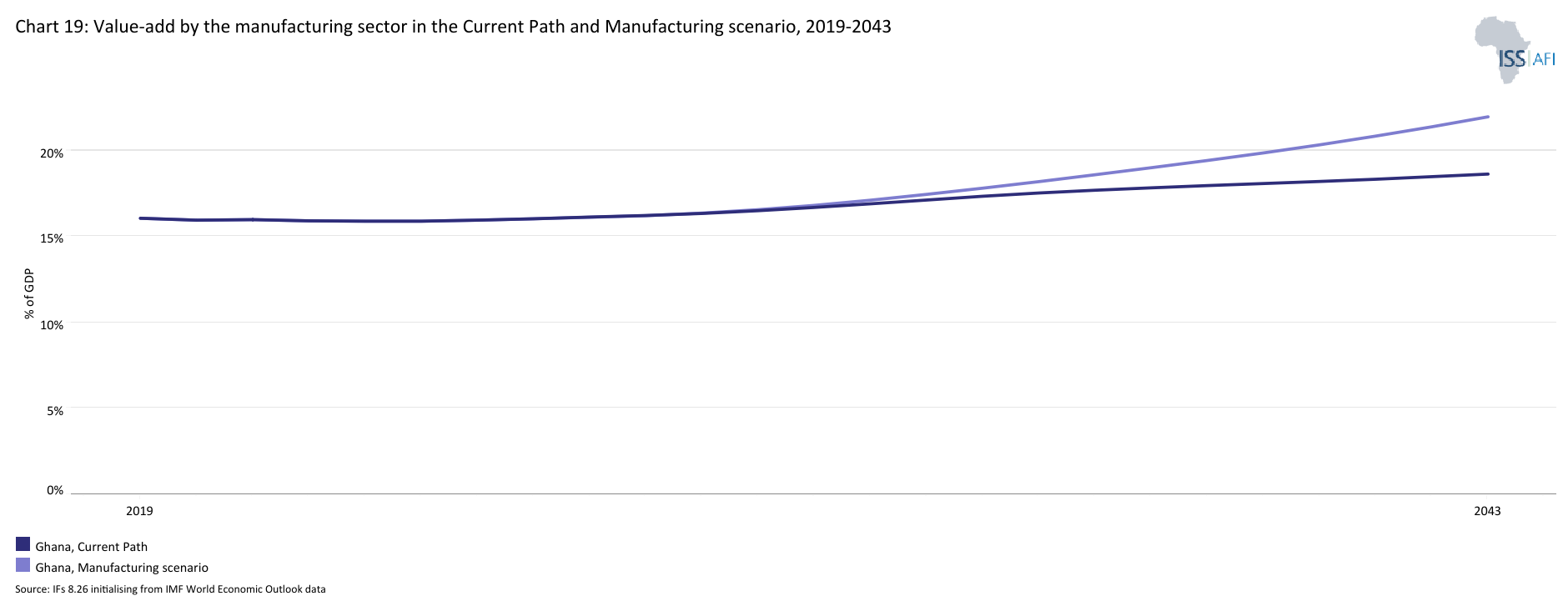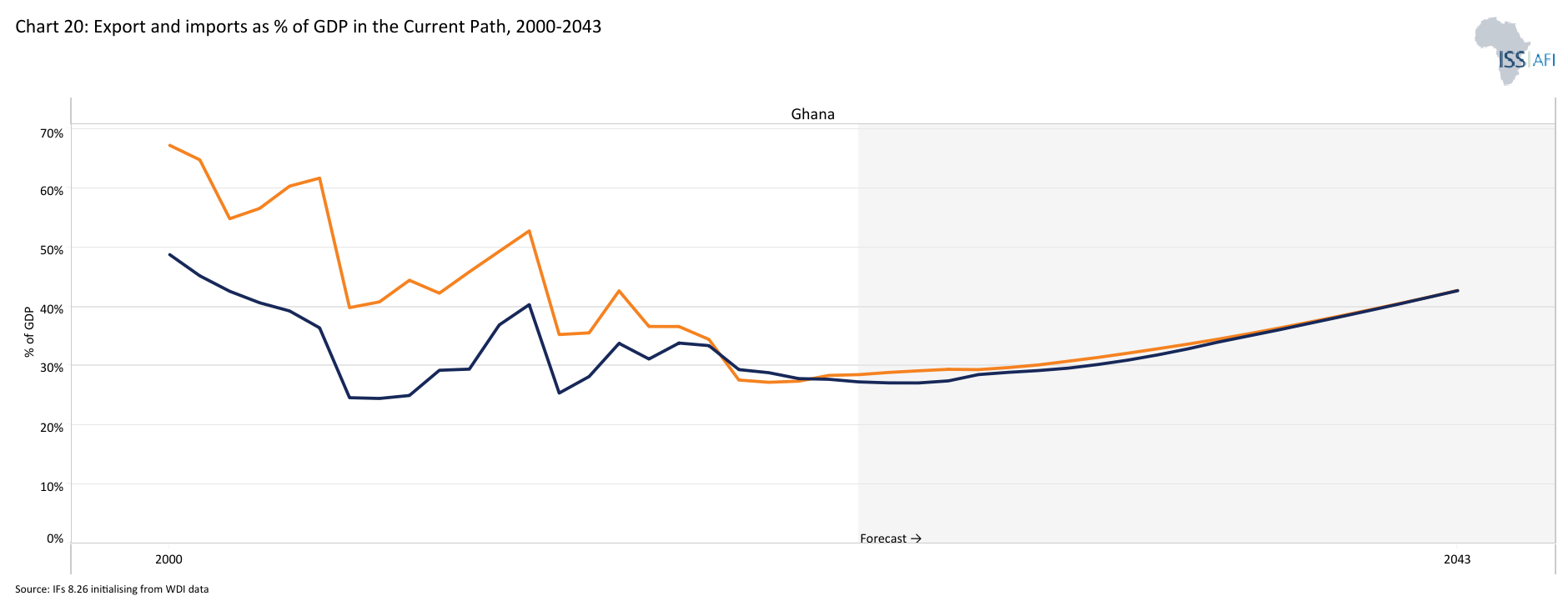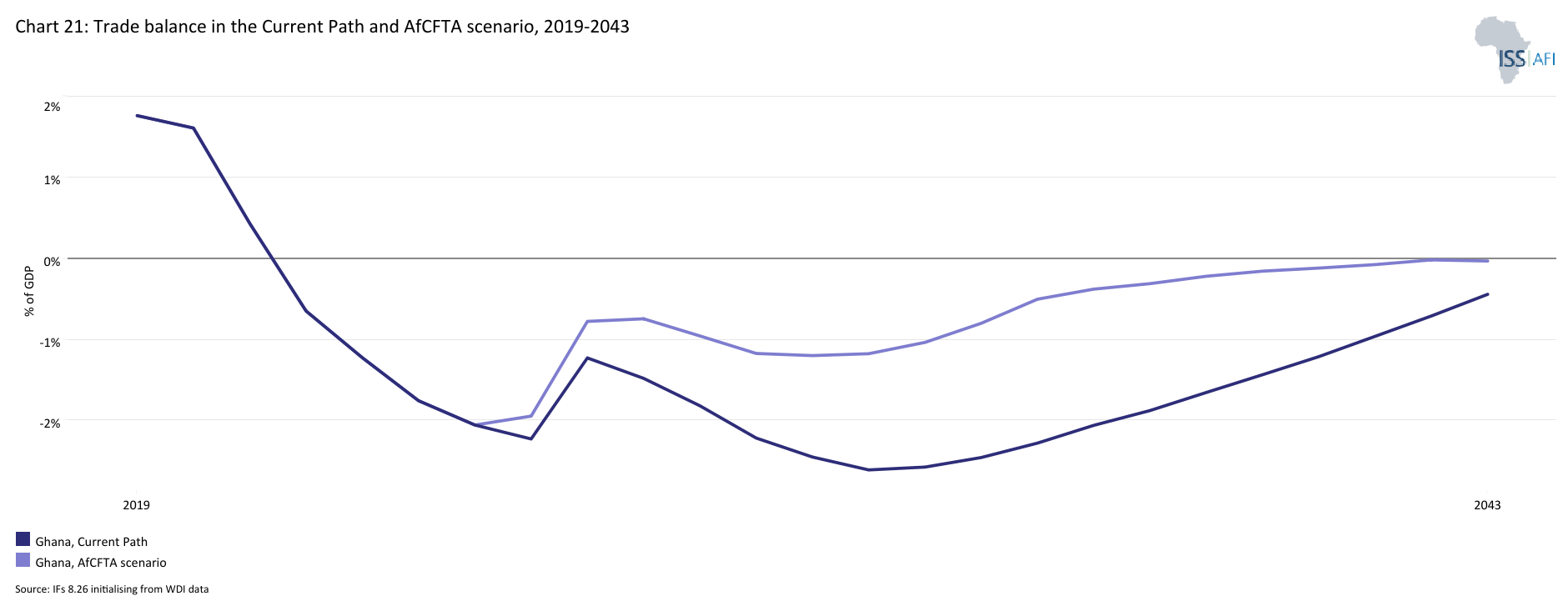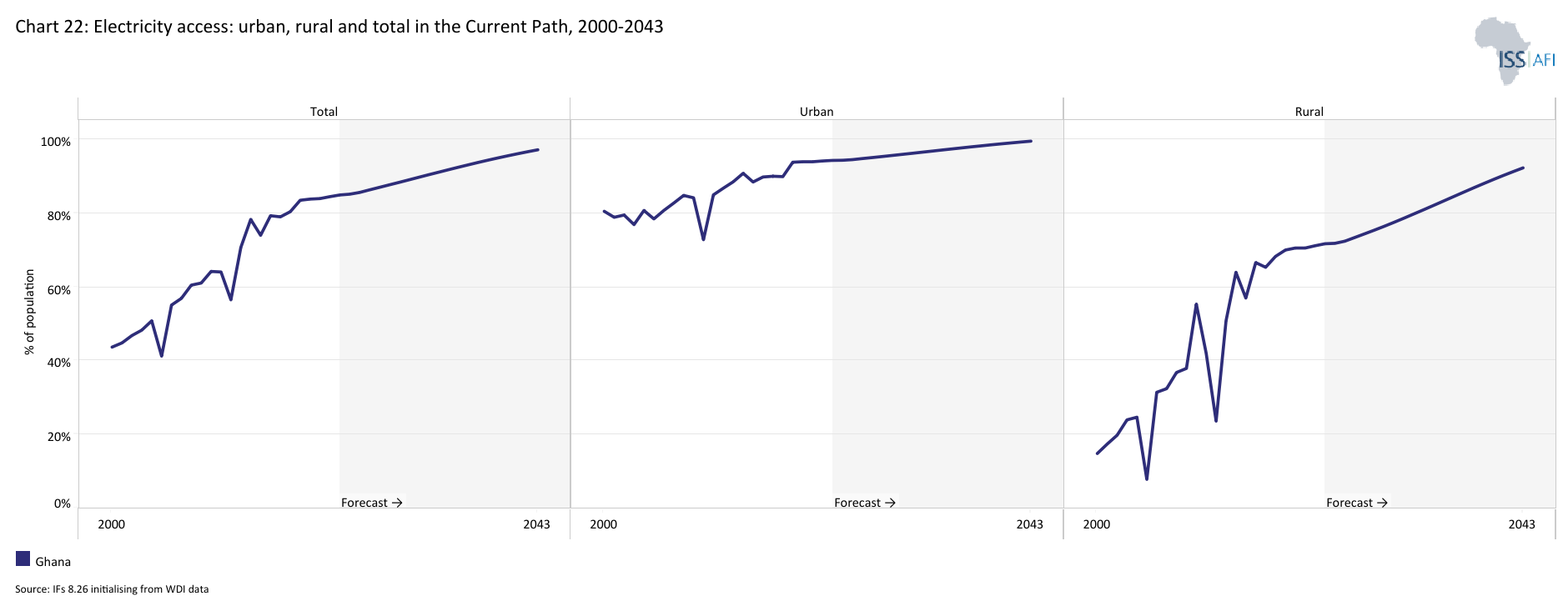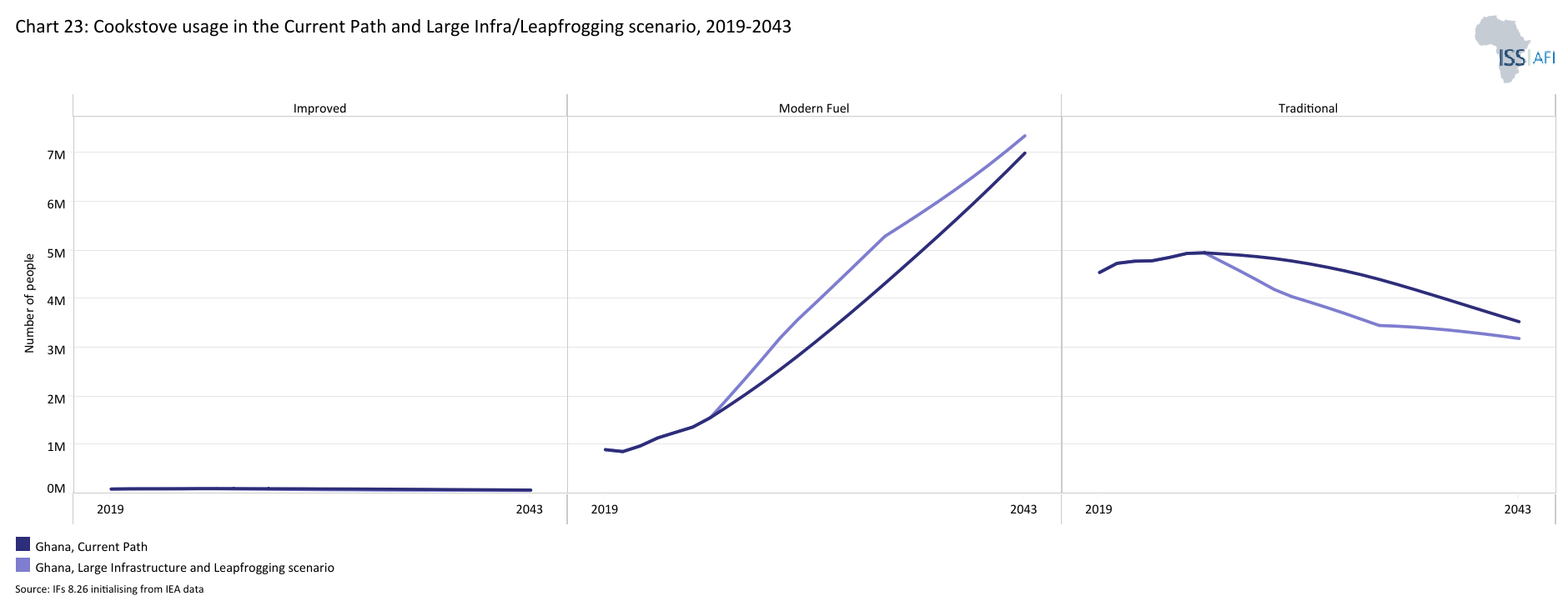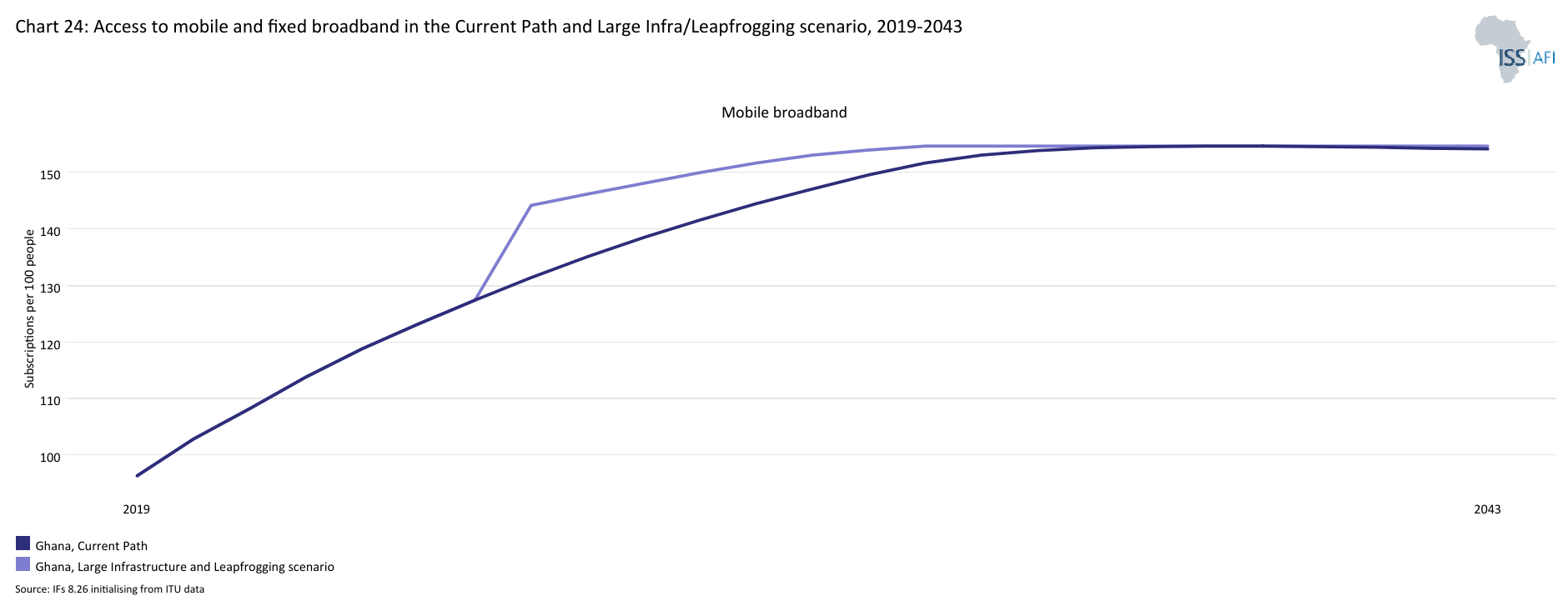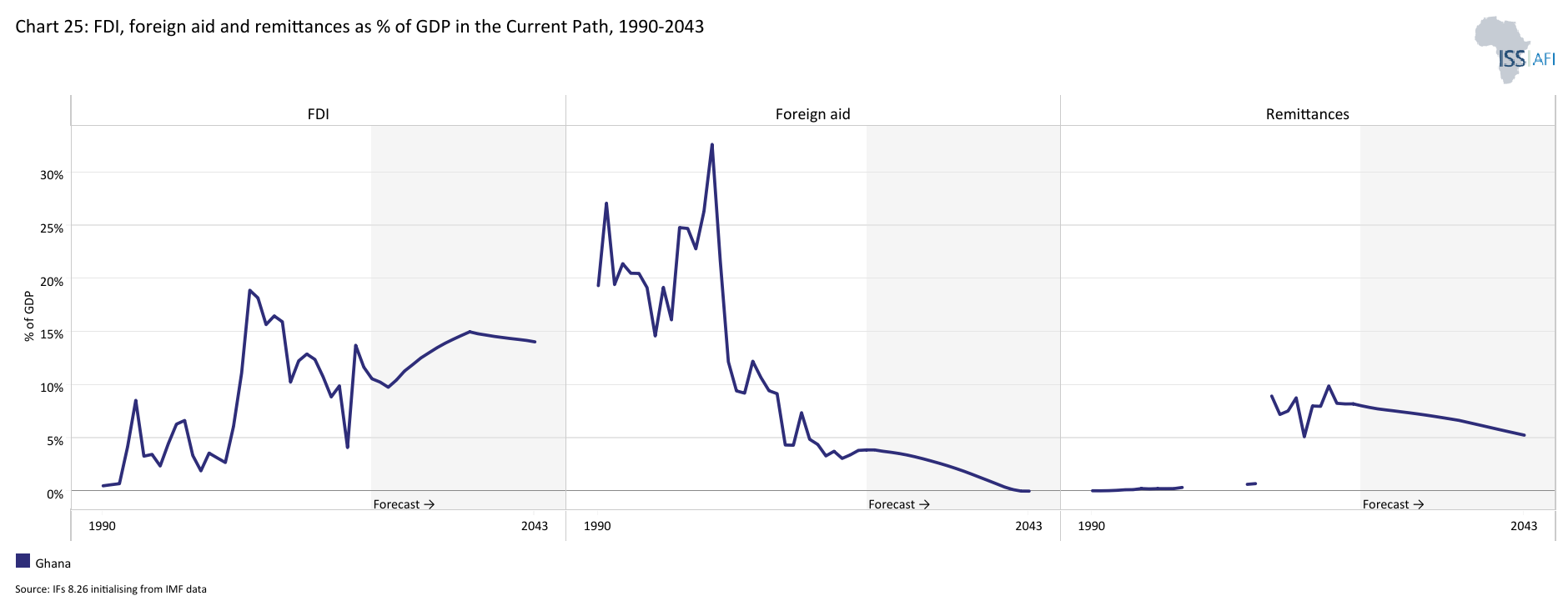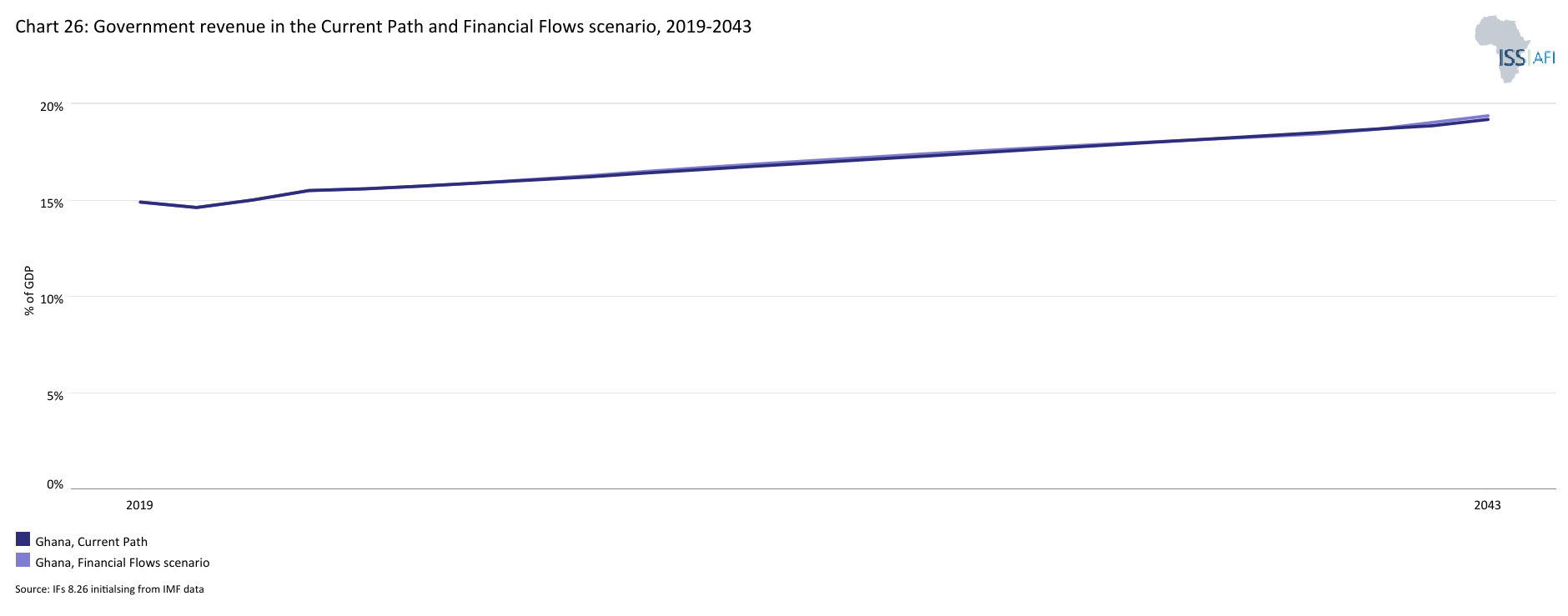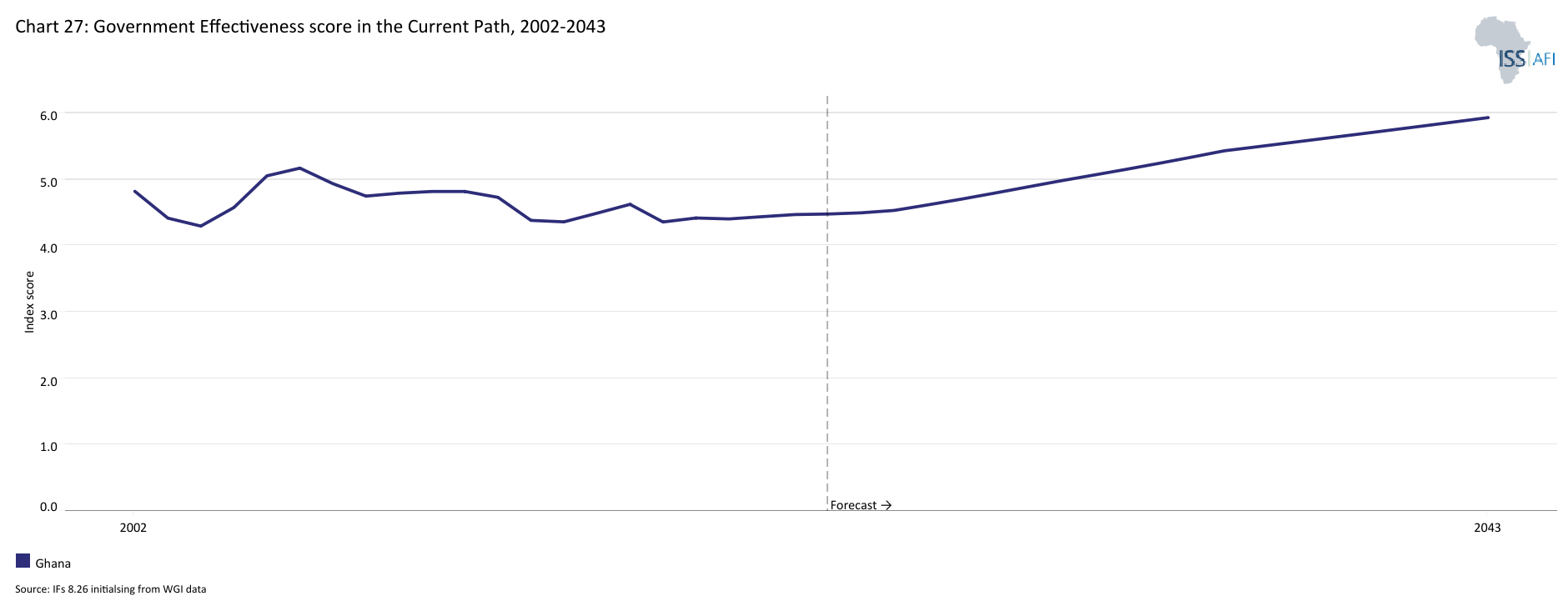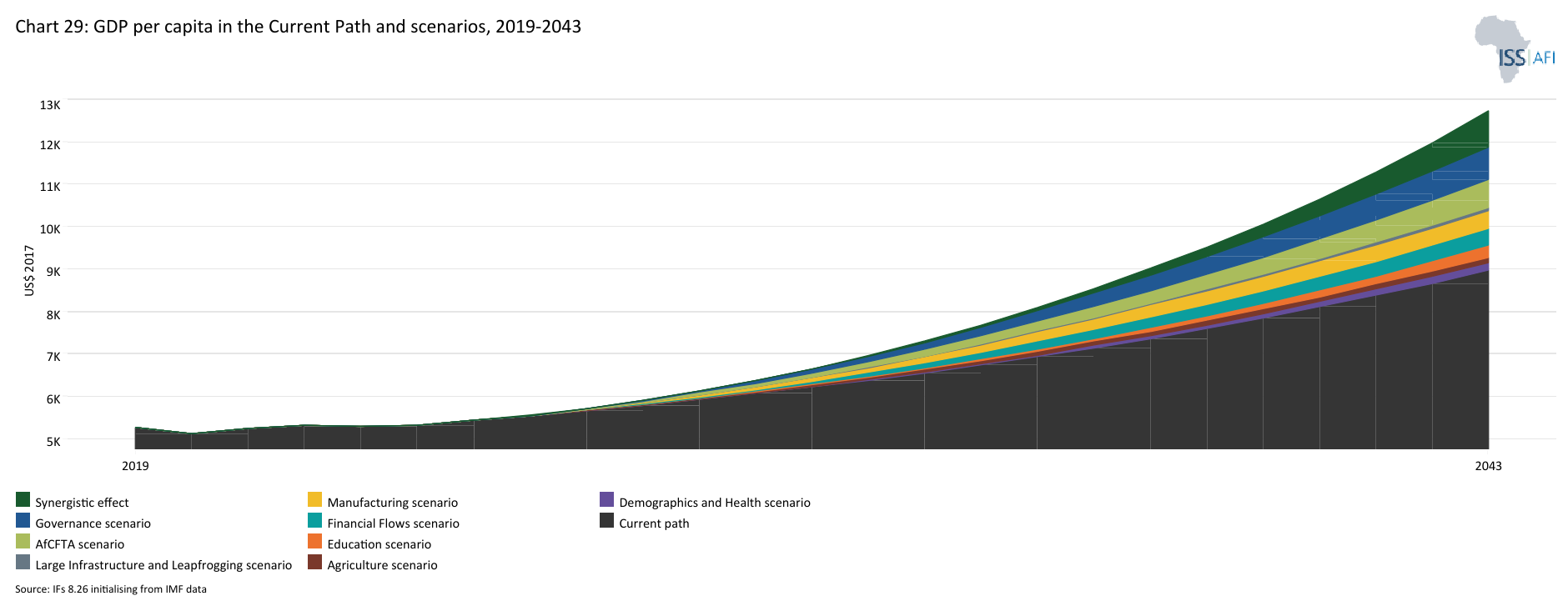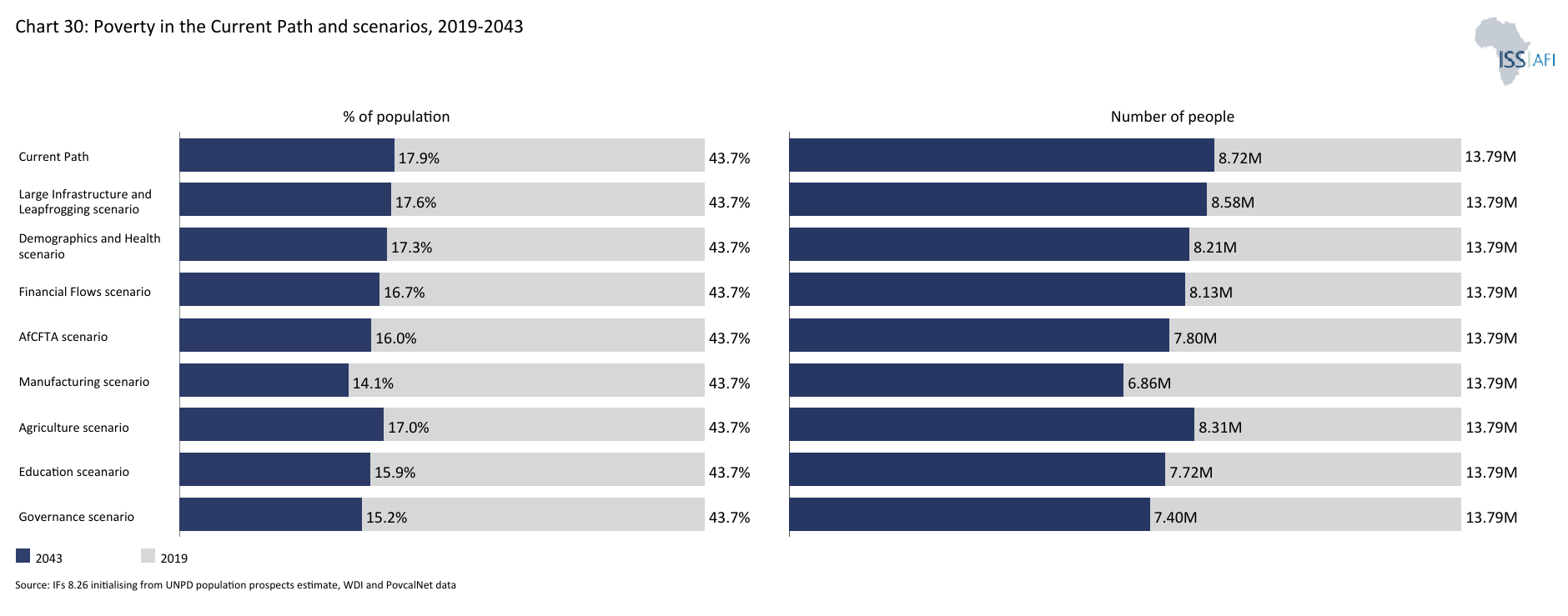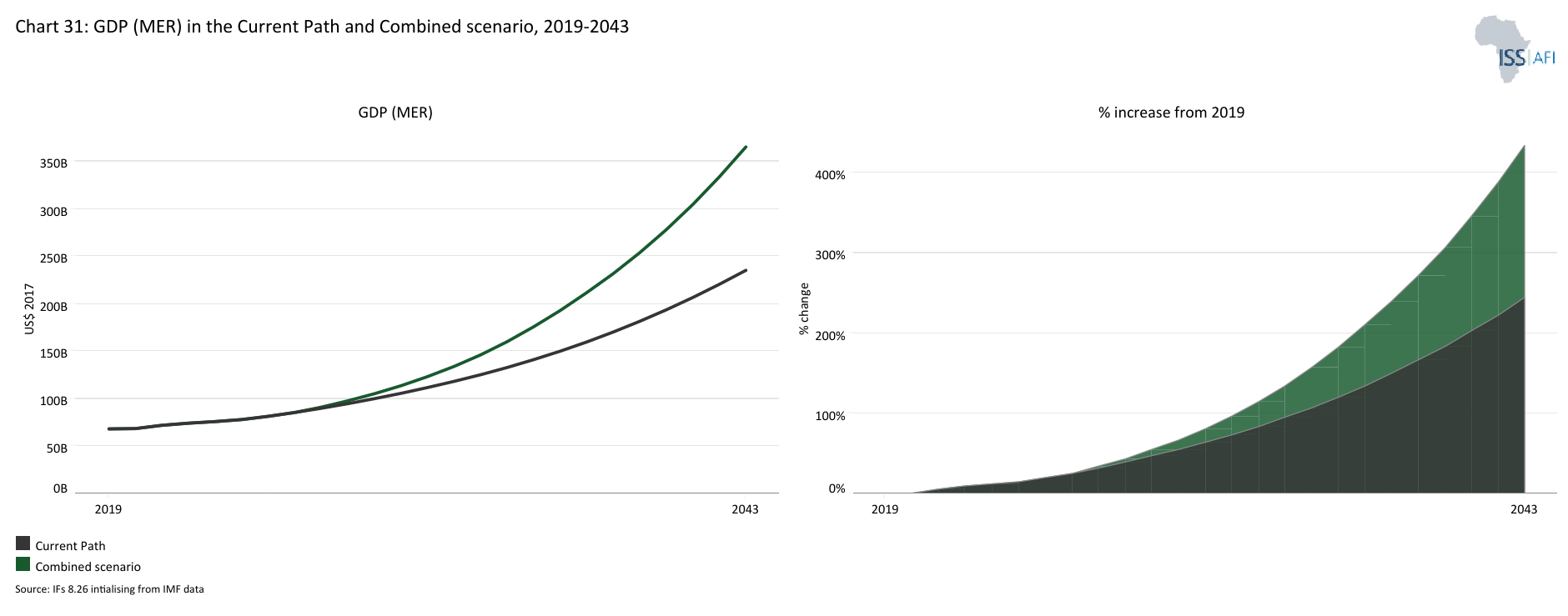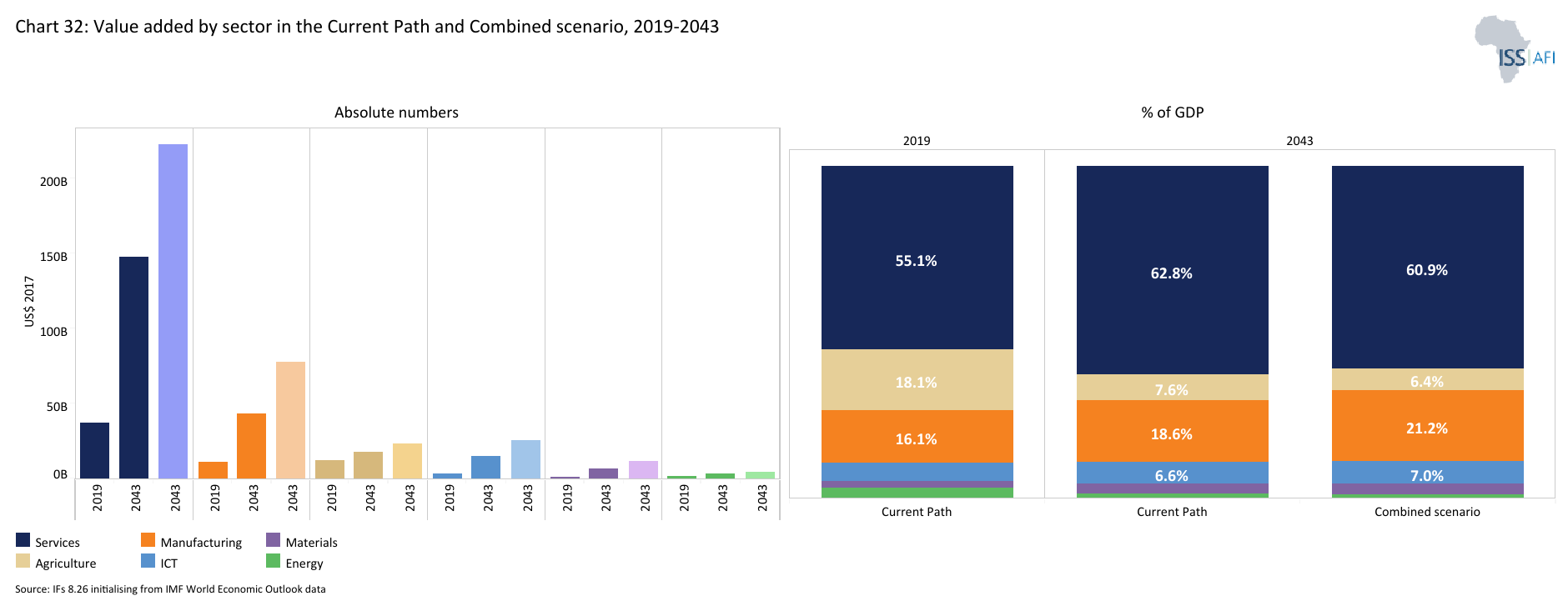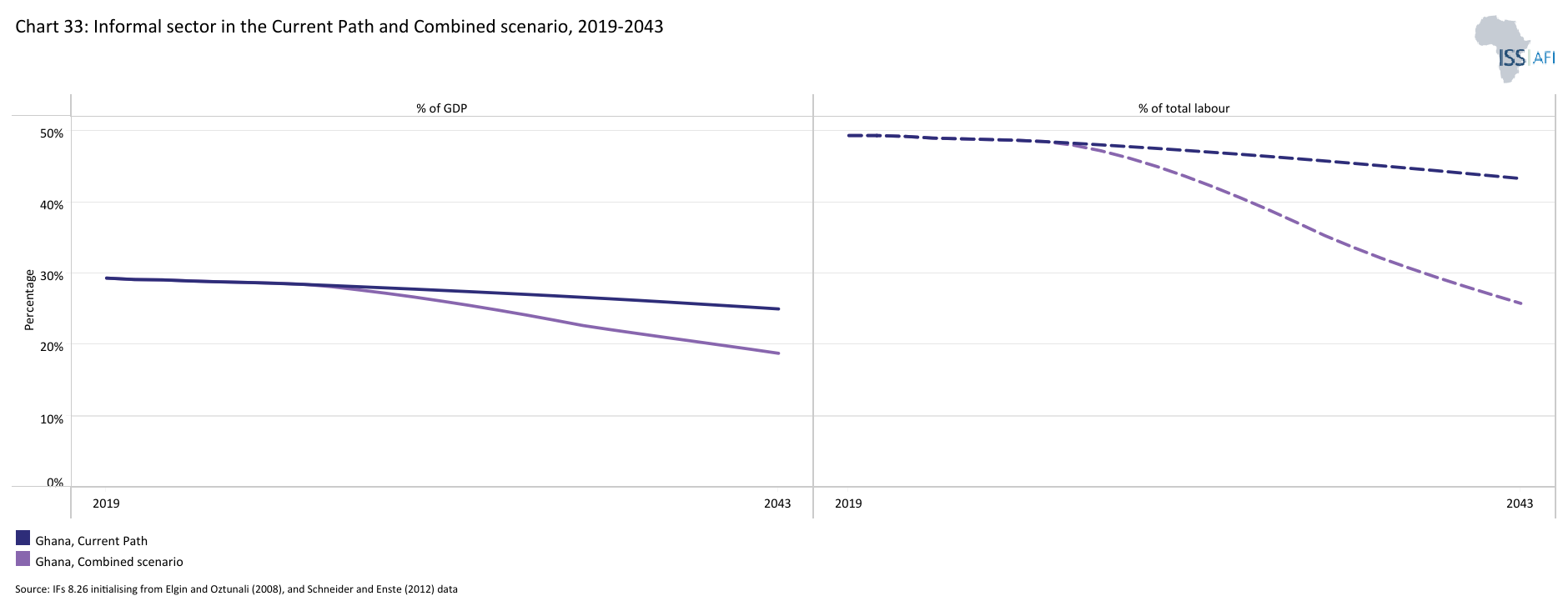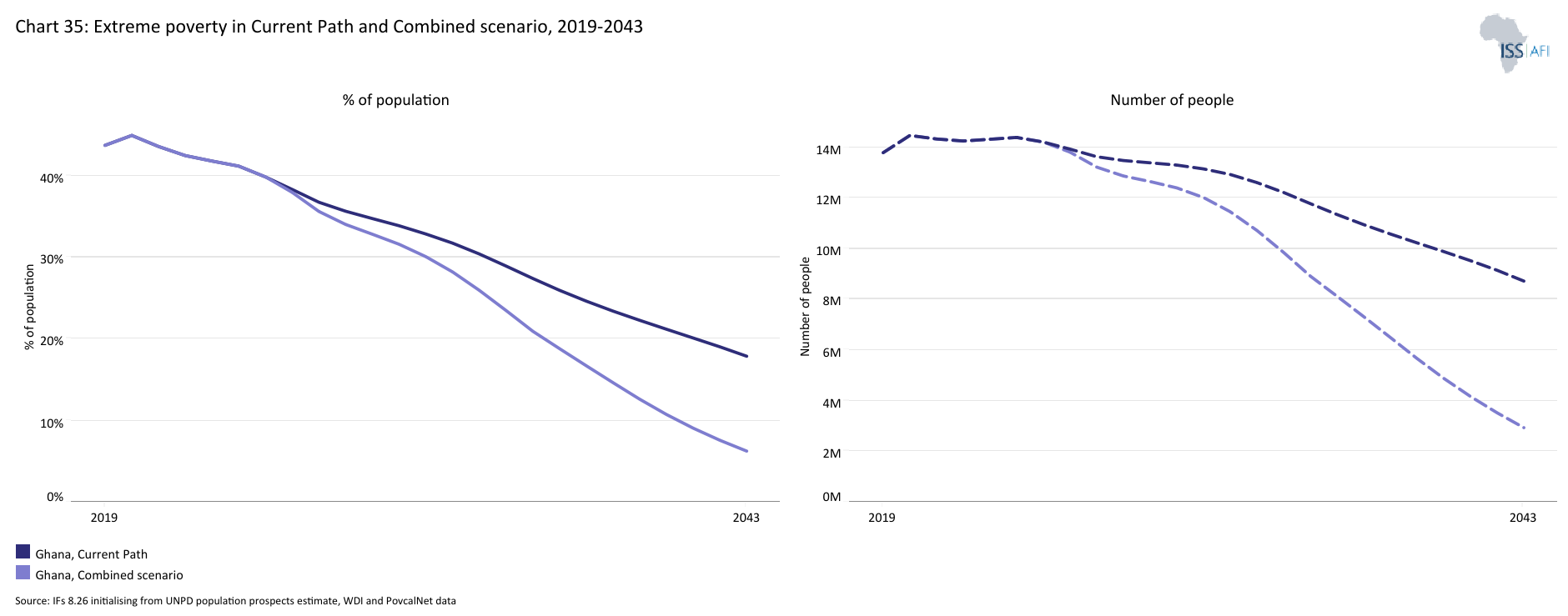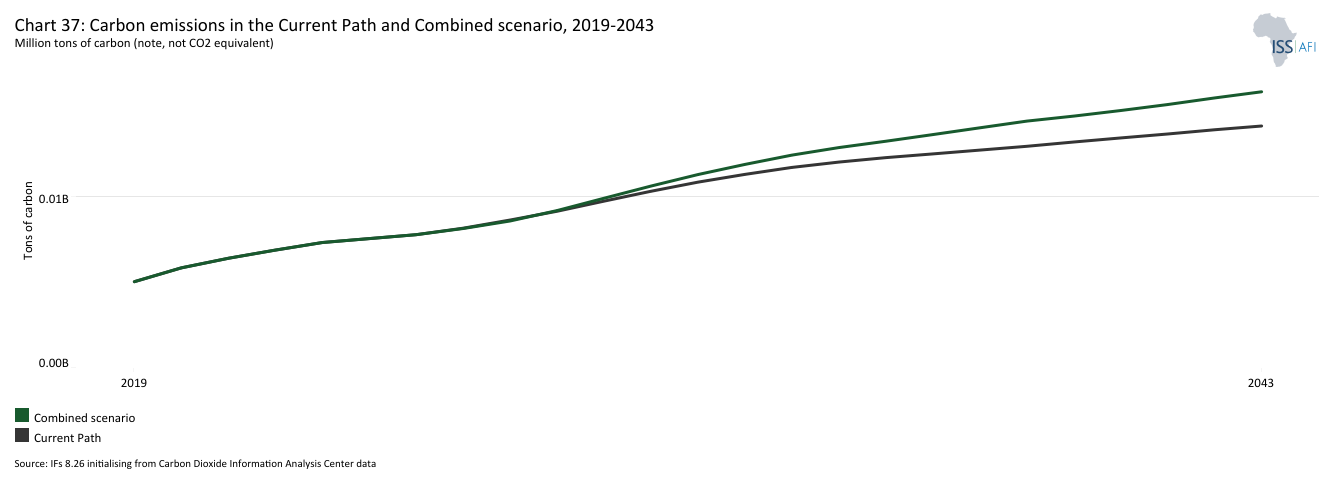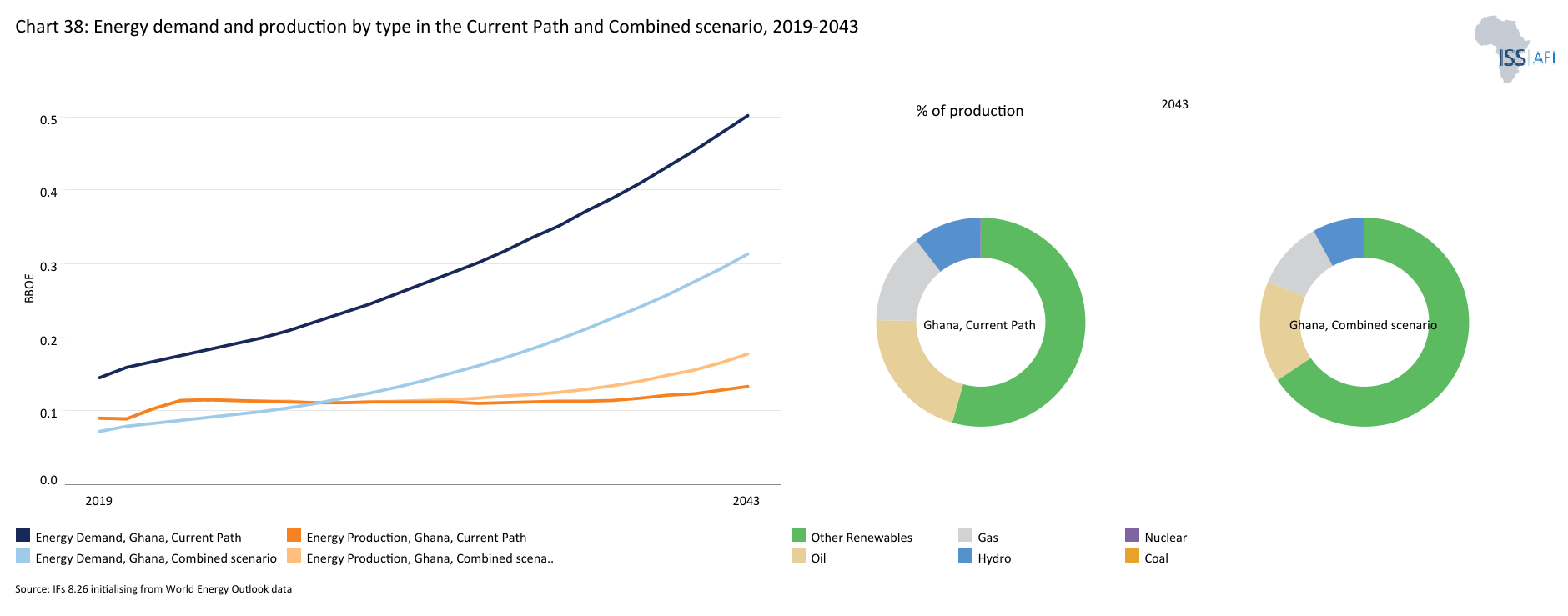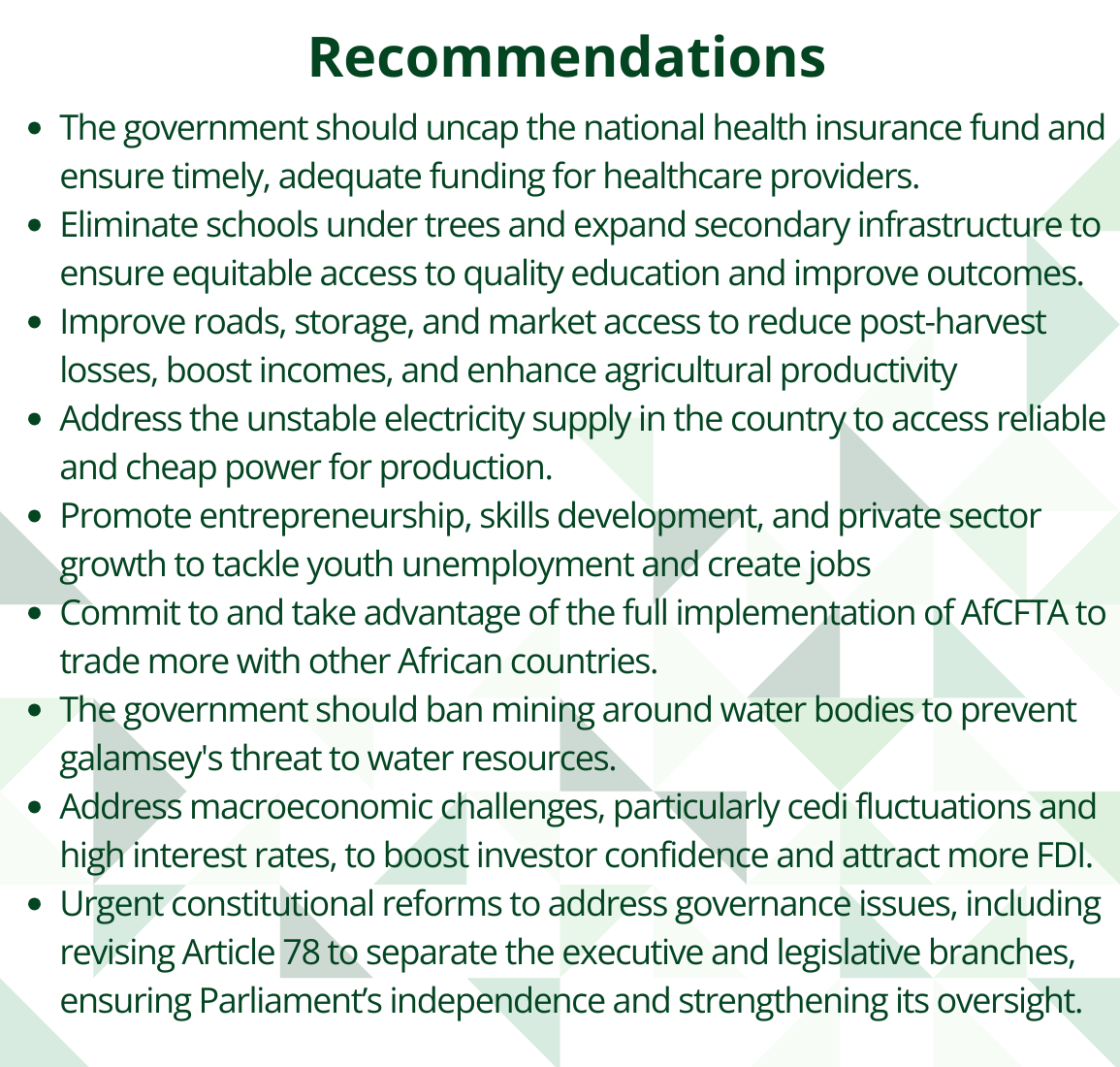 Ghana
Ghana
Feedback welcome
Our aim is to use the best data to inform our analysis. See our Technical page for information on the IFs forecasting platform. We appreciate your help and references for improvements via our feedback form.
This page presents a comprehensive analysis of Ghana. The analysis outlines the nation's extensive socio-economic challenges and opportunities, examining various developmental paths through 2043. It discusses the significant economic growth potential from its rich natural resources while noting the country's persistent issues with poverty, inequality, governance and reliance on commodity export. Various scenarios consider the impacts of improvements in sectors like agriculture, education and manufacturing. The analysis aims to provide policymakers and researchers with insights to guide Ghana towards a more prosperous future.
For more information about the International Futures modelling platform we use to develop the various scenarios, please see About this Site.
Summary
We begin this page with an introduction and context to Ghana.
Ghana is one of the lower-middle-income countries in Africa. It is located in West Africa along the Gulf of Guinea, bordering Burkina Faso in the north, Côte d’Ivoire in the west and Togo in the east, all of which are members of the Economic Community of West African States (ECOWAS). The national capital, Accra, is located in the Greater Accra Region of southern Ghana. The country has a total area of 238 535 km² and a tropical climate with two major seasons consisting of a rainy season and a dry season. Ghana is divided into six ecological zones, namely: Sudan savannah, Guinea savannah, Coastal savannah, forest/savannah transitional zone, deciduous forest zone, and the rain forest zone. Jump to Chart 1
The introductory section is followed by an analysis of the Current Path for Ghana which informs the region’s likely current development trajectory to 2043, mostly comparing Ghana with its income peers in Africa. It is based on current geopolitical trends and assumes that no major shocks would occur in a ‘business as usual’ future.
- Ghana is the second most populous country in West Africa after Nigeria and the 13th most populous country in Africa. The total population increased from 15.5 million in 1990 to 34.3 million in 2023 and by 2043, it will be 48.8 million. In terms of population structure, 36.5% of Ghanaians were under the age of 15, 59.7% were in the 15–64 age group (working age), and 3.8% were 65 years and older. Jump to Chart 2
- The country’s GDP, measured in market exchange rates (MER), grew from US$14.4 billion in 1990 to US$76.1 billion in 2023, making it the second largest in West Africa. The average GDP growth rate during this period stood at 5.1% per annum, above the average of 3.9% for lower-middle-income countries in Africa. By 2043, GDP will more than double to US$235.4 billion. Jump to Chart 5
- Ghana has a large informal sector that is vital to its economy. In 2023, the size of the informal sector in Ghana was approximately 28.9% of GDP, almost at par with the average of 29.5% for lower-middle-income countries in Africa. On the Current Path, the size of the informal sector will decline slightly to 25.1% of GDP by 2043, at which point it will be below the average for its income-peers in Africa at 26.8% of GDP. Jump to Chart 6
- Ghana has the eighth-highest GDP per capita among the 24 lower–middle-income countries in Africa. Using the purchasing power parity (PPP) measure for this analysis, its GDP per capita of US$5 286 in 2023 was 10.3% lower than the group average of US$5 830. By 2043, Ghana will still have the largest GDP per capita, which will rise to US$8 960. Jump to Chart 7
- Ghana currently ranked 145th on the United Nation’s World Human Development Index and 16th in Africa with a score of 0.602. In 2023, 14.3 million Ghanaians, representing 41.8% of the population, lived below the poverty line of US$3.65, far below the average of 49.0% for lower-middle-income countries in Africa. By 2043, the poverty rate of 15.6% (equivalent to 8.7 million Ghanaians) will be less than half the average rate of 32.5% for lower-middle-income countries in Africa. Jump to Chart 8
- Ghana’s Vision 2057 is the country’s Long-Term National Development Perspective Framework which reflects the development aspirations of the Ghanaian people. Its Vision is to aspire to ”A free, just, prosperous, and self-reliant nation which secures the welfare and happiness of its citizens, while playing a leading role in international affairs”. The overall goal is to improve the living standards of Ghanaians and attain an upper-middle-income country status. Jump to Chart 9
The next section compares progress on the Current Path with eight sectoral scenarios. These are Demographics and Health; Agriculture; Education; Manufacturing; the African Continental Free Trade Area (AfCFTA); Large Infrastructure and Leapfrogging; Financial Flows; and Governance. Each scenario is benchmarked to present an ambitious but reasonable aspiration in that sector.
- The Demographics and Health scenario will reduce the infant mortality rate from 34.4 deaths per 1 000 births in 2023 to 12.8 deaths by 2043, 6.4 deaths fewer than in the Current Path. The scenario pushes the ratio of the working-age population to dependants to 2.0-to-1 by 2043, far above the ratio of 1.7-to-1 that is required to enter a potential demographic window of opportunity.
- In 2023, Ghana’s net import of crops stood at 5.6% of total crop demand, which was lower than the average of 11.8% for lower-middle-income countries in Africa. Ghana will become a net exporter of crops under the scenario so that by 2043, the net export of crops will reach 10.6% in the Agriculture scenario.
- In 2023, the mean years of education attained by adults between 15 and 24 years in Ghana stood at 10.1 years — below the average of 7.8 years for lower-middle-income countries on the continent. In the Education scenario, the mean years of adult education in Ghana will increase to 11.6 by 2043, 0.5 years more than the Current Path and higher than the average for lower-middle-income countries in Africa. By 2043, the scenario further increases average test scores for primary and secondary school students by 44.4% and 44.6%, respectively.
- In the Manufacturing scenario, Ghana makes substantial progress in industrialisation such that, by 2043, the share of the manufacturing sector in GDP is about 22% equivalent to US$55.4 billion. This will be about 3.3 percentage points of GDP above the Current Path valued at US$12 billion.
- In the African Continental Free Trade Area (AfCFTA) scenario, Ghana’s trade deficit will constitute about 0.02% of GDP by 2043 instead of the 0.4% of GDP on the Current Path. Also, the sum of Ghana's exports and imports as a percentage of GDP will reach 85.5% by 2043. This will be about 13.3 percentage points above the Current Path and 33.4 percentage points below the average of lower-middle-income African countries.
- Based on the Large Infrastructure and Leapfrogging scenario, Ghana will attain a universal electricity access rate by 2035. As a result, 69.3% of households in Ghana will use modern fuel for cooking in the Large Infrastructure and Leapfrogging scenario. The scenario will further lead to a larger increase in fixed broadband access, so that, by 2043, subscriptions will likely be at 30 per 100 people compared to 19.8 subscriptions on the Current Path.
- In 2023, the government’s total revenue in Ghana amounted to US$11.9 billion, equivalent to 15.6% of GDP — slightly below the average of its income-group peers in Africa. Compared to the Current Path, the Financial Flows scenario will improve government revenue in Ghana by an additional US$3.4 billion by 2043.
- Generally, Ghana performs better on governance indices than most African countries. Ghana’s score on the composite governance index of 0.58 in 2023 was 16.2% higher than the average for its income peers in Africa. In the Governance scenario, Ghana's score on the composite governance index will improve to 0.72, which is about 12.5% above the Current Path by 2043 and about 30.9% above the Current Path average of lower-middle-income Africa in the same year.
In the third section, we compare the impact of each of these eight sectoral scenarios with one another and subsequently with a Combined scenario (the integrated effect of all eight scenarios). In our forecasts, we measure progress on various dimensions such as economic size (in market exchange rates), gross domestic product per capita (in purchasing power parity), extreme poverty, carbon emissions, the changes in the structure of the economy, and selected sectoral dimensions such as progress with mean years of education, life expectancy, the Gini coefficient or reductions in mortality rates.
- The scenario with the greatest impact on GDP per capita in Ghana by 2043 is the Governance scenario, followed by the AfCFTA and the Manufacturing scenarios. In the Governance scenario, Ghana’s GDP per capita will witness an increase of US$768 or 8.6% more than the Current Path. The AfCFTA and Manufacturing scenarios further raise GDP per capita for Ghana by an additional US$659 and US$432 by 2043.
- The Manufacturing scenario also has the largest potential to reduce extreme poverty, followed by the Governance and Education scenarios. The Manufacturing scenario has the potential to reduce extreme poverty in Ghana by an additional 1.9 million people. Similarly, the Governance and Education scenarios can lift about 1.3 and 1.0 million people out of extreme poverty, respectively.
- In the Combined scenario, Ghana’s GDP will rise to US$365 billion exceeding the Current Path of US$235 billion. Similarly, in the Combined scenario, GDP per capita for Ghana will increase to US$12 720 by 2043. This will be US$3 760 more than the US$8 960 on the Current Path.
- By 2043, the service sector will still be the largest contributor to GDP at 60.5%. The manufacturing sector will be the second-largest contributor to GDP in the scenario by 2043 with a share of 21.%. The share of the agriculture sector will decline to 7.2% while the share of ICT will rise 7.0%.
- By 2043, the size of the informal sector in Ghana will decline to 18.8% of GDP, valued at US$68.8 billion. At this rate, the contribution of the informal economy will be lower than the Current Path at 25.1% (valued at US$59.0 billion). Likewise, the size of the informal labour sector will be about 3.7 million by 2043, constituting 25.8% of the total labour force instead of 43.4% in the Current Path.
- In the Combined scenario, both the number and portion of poor people will significantly decline. By 2043, only about 6.3% of Ghanaians equivalent to 2.9 million people will be living in extreme poverty, meaning 5.8 million more people could be lifted out of poverty.
- In 2023, Ghana released about 7 million tons of carbon from fossil fuel use. In the Combined scenario, Ghana’s total carbon emissions will rise to 16 million tons — 14.3% higher than what is estimated in the Current Path in the same year.
- The Combined scenario shows an increase in energy demand, creating a larger energy deficit, with renewable energy becoming the dominant energy source, surpassing oil and gas. By 2043, the excess demand for energy in the scenario of 133 million BOE will be 13.7% higher than the Current Path. The share of other renewable energy in total energy production in the country will rise significantly to constitute 66% and to become the leading contributor.
We end this page with a summarising conclusion offering key recommendations for decision-making.
Ghana has made significant progress in advancing human development and its economic growth prospect is higher than many of its African income peers. However, it will still lag behind its developmental targets if it does not accelerate its development potential and harness its manifold economic opportunities. Therefore, a comprehensive and targeted set of socio-economic policy interventions across demographics, health, education, agriculture, infrastructure, manufacturing, trade, financial flows, and governance is necessary to redirect the country’s current development trajectory towards a more sustainable and inclusive path.
All charts for Ghana
- Chart 1: Political map of Ghana
- Chart 2: Population structure in the Current Path, 1990–2043
- Chart 3: Population distribution map, 2023
- Chart 4: Urban and rural population in the Current Path, 1990-2043
- Chart 5: GDP (MER) and growth rate in the Current Path, 1990–2043
- Chart 6: Size of the informal economy in the Current Path, 2019-2043
- Chart 7: GDP per capita in Current Path, 1990–2043
- Chart 8: Extreme poverty in the Current Path, 2019–2043
- Chart 9: National Development Plan of Ghana
- Chart 10: Relationship between Current Path and scenario
- Chart 11: Mortality distribution in the Current Path, 2019-2043
- Chart 12: Infant mortality rate in Current Path and Demographics and Health scenario, 2019–2043
- Chart 13: Demographic dividend in the Current Path and the Demographics and Health scenario, 2019–2043
- Chart 14: Crop production and demand in the Current Path, 1990-2043
- Chart 15: Import dependence in the Current Path and Agriculture scenario, 2019–2043
- Chart 16: Progress through the education funnel in the Current Path, 2019-2043
- Chart 17: Mean years of education in the Current Path and Education scenario, 2019–2043
- Chart 18: Value-add by sector as % of GDP in the Current Path, 2019-2043
- Chart 19: Value-add by the manufacturing sector in the Current Path and Manufacturing scenario, 2019–2043
- Chart 20: Exports and imports as % of GDP in the Current Path, 2000-2043
- Chart 21: Trade balance in the Current Path and AfCFTA scenario, 2019–2043
- Chart 22: Electricity access: urban, rural and total in the Current Path, 2000-2043
- Chart 23: Cookstove usage in the Current Path and Large Infra/Leapfrogging scenario, 2019–2043
- Chart 24: Access to mobile and fixed broadband in the Current Path and the Large Infra/Leapfrogging scenario, 2019–2043
- Chart 25: FDI, foreign aid and remittances as % of GDP in the Current Path, 1990-2043
- Chart 26: Government revenue in the Current Path and Financial Flows scenario, 2019–2043
- Chart 27: Government effectiveness score in the Current Path, 2002-2043
- Chart 28: Composite governance index in the Current Path and Governance scenario, 2019–2043
- Chart 29: GDP per capita in the Current Path and scenarios, 2019–2043
- Chart 30: Poverty in the Current Path and scenarios, 2019–2043
- Chart 31: GDP (MER) in the Current Path and Combined scenario, 2019–2043
- Chart 32: Value added by sector in the Current Path and Combined scenario, 2019–2043
- Chart 33: Informal sector in the Current Path and Combined scenario, 2019–2043
- Chart 34: Life expectancy in the Current Path and Combined scenario, 2019–2043
- Chart 35: Poverty in the Current Path and Combined scenario, 2019–2043
- Chart 36: Domestic Gini in the Current Path and Combined scenario, 2019–2043
- Chart 37: Carbon emissions in the Current Path and Combined scenario, 2019–2043
- Chart 38: Energy demand and production by type in the Current Path and Combined scenario, 2019-2043
- Chart 39: Policy recommendations
Chart 1 is a political map of Ghana.
Ghana is one of the lower-middle-income countries in Africa. It is located in West Africa along the Gulf of Guinea, bordering Burkina Faso in the north, Côte d’Ivoire in the west and Togo in the east, all of which are members of the Economic Community of West African States (ECOWAS). The national capital, Accra, is located in the Greater Accra Region of southern Ghana. The country has a total area of 238 535 km² and a tropical climate with two major seasons consisting of a rainy season and a dry season. Ghana is divided into six ecological zones, namely: Sudan savannah, Guinea savannah, Coastal savannah, forest/savannah transitional zone, deciduous forest zone, and the rain forest zone. Ghana has abundant natural resources such as gold, bauxite, diamonds, timber, manganese and oil, and it is the second-largest producer of cocoa in the world. The country is divided into 16 administrative regions, after a 2019 referendum which increased the number from 10 to 16, consisting of 261 districts.
Since Ghana gained independence from the British in 1957, it has oscillated between military rule and democratic governance, experiencing four successful military coups and numerous attempted coups. After independence, Kwame Nkrumah who led the country to attain independence assumed the role of Prime Minister on the ticket of his party, the Convention People’s Party while the Queen of England remained the Head of State. Three years after that, the country officially became a republican state in 1960, which made Kwame Nkrumah both the head of state and the head of government. Nkrumah’s rule as president only lasted for 6 years after he was overthrown in a military coup on 24 February 1966 leading to the truncation of the First Republic. This coup was led by military officers Colonel E.K. Kotoka, Major A.A. Afrifa, Lieutenant General (retired) J.A. Ankrah, and Police Inspector General J.W.K. Harlley. Following the coup, the National Liberation Council (NLC), the resulting military junta, assumed control of the country with Joseph Ankrah as the President of Ghana.
The NLC ruled for three years and facilitated a transition to democratic rule through the August 1969 general elections. The Progress Party (PP) won the elections establishing the Second Republic with its leader Kofi Abrefa Busia as the prime minister and Edward Akufo Addo as president. On 13 January 1972, the PP government was overthrown in a military coup led by Colonel Ignatius Kutu Acheampong. Following the coup, the newly established National Redemption Council (NRC) assumed control of Ghana, with Colonel Acheampong appointed as both the head of state and the head of the NRC. By 1975, the NRC was transformed into the Supreme Military Council (SMC), and the palace coup in July 1978 replaced General Acheampong with General F.W.K. Akuffo as the leader of the SMC. On 4 June 1979, an uprising by young military officers overthrew the SMC and established the Armed Forces Revolutionary Council (AFRC) with Flight Lieutenant Jerry John Rawlings as its leader.
The AFRC supervised the 1979 general election which was won by the People's National Party (PNP) establishing the Third Republic with its leader Hillia Limann as President. The reign of Limann was cut short when on 31 December 1981 his administration was overthrown in a military coup led by Flight Lieutenant Rawling who had earlier relinquished power to him. After the coup, Rawlings established the Provisional National Defence Council (PNDC) with himself as the Chairman marking the beginning of the longest military rule in the country. By 1991, Rawlings agreed to implement a new constitution and hold elections.
A new constitution was enacted in 1992, introducing multiparty democracy and general elections to establish the Fourth Republic thereby returning the country to constitutional rule in 1993. Since the 1992 election, the country has fully embraced liberal multiparty democracy and has successfully organised eight successive presidential and parliamentary elections every four years. These elections have led to the alternation of power between the two dominant political parties in the country, that is, the New Patriotic Party (NPP) and the National Democratic Congress (NDC) – a feat which has been highly acclaimed both locally and globally. So far, Ghana has had five presidents under this republic, namely, Jerry John Rawlings of NDC (1993-2000), John Agyekum Kuffour of NPP (2001-2008), John Evans Atta-Mills of NDC (2009-2012)[1who died in office on July 2012 before completing his tenure in January 2013. ], John Dramani Mahama of NDC (2012-2016), and Nana Addo Danquah Akuffo-Addo of NPP (2017-2024). This has made the Fourth Republic the most enduring, longest and stable republic in the country’s history. Since 1992, the party that wins the presidential elections also wins majority in parliament with the only exception occurring during the 2020 general elections. For the first time, both the NDC and NPP secured 137 members of parliament each with one independent candidate leading to a hung or split parliament. Ghana is scheduled to organise another presidential and parliamentary on 7th December 2024 to choose a leader that will replace the incumbent President Akuffo Addo whose tenure will expire on 6 January 2025. The two leading candidates are the main opposition NDC’s candidate, former president John Dramani Mahama, and Mahamudu Bawumia, vice president and candidate for the governing NPP.
Chart 2 presents the Current Path of the population structure, from 2019 to 2043.
Ghana is the second most populous country in West Africa after Nigeria and the 13th most populous country in Africa. In 1990, Ghana’s population stood at 15.5 million people. By 2023, the population had more than doubled to 34.3 million people. This growth can be attributed to the high fertility rate coupled with a declining death rate in the country. Such rapid population growth has costly repercussions for the economy and human development prospects as it inevitably contributes to the deterioration of quality of life in terms of health, nutrition, access to employment and other basic amenities.
However, population growth has slowed in recent years owing to the slowing fertility rate due to the increased use of modern contraceptives. Consequently, Ghana’s population growth rate of 2.0% made it the 18th lowest in Africa and second lowest in West Africa after Cabo Verde. This was below the average of 2.6% for Africa and a decline from the 2.8% it recorded in 1990. Likewise, in 2023, the total fertility rate among women of childbearing age in Ghana of 3.5 births per woman was below Africa’s average of 4.3 births per woman and was the second lowest in West Africa after Cabo Verde. The declining total fertility and the associated population growth among other things can be attributed to the rising female participation in the labour force which was estimated to be 64% in 2023.
In terms of population structure, 36.5% of Ghanaians were under the age of 15, 59.7% were in the 15–64 age group (working age), and 3.8% were 65 years and older. Comparing this with the structure in 1990 reveals that Ghana’s population has fundamentally changed over the past three decades. This means Ghana has a relatively high active population part compared to its dependent or vulnerable population part. Therefore, if well-trained and a sufficient number of jobs and opportunities are created, the active population part can be a potential source of growth. However, with limited opportunities and training, it can become a drag on growth.
The country’s youth bulge (the ratio of its population aged between 15 and 29 to the total adult population) stood at about 42.2% in 2023 — a fall from 49.3% in 1990. This was below the average of 45.4% for Africa. The median age for Ghana in 2023 was 21.8 years — an increase from 15.4 years recorded in 1990 and Africa’s median age of 20.4 years. The implication of a large youth bulge as in the case of Ghana is that it can usher in youth activism and positive political changes in the country, it can also increase the likelihood of criminal violence, conflicts and instability, mainly when the needs of the youth, such as employment, cannot be met. The large youth bulge in the country raises concerns about youth unemployment and underemployment. According to the 2023 Ghana Human Development Report, 65% of Ghanaian youth between ages 15-24 are unemployed. Likewise, the World Bank reports that more than half of Ghanaian youth are unemployed. With such high levels of unemployment, it is not surprising that the country has witnessed several protests in recent years among the youth. The Fix-the-Country-Movement was one such protest which, among other things, demanded that the government fix the rising unemployment and cost of living in Ghana.
In the forecast horizon, the structure of the Ghanaian population will modestly change as the share of the youth population slightly declines. With the country’s population growth rate declining to 1.4% by 2043, the total population will rise steadily reaching 48.8 million in 2043 by which it will be the 14th largest in Africa. By then, the median age will increase to 30.0 years, and the youth bulge will slightly fall to 33.6%. The proportion of people under the age of 15 will decline to 29.5%, while the share of the working-age population and the population aged 65 and older will increase to 64.2% and 6.3%, respectively, by 2043. This rapid decline in population growth will follow the drastic fall in the total fertility rate to 2.5 births per woman. This can facilitate Ghana’s development and improve average incomes much quicker as the demands on the fiscus to cater to its youthful population will reduce.
Chart 3 presents a population distribution map for 2023.
Ghana’s total land area is approximately 238 533 km². In 2023, Ghana was the 4th most densely populated country in West Africa and the 12th most densely populated country in Africa. Ghana's population density is estimated to be about 1.5 people per hectare, which is three times the average of 0.49 for Africa. The concentration of Ghana’s population has been around the southern part of the country, mainly the Accra-Kumasi-Takoradi triangle along the south of the Kwahu Plateau. The Northern Region is the largest in size, but the Greater Accra Region, where the national capital is located, is the most populous region and city, followed by Kumasi in the Ashanti Region. This is mainly due to the economic productivity of the region. Indeed, the south of Kwahu Plateau contains all the country’s mining centres, timber-producing deciduous forests and cocoa-growing lands. The area is also linked to the coast through rail and road networks, thereby important for investment and labour movement. The south is also populated partly due to the influx of refugees from Liberia during the war, and many Togolese people who fled political violence settled along the Volta River Basin. By 2043, Ghana’s population density will reach 2.1 people per hectare, far above the average of 0.812 for Africa.
Chart 4 presents the urban and rural population in the Current Path, from 1990 to 2043.
Over the years, Ghana has rapidly urbanised, achieving parity in urban-rural settlement as far back as 2009. In 1990, 36.4% of Ghanaians lived in urban areas, above the average of 30.5% for Africa and 33.4% for lower-middle-income countries in Africa. As a result of the rapid urbanisation, by 2023, 59.1% of the population resided in urban centres, which is ten percentage points above the average for lower-middle-income countries in Africa. This places Ghana as the 16th most urbanised country on the continent, the 9th most urbanised country among Africa’s lower-middle-income countries and the third most urbanised country in West Africa, after Cabo Verde and Gambia.
Generally, urbanisation can occur either from the development of more towns to the status of urban centres or as a result of rural-urban migration. Post-independence, urbanisation in Ghana was largely influenced by its development strategy through industrialisation, modernisation and economic diversification. As a result, the country witnessed the emergence of industrial core cities such as Kumasi, Accra and Sekondi-Takoradi which accounted for 86% of industries in Ghana. Beyond this, the introduction of cocoa centres coupled with decentralisation also led to the proliferation of urban centres across the country. However, the rapid urbanisation witnessed in recent years stems from three main sources: natural increase, rural-urban migration and reclassification of towns into urban centres after attaining the threshold of 5 000 people.
Among these, the prominent contributing factor is rural-urban migration, mainly by young people in search of employment and better opportunities in major cities like Accra and Kumasi. It is therefore not surprising that the Greater Accra Region, despite its relatively smaller size, is now the most populated region. The effects of this rapid urbanisation as evident in the national capital of Accra are problems such as the development of slums, congestion, pressure on social amenities, expensive housing, poor sanitation and large youth unemployment, among other issues.
On the Current Path, about 68% of Ghanaians will reside in urban centres by 2043, far above the average for its income peers at 58.5% and Africa’s average of 52.8%.
Chart 5 presents GDP in market exchange rates (MER) and growth rate in the Current Path, from 1990 to 2043.
Ghana’s economy is highly dependent on commodity exports. It is presently the second largest in West Africa after Nigeria and the 9th largest in Africa. The country’s GDP, measured in market exchange rates (MER), grew from US$14.4 billion in 1990 to US$76.1 billion in 2023. The average GDP growth rate during this period stood at 5.1% per annum, above the average of 3.9% for lower-middle-income countries in Africa. This partly reflects the political stability of the Fourth Republic which, unlike previous republics, has endured since 1992. Another factor that can explain this growth is the implementation of various internationally assisted economic reform programmes aimed at enhancing economic development and improving quality of life. These include the Structural Adjustment Programmes, Aid Effectiveness, the Highly Indebted Poor Country (HIPC), Millennium Development Goals (MDGs), Sustainable Development Goals (SDGs), and the African Union Agenda 2063.
In addition, the country has implemented several medium-term plans, visions and strategies such as the Ghana Poverty Reduction Strategy (GPRS, 2003-2009) I&II, Ghana Shared Growth and Development Agenda (GSGDA, 2010-2017) I&II, and the Agenda for Jobs: Creating Prosperity and Equal Opportunity for All (2018-2021) I&II. Another important factor that bolstered the economy of Ghana was the discovery and production of oil in commercial quantities. For instance, in 2011, which marked the beginning of oil production in the country, the economy grew by a whopping 14%. The impact of these initiatives and policies has resulted in relatively higher economic growth over the past two decades, attaining a middle-income status in November 2010. Indeed, in 2019 before the COVID-19 pandemic, Ghana’s economy was projected by the International Monetary Fund (IMF) to be the fastest-growing economy in the world.
Despite these gains, the fundamentals of the economy remain weak and the economic structure is still agrarian and untransformed. The economy still revolves around the export of major traditional raw materials such as cocoa and gold while relying heavily on imported processed or finished goods with no major attempt to (apart, perhaps, from the 1960s) restructure the economy to support more beneficial industrialisation. Over the past three decades, the country has witnessed several economic crises mainly driven by domestic vulnerability and worsened by global or external shocks. These include the 2007/2009 global financial crisis which caused economic growth to dip. Also, between 2014/16, the global commodity crisis worsened the already challenging domestic crisis of unstable electricity supply (Dumsor), leading to a fall in economic growth to a paltry 2.1% in 2015 and worsening economic conditions.
In recent years, the aftermath of the COVID-19 pandemic coupled with Russia’s invasion of Ukraine worsened the domestic economic vulnerabilities. What started as a debt crisis in the beginning of 2022, with a debt-to-GDP ratio of above 80% and projected by the World Bank to reach 104% by the end of 2022, later resulted in a full-blown economic recession. The woes of the country began when international credit rating agencies downgraded Ghana to junk status due to its unsustainable and growing debt levels, which denied the government access to the global capital markets. Moody downgraded Ghana from B3 to Caa1 and further to Caa2, the worst ever. Similarly, Fitch also downgraded Ghana from B early that year to CCC and later to CC. These resulted in a free fall of the Ghana cedi and in the process it was ranked the worst-performing currency globally, after losing 45% of its value relative to the US Dollar in 2022. Inflation rose sharply from 13.9% in January 2022 to a 22-year high of 54.1% in December 2022, mainly driven by food inflation which ranked the highest food prices in sub-Saharan Africa. Similarly, the country’s interest rate of 30% and lending rate of 35% were the highest on the continent.
As the economic woes deepened, the country sought the support of the IMF as has been the case previously. In December 2022, the government signed a US$3 billion Extended Credit Facility staff-level agreement with the IMF, making it the 17th time Ghana has had its support. As a result, the government embarked on stringent measures such as debt restructuring (both domestic and external) and introduced additional taxes, including the electronic transaction levy (e-levy) which was vehemently opposed by many Ghanaians. Since then, the economy has seen relative stability with marginal improvement in growth rates. The debt-to-GDP ratio has also slightly declined to 86.1% mainly due to the debt restructuring. Inflation slowed down to 22.1% as of October 2024 and the Ghana cedi gained relative stability compared to 2022.
However, the structural macroeconomic vulnerability of the economy remains. The lingering challenges of high public debt often due to large fiscal deficits, subdued growth, high inflation, exchange rate volatility and rising interest rates continue to undermine the development potential of the country. Also, the financial sector stands at major risk due to the financial sector clean-up which collapsed several financial institutions and the recent domestic debt exchange programme which has reduced confidence in the financial sector. These notwithstanding, the World Bank projects that the growth rate will rebound to 5% by 2026 with improved macroeconomic fundamentals. On the Current Path, Ghana’s GDP will more than triple to US235.4 billion by 2043. The increase in GDP reflects the higher rate of economic growth expected to occur within the next 20 years.
Chart 6 presents the size of the informal economy as per cent of GDP and per cent of total labour (non-agriculture), from 2019 to 2043. The data in our modelling are largely estimates and therefore may differ from other sources.
The informal sector serves as a lifeline to many people, especially unskilled labourers, who cannot secure employment in the formal sector. According to the International Labour Organization, informal employment is often associated with income insecurity, unsafe work conditions, and limited access to the rights and benefits accorded to the formal sector. The lack of workplace safeguards can impact workforce participation rates and limit the contribution to the economy by lower-waged workers.
Ghana has a large informal sector that is vital to its economy. The sector constitutes about 62% of all commercial enterprises in the country and accounts for 90% of all businesses registered in the country. The informal economy in Ghana includes rural agriculture, small-scale gold and diamond mining, garage operators, shoe-manufacturing businesses, private lotto operators, private arms manufacturers, petty traders, commuter services, private taxi services, and small-time loan and saving scheme operators. The informal sector is dominated by the retail sector, demonstrating the extent and depth of the informal economy in the country. It often relies on low-technology and family labour, casual labour, apprenticeships, and communal labour. People in the informal sector are mostly self-employed and work from home, with some using any accessible public space (also known as 'no man's land').
In 2023, the size of the informal sector in Ghana was approximately 28.9% of GDP, almost at par with the average of 29.5% for lower-middle-income countries in Africa. The large size of the informal sector also signals a huge potential for increasing government revenue by monitoring and regulating the activities of the sector. In terms of the labour force, close to half (48.9%) of the total labour force in Ghana was employed in the informal sector in 2023. Although this was high, it was below the 57.2% average for lower-middle-income countries in Africa. Other sources estimate that the informal sector employs 65.3% of the active labour force in Ghana. Indeed, the private informal sector accounts for 70-80% of the workforce in the country. The sector is often characterised by illiterate or semi-illiterate people and persons with no formal training. Their skills are usually acquired through apprenticeships and from family. Among these people are mostly women, followed by men and children. Most of the employees in the informal sector are paid below the national minimum wage with no social security benefits. This is mainly due to excess labour supply and a lack of skills that may attract higher wages.
To formalise the sector, the government is implementing several policies by removing impediments to business registration and access to financial services. Some of these efforts include the digitisation drive of the economy through various initiatives such as a digital property addressing system, a paperless port system, a mobile payment interoperability platform and the issuance of national ID cards. Also, the government has enhanced access to financial services through mobile money services and mobile money interoperability to promote the financial inclusion of people in the informal sector. Another policy is the government reducing bureaucratic barriers for businesses to attract informal sector business owners to register their businesses. On the Current Path, the size of the informal sector will decline slightly to 25.1% of GDP by 2043, at which point it will be below the average for its income-peers in Africa at 26.8% of GDP. Likewise, the informal labour share of the total labour force will fall to 43.4% by 2043. This projected reduction in the size of the informal economy augurs well for government revenue.
Chart 7 presents GDP per capita in the Current Path, from 1990 to 2043.
Despite its limitations, GDP per capita is generally used to measure the standard of living and is the most widely used and accepted indicator to compare welfare among countries. Ghana has the eighth-highest GDP per capita among the 24 lower-middle-income countries in Africa. Using the purchasing power parity (PPP) measure for this analysis, its GDP per capita of US$5 286 in 2023 was 10.3% lower than the group average of US$5 830. This figure represents more than double the US$2 300 it recorded in 1990. This GDP per capita is due to Ghana’s relatively high economic growth and slower population growth which ensures that gains from economic growth translate into higher income per person. On the Current Path, Ghana’s GDP per capita will rise to US$8 960 by 2043. At this rate, the country’s GDP per capita will overtake the average of US$7 757 for its income-group peers in Africa.
Chart 8 presents the rate and numbers of extremely poor people in the Current Path, from 2019 to 2043.
In 2015, the World Bank adopted US$1.90 per person per day (in 2011 prices using GNI), also used to measure progress towards achieving Sustainable Development Goal (SDG) 1 of eradicating extreme poverty. In 2022, the World Bank updated the poverty lines to 2017 constant dollar values as follows:
- The previous US$1.90 extreme poverty line is now set at US$2.15, also for use with low-income countries.
- US$3.20 for lower-middle-income countries, now US$3.65 in 2017 values.
- US$5.50 for upper-middle-income countries, now US$6.85 in 2017 values.
- US$22.70 for high-income countries. The Bank has not yet announced the new poverty line in 2017 US$ prices for high-income countries.
Monetary poverty only tells part of the story, however. In addition, the global Multidimensional Poverty Index (MPI) measures acute multidimensional poverty by measuring each person’s overlapping deprivations across 10 indicators in three equally weighted dimensions: health, education and standard of living. The MPI complements the international $2.15 a day poverty rate by identifying who is multidimensionally poor and also shows the composition of multidimensional poverty. The headcount or incidence of multidimensional poverty is often several percentage points higher than that of monetary poverty. This implies that individuals living above the monetary poverty line may still suffer deprivations in health, education and/or standard of living.[2The 2010 Human Development Report introduced the MPI and since 2018 the Human Development Report Office (HDRO) and the Oxford Poverty and Human Development Initiative jointly produce and publish the MPI estimates. Multidimensional Poverty Index 2023 Unstacking global poverty: data for high impact action Briefing note for countries on the 2023 Multidimensional Poverty Index]
Ghana’s impressive growth rate over the last two decades has not translated into the expected reduction in poverty levels. The country is currently ranked 145th on the United Nations World Human Development Index and 16th in Africa with a score of 0.602.
In 2023, 14.3 million Ghanaians, representing 41.8% of the population, lived below the poverty line of US$3.65, far below the average of 49.0% for lower-middle-income countries in Africa. It means that over the past decades, the country’s effort at poverty eradication through the implementation of several programmes has yielded some results as the poverty rate declined below the average for its income peers in Africa. These efforts include the implementation of the Ghana Poverty Reduction Strategy (GPRS) through which the government introduced free basic compulsory education, a National Health Insurance Scheme, and free maternal healthcare among others. Another important initiative is the Livelihood Empowerment Against Poverty, a cash-transfer programme for extremely poor and vulnerable households that began in 2008 which ameliorates the plight of poor people.
Aside from the governmental ones, there are other initiatives by private organisations and NGOs aimed at combating poverty. For instance, Opportunity International undertakes initiatives to alleviate poverty through agricultural loans and education financing. They offer loans to farmers to increase crop yields, notably in cocoa growing, where women play an important role in local livelihoods. Training in agricultural practices helps farmers diversify their revenue streams, while mobile banking connects rural communities to financial services. Also, the Edu-Finance initiative supports affordable private schools, enabling parents to pay school fees and improving educational quality, leading to increased student enrollment and better learning outcomes. These efforts collectively aim to empower families and break the cycle of poverty in Ghana.
Despite this relative progress, poverty eradication has slowed down in recent years and there are still many Ghanaians who are multidimensionally poor. The yearly rate of poverty reduction has reduced considerably from 1.8 percentage points per annum during the 1990s to 1.1 percentage points per annum since 2006. According to the Ghana Statistical Service Report, about 7.3 million Ghanaians representing 24.3% of the population are multidimensionally poor and are mostly without basic education, health insurance coverage, and proper or sufficient nutrition. The most contributing factors to multidimensional poverty in the country are employment, health and education. Almost 44% of people who are multidimesionally poor experience severe poverty. Studies have established that lack of access to high-quality education, lack of access to high-quality healthcare, unemployment and sociocultural issues are factors contributing to poverty.
The 2022 economic crisis also worsened poverty levels and pushed more Ghanaians into extreme poverty. According to the World Bank, about 850 000 Ghanaians were pushed into poverty in 2022 due to rising prices of goods and services, leading to a worsening standard of living and food insecurity among households. On the Current Path, Ghana’s progress in reducing poverty rates will be more rapid compared to the average of its income-group peers in Africa such that by 2043, the poverty rate of 15.6% (equivalent to 8.7 million Ghanaians) will be less than half the average rate of 32.5% for lower-middle-income countries in Africa.
Chart 9 depicts the National Development Plan of Ghana.
Ghana has developed several long-term national development plans which are usually implemented through 4-year medium-term plans. Previously, Ghana implemented the Vision 2020 strategy which was to be guiding a framework for national development and was implemented through several medium-term plans. However, after the expiration of the First Medium-Term National Development Plan, the country abandoned Vision 2020 in favour of the poverty reduction strategies after entering the Highly Indebted Poor Country (HIPC) status. As a result, Ghana developed and implemented the Ghana Poverty Reduction Strategy 1&2 as its medium-term plans for 2003-2005 and 2006-2009, respectively. Since, the country has developed four medium-term plans:
- The Ghana Shared Growth and Development Agenda (GSGDA I, 2010-2013)
- The Ghana Shared Growth and Development Agenda (GSGDA II, 2014-2017)
- Agenda for Jobs: Creating Prosperity and Equal Opportunity For All I, 2018-2021
- Agenda for Jobs: Creating Prosperity and Equal Opportunity For All II, 2012-2025
Currently, Ghana’s Vision 2057 is the country’s Long-Term National Development Perspective Framework which reflects the development aspirations of the Ghanaian people. It stipulates the vision of Ghana regarding its social, economic and environmental development by 2057 which will mark the 100th anniversary of Ghana’s independence in 1957. The development of Vision 2057 was guided by several previous frameworks and documents such as the Black Star Rising: Long-Term National Development Plan (2018-2057) also referred to as the 40-year plan, Ghana @100 and the National Development Policy Framework (Vision 2020). It was also developed in line with global and regional frameworks and aspirations like the African Union Agenda 2063 and the United Nations Sustainable Development Goals. The document also takes into account lessons from global shocks such as the COVID-19 pandemic, climate change and the geopolitical challenges that are confronting the world. Vision 2057 is to be implemented through various medium-term plans by successive governments and therefore give flexibility regarding specific actions, programmes and projects which are to be determined.
The Vision is to aspire to ”A free, just, prosperous, and self-reliant nation which secures the welfare and happiness of its citizens, while playing a leading role in international affairs”. The overall goal is to improve the living standards of Ghanaians and attain an upper-middle-income country status. This vision and goal is anchored on the following drivers of transformation:
- Achieving and maintaining macroeconomic stability
- Enabling attitudinal culture for sustainable social cohesion
- Peace and security
- Effective and efficient public service and institutional strengthening
- Human capital development for improved productivity
- Science and technology and innovation
- Effective land reforms
- Sustainable infrastructure development and
- Clean, affordable and sustainable energy transitional trajectory
To effectively measure success towards achieving the overall goals, the Vision 2057 is clustered around five main dimensions. These include economic development, social development, natural and built environment, governance and emergency preparedness and resilience. Each of these dimensions have well outlined objectives, goals and the strategies for achieving the goals.
The eight sectoral scenarios as well as their relationship to the Current Path and the Combined scenario are explained in the About Page. Chart 10 summarises the approach.
Chart 11 presents the mortality distribution in the Current Path from 2019 to 2043.
The Demographics and Health scenario envisions ambitious improvements in child and maternal mortality rates, enhanced access to modern contraception, and decreased mortality from communicable diseases (e.g., AIDS, diarrhoea, malaria, respiratory infections) and non-communicable diseases (e.g., diabetes), alongside advancements in safe water access and sanitation. This scenario assumes a swift demographic transition supported by heightened investments in health and water, sanitation, and hygiene (WaSH) infrastructure.
Visit the themes on Demographics and Health/WaSH for more detail on the scenario structure and interventions.
Ghana has made significant strides in improving access to healthcare in the past decade. Overall, there has been an expansion of healthcare facility coverage and the number of doctors and nurses per capita has risen. The government has also promoted community-based Health Planning and Services to support community-based primary healthcare. In 2003, the National Health Insurance Scheme (NHIS) was established to provide financial access to quality basic healthcare for Ghanaian residents. The scheme expanded to include free maternal care in 2008 and free mental healthcare services in 2012. Since its introduction, the NHIS has significantly increased healthcare service utilization and outpatient visits per capita.
Despite significant progress, Ghana still faces challenges in ensuring equitable access to healthcare. Disparities in the distribution of human resources and health facilities exist between regions and within communities. Urban and wealthier populations have better access to the NHIS than rural and poorer populations. As a result, pregnant women from poorer households usually deliver their babies outside healthcare facilities, and under-five mortality rates are higher among the poorest. Limited government support and delayed reimbursements have led to illegal charges and disruptions in service delivery, further straining the NHIS. Additionally, the quality of care remains a major concern, with issues such as ineffective administrative structures, inadequate equipment, and non-adherence to protocols impacting patient outcomes. Ghana's heavy reliance on imported pharmaceuticals and medical equipment exacerbates these challenges, leading to shortages of essential supplies, particularly in public facilities. These factors collectively contribute to the persistent disparities in healthcare access and outcomes in Ghana. Since the aftermath of the COVID-19 pandemic, the country has witnessed a large-scale brain drain in the health sector, with many nurses and doctors migrating to the UK, US and Canada. For instance, in 2022 alone, more than 1 200 Ghanaian nurses joined the UK nursing register. This large-scale emigration of critical health workers is affecting quality healthcare delivery.
As part of efforts to address these challenges, the government aims to allocate a larger portion of the national budget to healthcare to address infrastructure and workforce shortages. Ghana has initiated a roadmap for achieving Universal Health Coverage (UHC) by 2030, emphasising primary healthcare and community-based services. This has led to the introduction of Community-Based Health Planning and Services (CHPS), which aims to shift primary healthcare services from subdistrict health facilities to more accessible community settings. Over 6 500 CHPS compounds are currently operational, which has improved access to healthcare in rural areas, enhanced equity, fostered intersectoral collaboration, and improved service delivery efficiency. The government has also commenced the Agenda 111 project which aims to construct 101 district hospitals, 7 regional hospitals, 2 psychiatric hospitals and redevelopment of the Accra Psychiatric Hospital. This will ensure access to quality healthcare delivery in every district and region in Ghana.
Our modelling uses the International Classification of Disease (ICD) to differentiate between three broad categories: communicable diseases, non-communicable diseases and injuries, as well as 15 subcategories of mortality and morbidity. In 1990, communicable diseases caused about 90 000 deaths, constituting about 62.8% of total deaths in that year. This was followed by non-communicable diseases that caused 45 000 deaths (32% of total deaths) and injuries that caused 8 000 deaths (5.5% of total deaths). By 2023, deaths from non-communicable diseases had risen to constitute 47.3% almost half of all deaths (105 000) while deaths from communicable diseases had steadily risen to 101 000, representing 42% of all deaths. This means that the country has achieved its epidemiological transition (a point where deaths from non-communicable diseases outweigh deaths from communicable diseases). Deaths from injuries also rose to 8 000 (equivalent to 7.5% of all deaths). According to the WHO, the top causes of death in Ghana include stroke, tuberculosis, HIV/AIDS, lower respiratory infections, heart diseases, malaria, preterm birth complications, diarrhoeal diseases, road injury and kidney diseases. The activities of illegal mining (galamsey) are also leading to further public health crises. Research has linked the pollution of water from galamsey to chronic diseases such as Kidney failures, birth defects and cancers as evident in many mining communities in the country. On the Current Path, by 2043, non-communicable diseases will continue to be the highest cause of death in Ghana causing 188 000 deaths, representing about 64.8% of all deaths in the country. The transition to deaths from non-communicable diseases as the main cause of mortality will inevitably increase health sector costs as they are more expensive to treat. By then, deaths from communicable diseases will rapidly decline to 73 000, constituting 25% of all deaths, while deaths from injuries will rise to 30 000, constituting the remaining 10.2%.
Access to improved, safe, treated water, such as piped water, is an important means of preventing the spread of communicable diseases. The country has carried out initiatives to provide access to hygienic facilities and clean water, notably in metropolitan areas. Ghana has made significant advancements towards the attainment of SDG goal 6.1 of universal access to safe drinking water. In 2023, 23.7 million people in Ghana (constituting 92.2% of the population) had access to improved water supply. This represents a significant improvement from the 73.8% in 2000. Out of this, 10.5 million people (representing about 36.4% of the population) had access to a piped water supply in the country, far below the average of lower-middle-income countries in Africa. However, improvement will slow on the Current Path so that at the end of the SDG implementation, 92.4% of people in Ghana will have access to improved water. In recent years, the activities of illegal mining also threaten safe drinking water in the country.
The use of heavy equipment, such as excavators, bulldozers and chanfans has destroyed major river bodies in the country. Major rivers in the country like Pra, Ankobra, Pra, Oti, Offin and Birim which are source water have all been polluted. The Ghana Water Company Limited has already warned of severe water shortage in Ghana if the activities of galamsey are not curbed. It has stated that it is presently recording water turbidity levels of 14 000 NTU (Nephelometric Turbidity Units) far above the 2 000 NTU required for adequate treatment. Experts have warned that the country risks importing water by 2030. By 2043, it is projected that access to improved water will increase to about 95.1% of which piped water will constitute almost 58% connections.
Sanitation is a huge problem in Ghana, especially in the nation's capital. According to the UN, only 57% of Ghanaians use shared or public toilet facilities while 18% still relies defecate in open defecation. This poses a major health risk to the country with many people dying from WASH-related diseases. The WHO estimates show that 21 people die every day from preventable WASH-related diseases. A study by the World Bank also shows that Ghana loses US$290 million annually due to poor sanitation. The country loses US$79 million due to open defection. In 2023, only about 27.3% of the population (4.8 million people) had access to improved sanitation, which was about half of the average of 52.5% for its income-group peers in Africa. The share of the population with access to shared sanitation at 45% is below Africa’s lower-middle-income group average of 17.3% while populations with access to unimproved sanitation constitute the rest. On the Current Path, the proportion of the population with improved access to sanitation will rise to 48.6% by 2043, above the average of 62.5% for lower-middle-income countries in Africa. By this time, the share of the population with access to shared sanitation will decline to 32.5% above the average for its income-group peers.
Chart 12 presents the infant mortality rate in the Current Path and in the Demographics and Health scenario, from 1990 to 2043.
The infant mortality rate is the probability of a child born in a specific year dying before reaching the age of one. It measures the child-born survival rate and reflects the social, economic and environmental conditions in which children live, including their health care. It is measured as the number of infant deaths per 1 000 live births and is an important marker of the overall quality of the health system in a country.
The infant mortality rate is an important marker of the overall quality of a country’s health system. In 2023, the infant mortality rate in Ghana was 34.4 deaths per 1 000 live births — a drop of more than half of the 70 deaths per 1 000 live births in 1990. This was 9.4 deaths fewer than the average of 43.8 deaths for lower-middle-income countries in Africa. On the Current Path, the infant mortality rate will decline further, reaching 19.3 deaths per 1 000 live births by 2043, which is 11.7 fewer deaths than the average for lower-middle-income countries in Africa. It means that Ghana will not achieve the SDG target of 12 deaths per 1 000 live births even by 2043 and can only be achieved by 2058 in the Current Path.
The Demographics and Health scenario will reduce the infant mortality rate in Ghana further to 12.8 deaths per 1 000 births by 2043. This is 6.4 deaths fewer than in the Current Path and almost a third of the Current Path average of lower-middle-income countries in Africa. This also means that the country can also meet the SDG goal by 2043 if rapid interventions are implemented.
Chart 13 presents the demographic dividend in the Current Path and in the Demographics and Health scenario, from 2019 to 2043.
The dividend is the window of economic growth opportunity that opens when the ratio of working-age persons to dependents increases to 1.7 to 1 and higher.
Demographers typically differentiate between a first, second and even third demographic dividend. Given Ghana’s youthful population structure and the strides made in the past two decades, the study focuses on the first dividend. There are different ways to conceptualise the first demographic dividend. For example, studies have shown that a promising demographic window occurs when less than 30% of the population falls within the ages 0–14 years (children) while those above the age of 65 years and above (elderly) make up less than 15%. Alternatively, a demographic dividend opens when a country attains an average median age of between 26 and 41 years. We generally use the ratio of working-age persons to dependants, i.e. the size of the labour force (between 15 and 64 years of age) relative to dependants (children and elderly people).
The demographic dividend is the economic growth generated by changes in the population structure. It generally materialises when the ratio of the working-age population to dependants is at least 1.7-to-1, meaning that for every dependant, there are 1.7 workers. When there are fewer dependants to take care of, it frees up resources for investment in both physical and human capital formation. Studies have shown that about one-third of economic growth during the East Asia economic ‘miracle’ can be attributed to the large worker bulge and a relatively small number of dependants. However, the growth in the working-age population relative to dependants does not automatically translate into rapid economic growth unless the labour force acquires the needed skills and is absorbed by the labour market. Without sufficient education and employment generation to successfully harness their productive power, the growing labour force (especially those in urban areas) could increasingly become frustrated with the lack of job opportunities leading to social tension and even the emergence of civil instability.
In 2023, the ratio of the working-age population to dependants in Ghana was 1.48-to-1 which means that on average, there were only 1.5 persons of working age (15–64 years of age) for every dependant in Ghana. This represents an improvement from the ratio of 1-to-0 in 1990 and above the 1.3-to-1 average for lower-middle-income countries in Africa. On the Current Path, Ghana will achieve the minimum ratio of 1.7 working-age persons for each dependant required for the materialisation of the demographic dividend or demographic gift by 2035.
The Demographics and Health scenario pushes the country above this target such that by 2043, the ratio of the working-age population to dependants is projected to be 2.0-to-1 in the scenario instead of the 1.8-to-1 as in the Current Path and above the average of 1.6-to-1 for the country’s income-group peers in Africa by 2043. Increasing the size of the working-age population in Ghana can be a catalyst for growth if they are educated and employment opportunities are generated to successfully harness their productive power. Otherwise, it could turn into a demographic ’bomb’, as many people of working age may remain unemployed and in poverty, potentially creating frustration, social tension and conflict.
Chart 14 presents crop production and demand in the Current Path from 1990 to 2043.
The Agriculture scenario envisions an agricultural revolution that ensures food security through ambitious yet feasible increases in yields per hectare, thanks to improved management, seed, fertiliser technology, and expanded irrigation and equipped land. Efforts to reduce food loss and waste are emphasised, with increased calorie consumption as an indicator of self-sufficiency and prioritising it over food exports. Additionally, enhanced forest protection signifies a commitment to sustainable land use practices.
Visit the theme on Agriculture for our conceptualisation and details on the scenario structure and interventions.
Agriculture is the primary activity and source of income and employment for Ghana's inhabitants, particularly in the northern regions whose output potential is virtually untapped. The agriculture sector in Ghana employs over half of the workforce and provides a primary source of livelihood for most of the country's poorest households. Ghana has introduced several policies to improve agricultural productivity. In 2017, the government launched the "Planting for Food and Jobs" initiative, which aims to increase food security and farmer income by providing improved seeds and fertilizers. The PFJ programme offers subsidies for fertilisers and improved seeds, addressing soil fertility and climate resilience, which is crucial for small-scale farmers. The "Ghana Feed the Future Agriculture Policy Support Project" also focuses on data-driven policy reforms to encourage private-sector agricultural investment, which is crucial for job creation and economic stability. Moreover, through the Ghana Agricultural Investment, the government supports sustainable practices through various laws and frameworks. Furthermore, the Modernizing Agriculture in Ghana Programme (MAG), a CAD$135 million initiative, aims to increase productivity by providing agricultural extension services and developing value chains, benefiting millions of farmers. Likewise, programmes like BRIDGE-in Agriculture empower youth with finance and technical support, fostering sustainable agricultural practices.
Aside from the government, there are other non-governmental organisations that also support agricultural activities in the country. The USAID's Feed the Future initiative employs a behaviour-change approach to assist Ghana in achieving self-sufficiency by enhancing agricultural productivity and profitability, strengthening market systems, improving access to finance, promoting resilience, optimising economic inclusion, and improving nutrition. This is accomplished through evidence-based interventions such as targeting food security initiatives in northern Ghana, protecting marine fisheries, promoting diverse and nutrient-rich crops, improving processing and storage, and partnering with private firms to expand their businesses and meet national and global standards. These combined efforts aim to modernise agriculture, increase productivity and ensure food security
Despite its huge potential, the sector is confronted with several challenges that impede its growth. Some of the challenges faced are related to the poor state of infrastructure and the effects of climate change, with irregular rains leading to annual flooding and a protracted dry season. Many large, medium and small dams for various purposes, including irrigation, remain underdeveloped. The government, in 2017, under its flagship project of one village, one dam, promised to construct dams in the northern region to promote all-year farming. However, this initiative received limited funding and most of the dams constructed dried up during the dry season. As a result, water scarcity during the extended dry season harms output, household income and living standards. Limited technological adoption, poor soils, dependency on rainfed systems, and insufficient infrastructure further hampered low yields. In recent years, the activities of galamsey have caused the destruction of farmlands, particularly cocoa. Data from the COCOBOD shows that cocoa production, currently at 429 323 metric tons, is less than 55% of its seasonal output, mainly due to illegal mining activities. In the Mankurom community alone, over 100,000 acres of cocoa have been destroyed due to galamsey.
In 1990, Ghana’s average crop yield of 2.0 metric tons per hectare was below the average of 2.5 metric per hectare for its income-group peers in Africa. Over the years, the country has witnessed an improvement in agriculture yields such that by 2023, the average crop yield per hectare of 8.0 metric tons was above the average of 5.3 metric tons per hectare for lower-middle-income countries in Africa. This means that compared to its income-group peers, Ghana has been able to adopt improved technology and mechanised agriculture that significantly increased its yield per hectare over the years. On the Current Path, yield per hectare will rise to 10.0 metric tons per hectare by 2043, which will be 53.4% higher than the average of lower-middle-income African countries. Sustaining Ghana’s agricultural yields will prove challenging in the face of increased population growth, increasing galamsey (illegal mining) and limited and declining agricultural land.
Total agriculture production in 1990 stood at about 8.4 million metric tons. Of this, 7.8 million metric tons, representing 93.1%, were crops, with the remainder constituting meat production. By 2023, total agricultural production in Ghana had grown to 56.1 million metric tons. Of this, crop production constituted 98.1%, equivalent to 55.1 million metric tons, meat production and fish production constituted the remainder of the total production. Ghana's principal agricultural commodities include maize, roots, vegetables and fruits, cassava (tubers), oil palm, rubber, rice, cashew nuts and cocoa. For instance, Ghana is the world's second-largest cocoa producer and exporter after the Ivory Coast.
Ghana faces huge crop loss and waste estimated at 19.3% of total production. This is largely due to post-harvest losses for crops, estimated at 7.5% of production, and transmission losses for crops, at 8.5%. Such losses can be a result of pest and disease infections, spoilage and the lack of adequate and effective storage facilities. Fish and meat also witnessed loss and waste accounting for 29.7% and 20% of total production respectively. As such, enhancing roads, storage facilities, and market access is crucial for reducing post-harvest losses and boosting farmer incomes
In terms of demand, the total demand for agricultural products in Ghana has always been more than the total production. Total demand stood at about 8.9 million metric tons in 1990, of which 8.3 million metric tons, equivalent to 93% of total demand, were for crops. The remaining demand was for meat (232 000 tons) and for fish (393 000 tons). Since then, domestic demand has rapidly outgrown production, and by 2023, agricultural demand had reached 58.2 million tons. Of the total demand, 97.0% is for crops (56.4 million tons). The remaining demand is for meat (764 000 tons) and for fish (1.0 million tons).
Despite the increase in domestic production, reaching 78.7 million metric tons in 2043, it will not be enough to meet domestic demand that will rapidly grow to 88.7 million metric tons. As a result, excess demand for agricultural products will reach 10 million by 2043. This indicates that Ghana faces the risk of food shortages in the future if drastic measures are not taken to revamp the agriculture sector to increase domestic production.
With total agricultural demand outgrowing domestic production, Ghana will have to rely on imports to meet its domestic demand. In 2023, Ghana’s net import of crops stood at 5.6% of total crop demand, which was lower than the average of 11.8% for lower-middle-income countries in Africa. Also, the net import of fish stood at 41.8% of total fish demand, while the net import of meat was estimated at 40.6% of total meat demand all far above the average for lower middle-income countries. Reliance on food imports has grown, even for essential items like rice, poultry, sugar and vegetable oils.
In light of its huge population, shrinking agricultural land, water scarcity and other effects of climate change, Ghana remains food insecure and vulnerable to international price shocks and disruptions in supply chains. In the Current Path, net crop imports will grow in Ghana to 9% of total crop demand by 2043 while that of meat and fish will be 37.7% and 79% of their respective demands respectively. This suggests a growing level of national food insecurity; however, it can also be a result of changes in dietary preferences. Greater import dependence makes Ghana more vulnerable to international price shocks and accompanying risks of disruptions in the global supply chains as seen during COVID-19. Thus, while Ghana has increased agricultural production, the sector needs major reform to focus and incentivise the production of goods like vegetables and fruits in which Ghana has a comparative advantage.
Chart 15 presents the import dependence in the Current Path and the Agriculture scenario, from 2019 to 2043.
In the Agriculture scenario, yield per hectare will increase to 11.9 metric tons by 2043 — a 19.0% improvement compared to the Current Path and almost twice the average of lower-middle-income countries in Africa. The improvement in yields will lead to an improvement in total agricultural production. By 2043, in the Agriculture scenario, total production will increase to 90.1 million tons, almost 11.5 million metric tons, or 14.6%, more than the Current Path by 2043. Annual crop production in Ghana will rise by 15% over the Current Path to 88.1 million tons in the Agriculture scenario by 2043. The increases in crop production in the Agriculture scenario reduce the import dependency of crops in the country compared to the Current Path. Indeed, Ghana will become a net exporter of crops under the scenario so that by 2043, the net export of crops will reach 10.6% in the Agriculture scenario. This means that Ghana has the potential to be food sufficient and export to other countries in the longer term if agriculture is revolutionalised.
Chart 16 depicts the progress through the educational system in the Current Path, from 2019 to 2043.
The Education scenario represents reasonable but ambitious improvements in intake, transition, and graduation rates from primary to tertiary levels and better quality of education at primary and secondary levels. It also models substantive progress towards gender parity at all levels, additional vocational training at the secondary school level, and increases in the share of science and engineering graduates.
Visit the theme on Education for our conceptualisation and details on the scenario structure and interventions.
Ghana's education system has a 6-3-4-4 structure: six years of elementary school, three years of junior secondary school, and three years of senior secondary school, followed by four years of university study. Over the years, Ghana's education system has been characterised by low funding, which is reflected in inadequate educational infrastructure and learning materials, especially at the basic level, where public schools constitute the majority. In 2023, Ghana spent US$3.1 billion on its education system — this amount is equivalent to 4.0% of the country’s GDP. At this rate, Ghana’s spending on education was below the average of 4.5% for lower-middle-income countries in Africa. On the Current Path, Ghana’s total expenditure on education will reach US$9.1 billion, constituting 3.9% of GDP, by 2043.
About 38.0% of spending on education in Ghana is on the upper-secondary level making it the largest educational expenditure in the country. This departs from the trend observed in most African countries where much of the spending is done at the primary or lower-secondary level. The high spending at the upper-secondary levels is mainly due to the implementation of the free senior high school programme that commenced in 2017 which has increased enrolment significantly at the secondary level. With the government absorbing almost all the cost of secondary schools including academic user, boarding and feeding fees, it is therefore not surprising that more of the country’s education budget is spent at this level. On average, it costs US$666 to educate a student at the tertiary level. This is almost 2.6 times what was spent on lower-secondary students, 4.4 times the cost of educating a child at the primary level. However, it is less than the US$1 189 that is spent on educating a tertiary-level student. While this has expanded access at the secondary levels, it has also crippled the other levels especially the basic levels as it leaves little resources available. Nonetheless, spending at the primary level constitutes 16.2% while spending on lower secondary and tertiary levels constitutes 16.4% and 19.4%, respectively.
The education system can be viewed as a long funnel where children enter at the primary level and exit after completing tertiary-level education. Many children enter the system at the wide mouth of the funnel, but few complete the entire journey — from primary to secondary school and then university — to eventually graduate with a tertiary or equivalent education at the other end. However, the education funnel in Ghana largely mirrors funnel leakages and cracks along the way.
Ghana has implemented several policies to enhance its education system and improve access, notably through the Education Strategic Plan (ESP) 2018-2030. These policies include the Free Senior High School (SHS) initiative, launched in 2017, which aims to eliminate tuition fees and improve access for all students. Additionally, the government has expanded physical school infrastructure and facilities to accommodate increased enrollment, improved quality through the provision of core textbooks and supplementary readers, and rationalised teacher deployment. To improve equity, the government has implemented a policy reserving 30% of places in elite senior secondary schools for students from public junior secondary schools.
In 2023, the gross enrolment rate for primary school students in Ghana was 106.0%, an increase from 71.4% in 1990 higher than the average of 101% of lower-middle-income countries in Africa. Comparing this to the net enrolment rate of almost 90.3% in the same period leads to two important conclusions. First, a number of children in Ghana who are of school-going age are not in school. Secondly, many classrooms in Ghana are likely to be crowded by older students as is the case in many African countries. On the Current Path, Ghana's gross and net enrolment rates will almost converge at 100% meaning by then classrooms will be filled with students of appropriate age.
The gross primary completion rate stood at 88.7% in 2023, indicating that a number of children who enrolled did not complete the last grade of primary school in Ghana as is the trend in most low- and lower-middle-income countries in Africa. On the Current Path, Ghana’s progress in ensuring more children complete primary school will be maintained throughout the forecast period such that, by 2043, almost every primary school student will complete the last grade. This progress in Ghana ensures that its educational system will mirror that of a developed country an advanced educational system where access at the basic level is universal and an older population is highly educated. Of those who complete primary-level education, some will transition immediately to the lower-secondary level, some will enrol in the lower-secondary level after some years out of school and some will never enter the lower-secondary level, and so on, through the upper-secondary and tertiary levels.
In Ghana, more students transition from primary level to lower-secondary level than they do from lower-secondary level to upper-secondary level. In both cases, the rates are higher than Ghana’s income-group peers in Africa: gross enrolment for lower- and upper-secondary levels in the country stood at 83.2% and 61.6%, respectively, in 2023. For instance, gross enrolment at upper-secondary has risen sharply from the paltry 12.6% in 1999 to this present level. These rates are far above the averages of 69.4% and 44.6% for its income peers. The high enrolment rates at the primary and secondary levels are due to Ghana’s free and compulsory education at the basic levels and free senior secondary school policy commenced in 2018. By 2043, gross enrolment for the lower-secondary level will rise to 93.3%, while that of the upper-secondary level will rise to 71.9%.
In 2023, the completion rate stood at 72.4% in the lower-secondary level while that of the upper-secondary level was 36.6%. Although these rates are above the average for its income peers in Africa (50.7% for lower-secondary and 34.9% for upper-secondary), it is an indication of a contraction in the educational funnel in Ghana. A particular worry is the low completion rate at the upper-secondary levels especially after the introduction of free senior high school. It denotes that there are other significant barriers that prevent students from completing secondary school despite being free. It also confirms the several reports in the country that although free, students are forced to pay unapproved monies due to the inability of the government to meet its commitment. By 2043, 84.0% of students will complete their lower-secondary education compared to 53.0% in upper-secondary level.
At the tertiary level, the situation is less rosy as enrolments in the tertiary level remain low. In 2023, only 15.7% of people within the age group were enrolled in tertiary institutions in Ghana, slightly below the average rate for lower-middle-income countries in Africa of 16.1%. This will only improve to 23.3% by 2043 on the Current Path. Only about 11% of the relevant age group in Ghana graduated from a tertiary institution with at least a first degree in 2023 and this will slightly rise to 15.6% by 2043. This is slightly above the average rate of 9.4% for lower-middle-income countries.
Ghana has done well to eliminate the gender gap in access to education. Unlike its income peers, there is no gender inequality in access at the primary and the lower-secondary levels as the ratios of female to male enrolment and completion are 100% in Ghana and will continue on the Current Path even by 2043. At the upper-secondary level, there were 94 females enrolled in lower-secondary schools for every 100 males in Ghana, as opposed to the average of 95 females for every 100 males in lower-middle-income Africa. However, the ratio is lower when it comes to completion. In 2023, there were 89 and 98 females who completed in lower- and upper-secondary schools respectively for every 100 males in Ghana. At the tertiary level, the gap is worsened there were 79 females enrolled compared to 100 males as opposed 90 females to males average rate for lower-middle-income Africa.
Enrolments in vocational training and science and engineering education, which are considered crucial to the future of work, are quite low. The government has highlighted the importance of technical and vocational education in equipping students with practical skills for the workplace. As such, it has prioritised the support and reform of Technical, Vocational, and Educational Training (TVET) institutions at the senior high school level to facilitate skills acquisition. However, this is yet to be reflected in the enrolment rate in technical and vocational programmes. In 2023, only a paltry 6.5% of upper-secondary school students were enrolled in vocational training programmes in Ghana. This is just about half the average for lower-middle-income countries in Africa. On the Current Path, this rate will be stagnant as Ghana will continue to lag behind its income peers and will continue even by 2043. Similarly, the engineering and science education at the tertiary level is relatively low in Ghana. In 2023, 14% of tertiary graduates in Ghana enrolled in science and engineering programmes. This was below the average of 16.0% for lower-middle-income countries in Africa. On the Current Path, the proportion of tertiary graduates enrolled in science and engineering programmes will steadily rise to 18.9% by 2043, almost at par with the average for its income peers in Africa.
Beyond the limited access to education in the country, there are also problems with the quality of education. Ghana still faces numerous barriers to providing quality education for all children. The quality of education varies widely, especially in rural areas where schools often lack basic infrastructure, leading to overcrowded classrooms and classes being held outdoors. Estimates show that there are still about 5400 schools under trees. Furthermore, students frequently miss educational milestones, enrol and drop out repeatedly, and miss significant amounts of school due to factors such as childhood marriage, teen pregnancy, HIV/AIDS and poverty. For rural students, long and unsafe commutes to school also pose additional challenges, while children with disabilities often face inaccessibility and a lack of support from teachers. Also, the mass implementation of the free SHS programme led to initial challenges including the double track system which affected the quality of education. There have also been occasional food shortages and poor food quality in secondary schools which affect school attendance.
To enhance teacher quality and effectiveness, the government has implemented continuous professional development programs and mandatory in-service training and workshops. These initiatives ensure that teachers are equipped with modern teaching methodologies and subject knowledge. In 2019, the government introduced a new standards-based curriculum aimed at improving learning outcomes and aligning with international standards. This curriculum emphasises critical thinking, creativity and problem-solving skills, and includes subjects like coding and robotics at the basic education level. However, students are yet to be given textbooks on this new curriculum. In 2023, the average test score for primary and secondary students in Ghana stood at 35.1 and 35.2 out of 100, respectively. While the primary test score for Ghana was above the average of 33 for its income-peers, that of its secondary test score was below the 41.8 average score for lower-middle-income countries.
Chart 17 presents the mean years of education in the Current Path and in the Education scenario, from 2019 to 2043, for the 15 to 24 age group.
The average years of education in the adult population (aged 15 years and older) is a good first indicator of the stock of knowledge in society.
In 2023, the mean years of education attained by adults between 15 and 24 years in Ghana stood at 10.1 years — below the average of 7.8 years for lower-middle-income countries on the continent. In the Current Path, the average Ghanaian between the ages of 15 and 24 years will have received 11.1 years of education by 2043. On average, females received 0.9 years more schooling than males and forecast to remain till 2043. In the Education scenario, the mean years of adult education in Ghana will increase to 11.6 by 2043, 0.5 years more than the Current Path and higher than the average for lower-middle-income countries in Africa. The interventions in the Education scenario also close the gender gap in educational attainment in Ghana.
The Education scenario further increases average test scores for primary students to 44.4 in 2043, which is 17.5% more than in the Current Path and 27% above the average of lower-middle-income countries in Africa in the same year. By 2043, the average test scores for secondary students in Ghana will rise to 44.6% — this is 12.3% higher than the Current Path and the average of lower-middle-income countries in Africa. It means that the Education scenario has the potential to improve the quality of education (reflected in the test scores) in Ghana above that of its income-group peers in Africa.
Chart 18 presents the share of GDP in the Current Path from 2019 to 2043.
In the Manufacturing scenario, reasonable but ambitious growth in manufacturing is envisaged through increased investment in the sector, research and development (R&D), and improved government regulation of businesses. This aims to enhance total labour participation rates, particularly among females where appropriate and is accompanied by increased welfare transfers to unskilled workers to mitigate the initial rises in inequality typically associated with a low-end manufacturing transition.
Visit the theme on Manufacturing for our conceptualisation and details on the scenario structure and interventions.
The manufacturing sector is a vital driver of economic growth, job creation and industrial development globally. Ghana's manufacturing sector is an important source of job creation, employing over 250 000 people. The sector is diverse, encompassing industries such as mining, light manufacturing, aluminium smelting, food processing, cement and shipbuilding. Key commodities produced include cocoa processing, breweries, palm oil, textiles, chemicals, pharmaceuticals, electric vehicles, aluminium and cement.
Over the years, Ghana has made significant strides in promoting investments in the manufacturing sector and implemented several initiatives to promote the sector. These initiatives include exempting manufacturing sector investors from minimum foreign capital requirements, offering incentives for manufacturing and export entities through the free zones scheme, and supporting MSMEs through the MSME and Entrepreneurship Policy. By implementing these measures, Ghana aims to attract foreign investment, stimulate domestic manufacturing and contribute to economic growth. Also, the Industrial Transformation Agenda, launched in 2017, is a 10-point plan aimed at boosting local production and reducing import dependency, particularly in sectors like automotive and pharmaceuticals. Similarly, the One District, One Factory (1D1F) initiative seeks to establish a factory in each district, thereby enhancing local value chains and creating jobs. Furthermore, Ghana aims to leverage the African Continental Free Trade Area (AfCFTA), which is headquartered in Accra, to expand market access, which could boost manufacturing capabilities and job creation.
Despite these initiatives, Ghana's manufacturing sector continues to face several challenges. High electricity costs and unreliable power supply burden manufacturing businesses, increasing production costs and reducing profitability, particularly for energy-intensive industries. Additionally, high import and indirect taxes and levies further contribute to the high cost of production, despite some location tax incentives. Access to finance also remains a significant hurdle, especially for small and medium-sized enterprises (SMEs). Banks often perceive the manufacturing sector as high-risk, limiting credit availability and imposing stringent borrowing conditions. This lack of financial support hinders investment in modern technologies, innovation and growth opportunities. Moreover, limited access to formal training in supply chain management and development results in high costs and transport inefficiencies. Infrastructure limitations, variable lead times, and poor road and rail networks pose additional challenges for the industry.
The three largest contributors to GDP in Ghana are the service, agriculture and manufacturing sectors. In 2023, the service sector in Ghana contributed US$41.9 billion to the economy, equivalent to 55.1% of GDP. This is followed by the contribution of the agriculture sector valued at US$13.6 billion, equivalent to about 17.9% of GDP. The manufacturing sector contributed US$12.1 billion, representing 15.9% of GDP in 2023. In the same period, the information and communications (ICT) sector contributed US$4.0 billion, constituting 5.2% of GDP, while the contributions of the energy and materials sectors were valued at US$2.8 billion (3.7% of GDP) and US$1.7 billion (2.3% of GDP), respectively.
On the Current Path, the service sector will extend its dominance in the economy with its contribution to GDP to more than double in size to US$147.9 billion by 2043 (62.8% of GDP). By then, the manufacturing sector will still be the second-largest contributor and will be valued at US$43.9 billion (18.6% of GDP). The agriculture sector in Ghana by 2043 will be the third-largest sector valued at US$ 18.0 billion. This will be closely followed by the contribution of ICT to GDP valued at US$ 15.6 billion. The material and energy sectors’ contributions in 2043 will be valued at US$6.8 billion and US$3.3 billion, corresponding to 2.9% and 1.4% of GDP, respectively.
Typically when countries embark on a manufacturing transition, inequality and poverty may initially increase. This is because resources and investments are diverted to more capital and knowledge-intensive sectors, which leads to an initial crunch in consumption. However, in the long term, these efforts stimulate inclusive growth with a greater impact on poverty and inequality reduction. Policies aimed at industrialisation, therefore, need to be accompanied by measures to mitigate these initial adverse effects. These could include efforts to directly support extremely poor families through social programmes or welfare spending to cushion vulnerable people.
In 2023, the total welfare transfers to unskilled households in Ghana amounted to US$5.4 billion equivalent to 8.1% of GDP, above the average for lower-middle-income African countries. On the Current Path, government welfare transfers to households will increase to about US$17.7 which will represent 8.9% of GDP by 2043. At this rate, it will still be above the average of 7% of GDP for Ghana's income group peers in Africa.
Chart 19 presents the contribution of the manufacturing sector to GDP in the Current Path and in the Manufacturing scenario, from 2019 to 2023. The data is in US$ and % of GDP.
In the Manufacturing scenario, Ghana makes substantial progress in industrialisation such that, by 2043, the share of the manufacturing sector in GDP is about 22%, equivalent to US$55.4 billion. This will be about 3.3 percentage points of GDP above the Current Path valued at US$12 billion. However, industrialisation is a difficult and long-term process. It requires constructive relationships between the state, which provides encouragement and support, and the private sector. Firms need a state with strong capabilities in setting an overall economic vision and strategy, efficiently providing supportive infrastructure and services, and maintaining a regulatory environment conducive to entrepreneurial activity. Additionally, firms need a state that makes it easier to acquire new technology and enter new economic activities and markets.
Chart 20 depicts exports and imports as a percentage of GDP, from 2000 to 2043, in the Current Path and in the AfCFTA scenario.
The AfCFTA scenario represents the impact of fully implementing the African Continental Free Trade Agreement by 2034. The scenario increases exports in manufacturing, agriculture, services, ICT, materials and energy exports. It also includes improved multifactor productivity growth from trade and reduced tariffs for all sectors.
Visit the theme on AfCFTA for our conceptualisation and details on the scenario structure and interventions.
Ghana's trade policy is centred around driving economic growth, enhancing export competitiveness, and integrating the country into the global economy. Ghana has signed several multilateral, regional and bilateral trade agreements. As a longstanding member of the World Trade Organisation, it is a signatory to the WTO trade facilitation agreement. At the regional level, Ghana is a member of ECOWAS, whose mandate is to promote economic integration and facilitate trade in the West Africa region. The country has also ratified and signed the African Continental Free Trade Agreement (AfCFTA), whose secretariat is located in Accra. Ghana’s bilateral trade agreement includes the Economic Partnership Agreement (EPA) with the EU and the interim agreement with the UK, facilitating tariff reductions on a substantial portion of goods. It also has the Trade and Investment Framework Agreement with the US which ensures that its exports enjoy duty-free tariff preference under the African Growth and Opportunity Act (AGOA) and the Generalized System of Preferences (GSP) programme.
To further stimulate trade, Ghana has implemented policies focused on trade liberalisation, reduced tariffs and investment incentives to attract foreign capital. The Ghanaian government aims to position Ghana as a regional automotive hub in sub-Saharan Africa. To achieve this, the government offers tax incentives and other benefits to attract Original Equipment Manufacturers (OEMs) to establish assembly plants. Several major automakers, including Toyota, Volkswagen, Nissan, Suzuki, KIA and Mahindra, are already assembling vehicles in Ghana. Recent amendments to tax laws, such as changes to excise duties and the introduction of the Growth and Sustainability Levy, are intended to improve fiscal sustainability. However, these changes may impact businesses by influencing production costs, competitiveness, and the overall economic landscape.
However, access to financing remains a significant challenge for local companies, with high commercial bank interest rates averaging 32%. This makes exporting to Ghana less attractive for foreign businesses, as they face limited financing options. Additionally, Ghana's high government debt and challenges in domestic revenue mobilisation further hinder economic growth and business activity. Other factors including costly and difficult financial services, a lack of government transparency, corruption, underdeveloped infrastructure, a complex property market, unreliable power and water supply, high cross-border trade costs, bureaucratic hurdles, and unskilled labour force further hinder Ghana’s trade potential.
In 1990, the sum of Ghana’s exports and imports stood at 42.7% of GDP, which was below the average of 48.2% for lower-middle-income countries in Africa. However, since then, Ghana’s economy has become more open to trade compared to its income peers in Africa. By 2023, trade openness had risen to 55.9% of GDP compared to the 43.4% average for lower-middle-income African countries. On the Current Path, this trend will continue as the sum of Ghana’s exports and imports slightly increase to 72.2% of GDP, as compared to the average of 51.1% for its income-group peers in Africa.
In 1990, the total export volume in Ghana stood at US$2.4 billion, constituting 16.9% of GDP, below the average of 23.5% for its income-group peers. Since then, exports from Ghana have grown rapidly. By 2023, Ghana’s exports of US$20.8 billion were equivalent to 27.3% of GDP, above the average of 19.0% for lower-middle-income African countries. Its primary exports include gold, crude petroleum, cocoa beans, coconuts, Brazil nuts, cashews, and cocoa paste, mostly to the United Arab Emirates, Switzerland, the US and India.
On the Current Path, total exports in Ghana will reach 35.9% of GDP, equivalent to US$84.4 billion, in 2043, far above the 23.6% average of its income-group peers in Africa.
In terms of imports, Ghana’s total imports grew from US$3.7 billion, equivalent to 25.9% of GDP in 1990 to US$21.7 billion, representing 28.6% of GDP, in 2023. At that rate, total imports as a proportion of GDP in Ghana were higher than the estimated average of 24.2% for lower-middle-income African countries in the same year. The country's top imports are large volumes of refined petroleum, coated flat-rolled iron and steel, cars, rice, and special-purpose ships mostly from China, the Netherlands, India, the US and Côte d'Ivoire. On the Current Path, Ghana’s imports as a proportion of GDP will rise so that by 2043 they will be 36.3% of GDP, equivalent to US$85.5 billion and above the 27.2% average for its income peers.
Chart 21 presents the trade balance in the Current Path and in the AfCFTA scenario, from 2019 to 2043, as a percentage of GDP.
The high import volumes coupled with its low export volumes lead to a chronic deficit in Ghana's trade balance. Like most African countries, it imports large volumes of mostly finished or processed goods. Its export quantities are small, and most of it is raw materials, with little or no value addition occurring within the country. This results in low export revenues and higher import expenditures. Ghana’s trade balance historically has been in deficit except for the period 2020 to 2022 mainly due to the COVID-19 pandemic and Russia's invasion of Ukraine which led to disruption in the global supply value chain. The country recorded its worst trade balance in 2005 with a deficit equivalent to 25% of GDP. Since then, there has been a sturdy decline so that by 2023, Ghana’s trade deficit constituted 1.2% of GDP, an improvement, far lower than the average of 5.2% for lower-middle-income African countries.
By 2043, Ghana’s trade deficit in the Current Path will constitute about 0.4% of GDP, whereas, in the same year, the AfCFTA scenario will mitigate this situation leading to a slightly lower deficit of 0.02% of GDP. This is also far below the average of 3.9 for its income peers in Africa. In the AfCFTA scenario, the sum of Ghana's exports and imports as a percentage of GDP will reach 85.5% by 2043. This will be about 13.3 percentage points above the Current Path and 33.4 percentage points below the average of lower-middle-income African countries.
These figures suggest that Ghana stands to benefit from the full implementation of the AfCFTA, which will improve competitiveness, particularly in growing the country’s manufacturing sector.
Chart 22 presents the Current Path of access to electricity for urban, rural and the total population from 2000 to 2043.
The Large Infrastructure and Leapfrogging scenario involves ambitious investments in road and renewable energy infrastructure, improved electricity access and accelerated broadband connectivity. It emphasises adopting modern technologies to enhance government efficiency and the rapid formalisation of the informal sector, incorporating significant investments in major infrastructure projects like rail, ports, and airports while highlighting the positive impacts of renewables and ICT.
Visit the themes on Large Infrastructure and Leapfrogging for our conceptualisation and details on the scenario structure and interventions.
Modern infrastructure can improve productivity, augment healthy lifestyles, boost educational outcomes and facilitate government effectiveness. This study focuses on both physical and digital infrastructure, including roads, electricity access and ICT. Physical infrastructure, such as roads and railways, is a critical driver of economic growth and an important component of development. It facilitates the movement of people, goods and services, promotes intra-country trade and serves as an enabler of social service provision such as education and health.
According to the Africa Infrastructure Development Index (AIDI) of 2022, Ghana (with a score of 31.8) ranked 12th in infrastructure development. AIDI consists of four composite indicators — transport, electricity, ICT and water supply and sanitation needs. Although Ghana has made significant strides in improving the quality and quantity of basic infrastructure, the country’s infrastructure stock is limited and aged. Improved road transport will yield a range of economic benefits for Ghana. Recognising these potential benefits of expanded road transport, the government has made efforts with the goal of improving transport infrastructure and creating a more modern Ghana. As a result, several road projects have been constructed both in the national capital and other major cities such as Kumasi and Cape Coast. In August 2024, the government also launched the District Road Improvement Programme which aims to empower Metropolitan, Municipal, and District Assemblies (MMDAs) with tools and equipment for road construction and maintenance in the various districts. Despite these initiatives, Ghana still lags behind its peers when it comes to improved road infrastructure. By 2023, the total length of roads in Ghana has increased significantly from 38 145 km in 1990 to 72 646 km. Out of these, only 27% were paved — far below the average rate (41.7%) for lower-middle-income countries in Africa meaning that the country has poorer road networks compared to its income peers on the continent. On the Current Path, by 2043, the total road network in Ghana will increase to 104 967 km. By this time, paved roads will rapidly expand to constitute 62.8% of all roads close to the 64.9% paved roads average for its income peers in Africa.
Regarding access to electricity, the country has made significant investment in electricity generation capacity over the years, Ghana’s power supply sources include hydroelectricity and thermal plants. It consists of 1.584MW of installed hydro, 3.758MW of thermal power plants (mostly fuelby natural gas from Nigeria and sometimes light crude oil), and 112MW of solar generation. The major source of hydro production in Ghana is the Akosombo dam which was constructed in 1965 generate 1 020MW. Other hydro sources of power include the Kpong Hydro Plant established in 1982 which generates 160MW. The Bui Dam which was also constructed from 2007 and completed in 2013 also generates 400MW of hydro power for the country. Major thermal sources include the Karadeniz Powership Osman Khan (470MW), Aksa Enerji Oil Fired Power Plant (370MW) and Sunon Asogli Power Plant Phase II (360 MW), mostly owned and operated by independent power producers. Aside these, the Volta River Athority also operate the TAPCO (T1), TICO(2), Tema Thermal Plant 1&2, among others. The VRA also operate various solar plants such as Navrongo, Lawra and Kaleo solar plants.
As a result of these significant investments in electricity generation, Ghana has improved electricity access rate among its population. In 2023, 84.9% of Ghanaians had access to electricity — above the average of 67.7% for lower-middle-income countries in Africa. Indeed, Ghana exports power to Togo, Burkina Faso and Benin. Consistent with the trend in most African countries, in 2023, an overwhelming 94.3% of urban dwellers had access to electricity compared to 71.7% of rural dwellers. This depicts a locational disparity in favour of urban areas. Despite this disparity, it must be noted that Ghana has one of the highest electricity access rates among people mainly due to its investment by successive governments in rural electrification projects that expanded access to rural areas.
Despite this high access rate, supply is unstable and unreliable with the country going through different periods of load shedding also known as Dumsor. A notable one is the load shedding that occurred from 2014 to 2016 that had damaging impact on the economy. Solving this power came at a costly intervention to the nation as the government had to procure emergency power plants agreement. This contributed to the energy sector debt through the capacity charges agreement that enabled independent power producers to provide added capacity to address the power shortages during the electricity crises. According to the government, the country paid a total of US$937.5 million in capacity charges between 2017 and 2020. The power sector risk collapse with the government heavily indebted to the independent power producers. Already, the Sunon Asogli power has shut down its 560MW due to US$259 debt owe by the electricity company of Ghana. Three more other IPPs have also threaten to shut down for similar debt concerns. The debt crisis is worsen by the inefficiencies of the power distribution company, the electricity company of Ghana (ECG) that consistently recording loses. For instance in 2022, the company recorded a total loss of about GHC10.2 billion. Without effectively addressing the root cause of these perennial debt, Ghana’s power sector stands at a risk of collapse.
On the Current Path, access to electricity will reach 97.2% of the population by 2043, which is above the average of 81.5% for Ghana’s income-group peers. The disparity in electricity access in favour of urban residents will continue as all urban residents will have access to electricity by 2043. However, the gap will be closed gradually so that, by 2043, the rural electricity access rate will reach 92.3% far exceeding the average rate of 63.8% for lower-middle-income countries in Africa.
Aside from physical infrastructure, technological advancement is essential for economic growth. Technology improves productivity and reduces the transaction costs and bottlenecks associated with doing business. A dynamic ICT sector is vital for a country that wishes to benefit from the digital economy.
In 2023, the total number of fixed broadband subscriptions in the country was estimated at about 1.9 per 100 people — more than twice the average of 3.9 per 100 people in lower-middle-income Africa. In the Current Path, fixed broadband subscriptions will rise to 19.8 per 100 people by 2043, above the average of 22.0 subscriptions per 100 people for lower-middle-income African economies. In 2023, Ghana had a mobile broadband subscription rate of 118.9 per 100 people, higher than the average of 64.1 for lower-middle-income countries on the continent. On the Current Path, Ghana’s progress in mobile broadband subscription will be slower compared to the average for its income peers. By 2043, mobile broadband subscriptions will rise to 154.2 per 100 people — slightly above the average of 148.2 per 100 people for its income-group peers.
Chart 23 presents the number of people using cookstoves in the Current Path and in the Large Infrastructure and Leapfrogging scenario, from 2019 to 2043.
Our modelling distinguishes between three types of cookstoves: traditional, improved and modern.
In 2023, 78.2% of households in Ghana used traditional stoves such as firewood and charcoal for cooking, while 20.2% used modern stoves for cooking. Only a negligible 1.6% of the population used improved cookstoves. This is disproportionately low considering the current relatively high electricity access rate in the country. It means that the low usage of modern fuel for cooking in Ghana may be due to the unstable power supply or high cost. A similar trend is observed in most lower-middle-income countries in Africa with 48.5% of people using traditional cookstoves and 47.7% using modern fuel for cooking. The usage of traditional stoves for cooking contributes to pollution and carbon emissions and negatively impacts the health of these households. However, as access to electricity in urban and rural areas increases, more households will likely switch from traditional cookstoves to improved and modern fuel stoves, such as electric and gas cookers.
Based on the Large Infrastructure and Leapfrogging scenario, Ghana will attain a universal electricity access rate by 2035 meaning that all people in Ghana irrespective of their location have access to electricity. A major consequence of improved access to electricity is causing people switch from using traditional cooking such as firewood and charcoal to modern stoves. However, in the case of Ghana, this link is not automatic as there may be other barriers that prevent households from using modern fuel to cook. These barriers can include the cost of using modern fuel, unstable power supply and even the cost of buying modern fuel stoves.
As a result, 69.3% of households in Ghana are expected to use modern fuel for cooking in the Large Infrastructure and Leapfrogging scenario. This is above the average of the country’s income peers at 67.6%, compared to 66.0% in the Current Path by 2043. This will lead to a slight reduction in the usage of traditional cookstoves such that, by 2043, only 30.1% of households will use traditional stoves compared to 33.3% in the Current Path. Clearly, the reduction in the usage of traditional cookstoves will reduce health-related diseases and carbon emissions arising.
Chart 24 presents the percentage of the population and number of people with access to mobile and fixed broadband in the Current Path and in the Large Infrastructure and Leapfrogging scenario, from 2019 to 2043. The user can toggle between mobile and fixed broadband.
The Large Infrastructure and Leapfrogging scenario will lead to a larger increase in fixed broadband access, so that, by 2043, subscriptions will likely be at 30 per 100 people compared to 19.8 subscriptions on the Current Path. This will be higher than twice the Current Path average of 22.7 for lower-middle-income African countries. Owing to the high performance in improving access to mobile broadband in the country, in the Current Path, reaching 154.3 subscriptions by 2043, the Large Infrastructure and Leapfrogging scenario has only a marginal impact to reach 154.8 subscriptions in the same period.
Chart 25 presents the trends in FDI, aid and remittances in the Current Path as a percentage of GDP, from 1990 to 2043.
The Financial Flows scenario represents a reasonable but ambitious increase in inward flows of worker remittances, aid to poor countries and an increase in the stock of foreign direct investment (FDI) and additional portfolio investment inflows. We reduce outward financial flows to emulate a reduction in illicit financial outflows.
Visit the theme on Financial Flows for our conceptualisation and details on the scenario structure and interventions.
Ghana has implemented several policies to attract Foreign Direct Investment (FDI). The GIPC Act of 2013 provides a regulatory framework for foreign investments, ensuring transparency and investor protection, particularly in sectors like mining, oil and gas, agriculture and manufacturing. Additionally, the government offers various incentives such as tax holidays, reduced corporate tax rates, and import duty and VAT exemptions. Furthermore, significant investments in transportation, energy, and telecommunications aim to improve the business environment. The Ghana Free Zones Authority (GFZA) oversees the establishment and operation of free zones, offering special incentives and regulations to attract foreign investment and export-oriented industries. Combined with a stable political environment, abundant natural resources and a strategic location, these policies have created a favourable investment climate in Ghana.
However, there are still challenges in attracting FDI. Economic uncertainties, such as exchange rate volatility and high inflation, deter potential investors. Poor infrastructure, particularly in transportation and utilities, hampers investment opportunities and increases operational costs. Furthermore, high minimum capital requirements and bureaucratic hurdles complicate the investment process, making Ghana less attractive to foreign investors. Weak governance and corruption further undermine investor confidence, as investors prefer stable legal environments for their investments.
FDI inflows to Ghana, like most countries in Africa, are historically low. In 1990, the total FDI inflow to Ghana was equivalent to a paltry 0.3% of GDP, below the average of 0.7% of GDP for lower-middle-income countries in Africa. By 2023, FDI inflows to Ghana have grown to 5.3% of GDP above the average of 2.8% of GDP for lower-middle-income African countries. Ghana's FDI is predominantly directed into several major industries, including manufacturing, building and construction, tourism, services, general trading and export trading, and agriculture, which are critical for job creation and economic growth. However, the promising sectors are the downstream oil, gas and minerals processing; construction and real estate; mining-related services subsectors; agribusiness and food processing; ICT and business-related services; textiles and apparel. On the Current Path, FDI inflows will rise steadily to 6.1% — above the Current Path average of 3.4% for its income peers on the continent by 2043.
Typical of a developing economy, foreign aid to Ghana has significantly declined since 1990. In 1990, the total aid received by Ghana constituted 9.7% of GDP, compared to 7.6% received by other lower-middle-income African countries in the same period. Most aid was received in the early 2000s as the country joined the Highly Indebted Poor Countries (HIPCs) and received debt forgiveness. For instance, between 2000 to 2005, aid as a percentage of GDP averaged around 13%. Since then, aid as a major source of revenue for the country has declined significantly. By 2023, total aid as a percentage of GDP constituted a paltry 1.9%, equivalent to US$1.5 billion. This was close to the average of 1.8% for other lower-middle-income countries in Africa. The low aid-to-GDP ratio is not only a reflection of declining aid but also the growth of the Ghanaian economy. Most aid to the country goes into the health, education and agriculture sectors, with an emphasis on the poorest and most vulnerable populations. Aid and donor support are also used to strengthen institutions, implement anti-corruption campaigns, enhance tax policies, and boost social services.
As part the of effort to reduce the reliance on aid, the President in 2018 announced the Ghana Beyond Aid vision. In his speech on Ghana’s 61st Independence Day celebration, the President stated “It is time to pursue a path to prosperity and self-respect for our nation. A Ghana Beyond Aid is a prosperous and self-confident Ghana that is in charge of her economic destiny; a transformed Ghana that is prosperous enough to be beyond needing aid, and that engages competitively with the rest of the world through trade and investment.” However, this vision has yet to materialise, especially after the 2022 economic crisis where Ghana had to seek debt relief from multilateral and bilateral creditors. For instance, in June 2024, the country received US$2.8 billion in debt relief from bilateral creditors as part of the IMF programme and effort to achieve fiscal consolidation. On the Current Path, foreign aid will decline further to a negligible level by 2043.
Remittances are increasingly becoming an important source of financial flows globally, especially to African countries. Just like many African countries, many Ghanaians have migrated abroad mainly for education and in search of greener pastures. The remittances from these immigrants have become a vital source of inflow to their families. At the macro level, remittances often provide a buffer against economic shocks and contribute to national financial stability. In 1990, Ghana received US$3 billion in remittances, constituting 0.02% of GDP, below the average of 1.2% for lower-middle-income African countries. Since then, remittances to Ghana have grown rapidly. Currently, Ghana is the second-largest recipient of remittances in sub-Saharan Africa with remittance inflows largely surpassing official development assistance. By 2023, total remittances constituted 4.0% of GDP equivalent to US$3.1 billion. At this rate, remittances to Ghana were slightly higher than the average rates for its income peers in Africa. Remittances to Ghana are primarily received by families and relatives of migrants, with significant contributions from those in the US, the UK, and neighbouring African countries like Nigeria and Côte d'Ivoire. These funds are crucial for covering essential expenses such as education, healthcare, rent and general household upkeep. However, the high cost of sending money to Ghana, as is the case for many African countries, discourages immigrants from sending money back home. On the Current Path, remittances to Ghana will increase to US$5.8 billion (2.4% of GDP), at par with the other lower-middle-income countries.
Chart 26 presents government revenue in the Current Path and the Financial Flows scenario, from 2019 to 2043. The data is in US$ 2017 and % of GDP.
Wagner's law, or the law of increasing state activity, is the observation that public expenditure increases as national income rises. It is reasonable to expect that government revenues will increase as a per cent of GDP in the Financial Flows scenario compared to the Current Path forecast.
Higher external inflows in the form of FDI, aid and remittances have increased government revenue. For instance, increased FDI means higher GDP growth, which in turn increases revenues accrued to the government through corporate and income taxes, royalties and indirectly through value-added tax. In 2023, the government’s total revenue in Ghana amounted to US$11.9 billion, equivalent to 15.6% of GDP — slightly below the average of its income-group peers in Africa. Similarly, Ghana’s revenue without aid, estimated at 13.7% of GDP, is lower than the average of 14.8% for lower-middle-income countries in Africa. This relatively lower government revenue without aid reflects the strong state capacity in Ghana to mobilise revenue for development compared to its income peers in Africa.
In the Financial Flows scenario, government revenue will rise to US$48.6 billion in 2043, representing 19.4% of GDP almost at par with the average for lower-middle-income countries in Africa in the same year. Compared to the Current Path, the Financial Flows scenario will improve government revenue in Ghana by almost an additional US$3.4 billion by 2043.
Chart 27 presents the Current Path of government effectiveness comparing the country to the average for the Africa income group, from 2002 to 2043.
Generally, Ghana performs better on governance indices than most African countries. The composite ‘governance triangle’ in our modelling measures a state’s progress using the average of these three indices. To this end, it includes an index (0 to 1) for each dimension, with higher scores indicating improved outcomes. Ghana’s score on the composite governance index of 0.58 in 2023 was 16.2% higher than the average for its income peers in Africa. A further disaggregation into the three dimensions of the triangle (i.e. security, capacity and inclusion) shows that the country performs better across all these three indexes compared to its income peers.
Its score of 0.78 for 2023 was 9.9% higher than the average of 0.71 for lower-middle-income countries on the continent. Ghana has long been considered an oasis of peace in West Africa. Unlike many countries in the region, it has not experienced civil war, direct terrorist attacks, or major political crises that could destabilise its peace and security. The country has successfully organised seven relatively peaceful elections since its transition to democracy under the 4th republic in 1992. However, there are growing security challenges, particularly along its northern border. Ghana's northern border with Burkina Faso is porous, allowing for the movement of guns and contraband. Given that terrorists control nearly half of Burkina Faso, this movement poses a security risk to the country and raises concerns about possible spillover consequences. Additionally, communities in northern Ghana, such as the Mamprusi and Kusasi ethnic groups in Bawku, have been facing long-term tensions and armed conflict. These conflicts, which are typically motivated by ethnic, chieftaincy and political rivalry, further create conditions that extremist groups can exploit. Also, northern Ghana suffers from socioeconomic issues, including limited resources and employment prospects to the south, making young people from border towns even more vulnerable to extremist recruiting. The worsened security situation in the Sahel region since the departure of French troops further increases the risk of violence spreading to Ghana.
As part of an effort to prevent insecurity, Ghana has implemented several measures to address these challenges, including launching the "See Something, Say Something" campaign to encourage residents to report suspicious activity. The government has boosted security forces in the north to deter violence from beyond its borders by deploying three new brigades and two battalions to the region. Despite these efforts, analysts warn that focusing solely on external threats may overlook internal drivers of conflict that make communities vulnerable to extremist influence. On the Current Path, Ghana’s score on the governance security index will reach 0.83, higher than the average for lower-middle-income African countries, by 2043.
Regarding governance capacity, Ghana’s score in 2023 of 0.36 was 16.1% higher than the average of lower-middle-income Africa. Despite this relatively higher performance, its score on the governance capacity index is hindered by the widespread corruption in the country. Corruption in Ghana has become an endemic canker that is destroying the country and jeopardising its future. Ghana currently ranks 70th on the 2023 Corruption Perception Index, tied at a score of 43 together with Benin, Oman, Senegal, Solomon Island, Hungary, Kuwait, Senegal and the Timor-Leste. Indeed since 2012, the country has not been able to cross a score of 50 on the Index, indicating how poorly it has been performing. Ghana’s scores over the recent years also depict the deteriorating situation of corruption in Ghana, consistently declining from a score of 48 in 2014.
The Ghana Integrity Initiative has estimated that the country loses as much as US$3 billion to corruption every year; this estimate was confirmed by the 2021 Ghana Integrity of Public Services Survey (GIPSS) report, which indicated that about GHS5 billion was paid as bribes to public officials in 2021 alone. The Auditor General also reports similar findings. Indeed, the 2022 Afrobarometer Survey indicates that about 77% of Ghanaians believe corruption in the country has increased, compared to only 33.2% who believed the same in 2017. This perception was worsened by the President's forced removal of the then auditor general Mr. Yao Domelovo from office who many Ghanaians believed was fighting corruption.
The government in 2018 established the office of the special prosecutor to address systematic corruption. However, this effort has not been successful. The first special prosecutor appointed by the President resigned citing political interference from the President. His successor has also complained of inadequate funding, logistics and resources and expressed his frustration about fighting corruption. On the Current Path, Ghana's progress on the governance capacity index will continue to be better than the average for its income-group peers such that by 2043, its score of 0.44 will be 10.7% more than the average for lower-middle-income countries in Africa.
Another factor affecting the low performance on the governance capacity index is the low government effectiveness. As defined by the World Bank, government effectiveness ‘captures perceptions of the quality of public services, the quality of the civil service and the degree of its independence from political pressures, the quality of policy formulation and implementation, and the credibility of the government’s commitment to such policies’. Ghana’s score of 2.2 in 2023 was however about 21% higher than the income group average. On the Current Path, this trend will continue so that, by 2043, Ghana's score on government effectiveness will be 18.3% higher than the group average for lower-middle-income countries in Africa.
Just like security and capacity, Ghana’s performance on the Governance Inclusion Index is higher than its income-group peers in Africa. In 2023, Ghana scored 0.61 on the inclusion index, which was about 27.1% higher than its income-group peers rated at 0.48. Ghana is often touted as a beacon of democracy and a torchbearer in multiparty politics on the continent. Its post-independence history was marked by oscillation between military and democratic governance leading to the truncation of the First, Second, and Third Republics. Since the inception of the 4th Republic and her return to constitutional rule in 1992, the country has successfully organised eight successive presidential and parliamentary elections that have led to peaceful alternation of power between the two major parties - the National Democratic Congress (NDC) and the New Patriotic Party (NPP). The EIU 2023 democracy report categorises Ghana as a flawed democracy that ranked 6th in sub-Saharan Africa and 65th best in the world. Likewise, the V-Diem 2024- Liberal Democracy Index (LDI) also ranked Ghana as the 5th best in Africa and 55th best in the world.
However, this democratic gain is not yielding the expected democratic dividends. The effect is that many Ghanaians have become disenchanted with the democratic processes. According to the 2024 Afrobarometer African Insight report, public satisfaction with the functioning of democracy in Ghana has declined to 51%, a sharp decrease from 74% in 2012. Alarmingly, there has been a rise in the acceptance of military intervention, with support for military rule increasing from 14% in 2012 to 32% in 2024. This poses great danger to Ghana’s democratic stability. The country is scheduled for another parliamentary and presidential election on 7 December 2024. While the integrity of the electoral process remains high, emerging threats such as monetisation, political vigilante violence and misinformation can affect the quality of the elections. The mistrust between the electoral commission and the main opposition party can also undermine the credibility of the elections. As such all these concerns need to be addressed to ensure peaceful elections with credible outcomes in December.
In terms of gender equality and empowerment, the country has seen little progress despite being a signatory to several global, continental and national frameworks of gender equality. So far, Ghana has had one woman as a former Speaker of Parliament, three women Chief Justices, two women Electoral Commission Chairpersons and for the first time one of the two major political parties (the NDC) also appointed a female running mate for the December 2020 general elections. However, there is still much that needs to be done to achieve gender parity in representation as the country is still lagging behind. Since the Fourth Republic, representation of women in Parliament has consistently been less than 15%, significantly below the global benchmark of 30% representation in National Assemblies or Parliaments. Also, the proportion of women appointed as ministers and District Chief Executives has consistently been less than 20% each since independence. In addressing this low representation and empowerment of women, Ghana enacted the Affirmative Action Gender Equity Bill 2024 in July 2024. The Bill, which originated from a roundtable discussion in 2011, has seen successive governments give only nominal attention to its advancement. The primary objective of the Bill is to ensure gender parity in representation and participation across governance, public positions of power, and all state decision-making processes.
On the Current Path, Ghana will still perform better so that by 2043 the country’s score on the Governance Inclusion Index of 0.36 will still be 22.6% above the average of lower-middle-income countries in Africa.
Chart 28 presents the composite governance index for the Current Path versus the Governance scenario, from 2019 to 2043.
This scenario assumes better governance: stability, capacity, and inclusion. It measures a state’s progress using the average of these three indices. To this end, it includes an index (0 to 1) for each dimension, with higher scores indicating improved outcomes.
Visit the theme on Governance for a full conceptualisation and details on the scenario structure and interventions.
In the Governance scenario, Ghana's score on the composite governance index will improve to 0.72, which is about 12.5% above the Current Path by 2043 and about 30.9% above the Current Path average of lower-middle-income Africa in the same year. Ghana’s score on the governance security index will improve to 0.94 in the scenario, which is 13.2% above the Current Path by 2043 and about 25.3% above the Current Path average of lower-middle-income African countries in the same year. Governance capacity will also improve in the Governance scenario, with its score increasing to 0.5 by 2043, constituting a 13.6% improvement above the Current Path and 31.63% above the average of its income-group peers on the continent. Regarding inclusion, the Governance scenario will improve Ghana’s score on the Governance Inclusion Index by 10.6% above the Current Path, reaching 0.72 by 2043. In the scenario, Ghana’s score is 35.9% higher than the average of lower-middle-income countries in Africa in 2043.
Chart 29 presents GDP per capita in purchasing power parity (PPP) in the Current Path and each of the eight sectoral scenarios, plus the synergistic effect and the Combined scenario. The data is from 2019 with a forecast to 2043.
The cumulative impact of better education, health, infrastructure, leapfrogging, etc. means an additional benefit that we refer to as the synergistic effect. The scenario with the greatest impact on GDP per capita in Ghana by 2043 is the Governance scenario, followed by the AfCFTA and the Manufacturing scenarios.
In the Governance scenario, GDP per capita for Ghana will rise to US$9 728 by 2043, representing an 8.6% increase over the Current Path for that year. It means that the Governance scenario can raise GDP per capita in Ghana by an additional US$768 by 2043. Good governance in the form of adherence to the rule of law, reduced corruption, improved transparency and accountability and political stability can undoubtedly inspire investor confidence in the economy and attract more FDI into Ghana which is currently low in Ghana, and can lead to growth.
In the AfCFTA scenario, Ghana’s GDP per capita (PPP) will increase to US$9 619 by 2043, which represents an increase of US$659 (or 7.4%) compared to the Current Path in the same year. A regional free trade area such as the AfCFTA increases trade openness, accelerating technology diffusions in the country and thereby improving productivity and innovation activities. This ultimately leads to welfare gains as resources flow to their most productive uses and lower consumer prices. It could also increase Ghana’s exports, as it provides access to a much larger market and improves the country’s manufacturing sector through competition. Thus, the AfCFTA scenario could lead to more rapid economic growth, increased employment in key sectors and reduced poverty.
In the Manufacturing scenario, Ghana’s GDP per capita will increase to US$9 392 by 2043. This is an increase of US$432 or 4.8% more than the Current Path. Manufacturing is generally a large engine of economic growth. Thus, a robust manufacturing sector is crucial for achieving sustained growth and significantly improving the population’s living standard in Ghana.
Chart 30 presents poverty in the Current Path and for each scenario, from 2019 to 2043. The user can select the number of extremely poor people or the percentage of the population.
In 2015, the World Bank adopted the measure of US$1.90 per person per day (in 2011 prices using GNI), also used to measure progress towards achieving SDG 1 of eradicating extreme poverty. In 2022, the World Bank updated the US$1.90 to US$2.15 in 2017 constant dollars. They are:
- US$3.20 for lower-middle-income countries, in 2017 values.
- US$5.50 for upper-middle-income countries, now US$6.85 in 2017 values.
- US$22.70 for high-income countries. The Bank has not yet announced the new poverty line in 2017 US$ prices for high-income countries.
The Manufacturing scenario has the greatest potential to reduce extreme poverty in Ghana. In this scenario, the number of poor people will decline to 6.8 million (equivalent to 14.1% of the population), compared to the Current Path of 8.7 million people (17.9%) by 2043. It means that an aggressive industrialisation that is supported by social protection measures such as welfare transfers has the potential to reduce extreme poverty in Ghana by an additional 1.9 million people.
The Governance scenario has the second-largest impact on poverty reduction in Ghana. In this scenario, 7.4 million people will live in extreme poverty by 2043, constituting 15.2% of the population. This will be 2 percentage points lower than the Current Path and equivalent to a reduction of about 1.3 million people living in extreme poverty. Certainly, better governance ensures that public resources are utilised in an efficient manner to address the needs of the people instead of being diverted into individual pockets, which will impact poverty reduction significantly.
The Education scenario has the third-largest impact on poverty reduction in Ghana. In this scenario, 7.8 million people (constituting 15.9% of the population) will live in extreme poverty by 2043. This will be 1.9 percentage points lower than the Current Path, and equivalent to a reduction of about 1 million people living in extreme poverty. Education is an important tool to reduce extreme poverty. Increasing access and quality of education equips people with the requisite skills to either start a business or acquire a job which increases their income and ultimately improves their living standards. A recent report by UNESCO confirms that if students in low-income countries have at least basic reading skills, 171 million people can escape extreme poverty.
Chart 31 presents GDP in the Current Path and in the Combined scenario, from 2019 to 2043. The data is in US$ 2017 and at market exchange rates (MER).
The Combined scenario consists of the combination of all eight sectoral scenarios, namely Governance, Demographics and Health, Education, Large Infrastructure and Leapfrogging, Agriculture, Manufacturing, AfCFTA and Financial Flows.
In the Combined scenario, Ghana’s GDP will rise to US$365 billion. This will exceed the Current Path of US$235 billion, meaning that the Combined scenario will increase the size of the economy by an additional US$130 billion by 2043 — an increase of about 55.3% compared to the Current Path.
Similarly, in the Combined scenario, GDP per capita for Ghana will increase to US$12 720 by 2043. This will be US$3 760 more than the US$8 960 on the Current Path, meaning that the materialisation of the Combined scenario could significantly improve the living standard of the Ghanaian population. GDP per capita in this scenario will be about 64% more than the Current Path average of US$7 757 for lower-middle-income countries in Africa by 2043. The massive economic growth in the Combined scenario indicates that an integrated development push across development sectors is the best way to achieve sustained inclusive growth and development in Ghana.
Chart 32 presents the value added by sector in the Current Path and in the Combined scenario, from 2019 to 2043. The data is in US$ 2017 and as a percentage of GDP.
Our modelling provides forecasts in six economic sectors, agriculture, energy, materials (including mining), manufactures, services and ICT.
By 2043, the service sector will still be the largest contributor to GDP at 60.5% (valued at US$215.9 billion), almost US$68 billion more than the Current Path of US$147.9 billion (representing 62.8%). The manufacturing sector will be the second-largest contributor to GDP in the scenario by 2043 with a share of 21% (equivalent to US$74.8 billion) — higher than the Current Path of 18.6% (US$200 billion). The manufacturing sector will benefit most, providing an additional US$30.9 billion. Although the share of the agriculture sector will decline to 7.2%, it will increase in size to US$25.7 billion in the Combined scenario compared to 7.7% (valued at US$18.0 billion) in the Current Path in 2043. In the Combined scenario, the share of ICT and energy will rise above the Current Path to constitute 7.0%, and 1.2% of GDP, respectively, while the share of materials at 3.2% of GDP will be below the Current Path. However, in absolute terms, each sector will experience an increase in size.
Chart 33 presents the size of the informal sector as a percentage of the total economy in the Current Path and in the Combined scenario, from 2019 to 2043.
Data on the contribution of the informal sector is often estimated and should be treated with care.
By 2043, the size of the informal sector in Ghana will decline to 18.8% of GDP valued at US$68.8 billion. At this rate, the contribution of the informal economy will be lower than the Current Path at 25.1% (valued at US$59.0 billion) and significantly below the average for lower-middle-income countries in Africa at 26.2%. Likewise, the size of the informal labour force in Ghana will decline rapidly in the scenario. By 2043, the size of the informal labour sector will be about 3.7 million. This constitutes 25.8% of the total labour force instead of 43.4% in the Current Path, reflecting the steady formalisation of the Ghanaian economy that will also improve state capacity to generate more tax revenue.
Chart 34 compares life expectancy in the Current Path with the Combined scenario from 2019 to 2043.
Life expectancy measures the average lifespan of individuals in a country. In 2023, the average life expectancy at birth in Ghana was 67.3 years, which was about 0.3 years lower than the average for the country’s income-group peers in Africa. This stemmed from the increase in non-communicable diseases such as cardio-vascular-related illnesses, stroke, HIV-AIDS, kidney disease, road accidents and respiratory infections as well as communicable diseases like tuberculosis and malaria. As is the trend globally, women in Ghana generally live 5.8 years longer (70.1 years) than men (64.5 years). On the Current Path, life expectancy will increase to 73.0 years by 2043, which will be slightly higher than the average of 72.3 years for lower-middle-income African countries. In the Combined scenario, life expectancy will increase to about 76.5 years by 2043, which will be 3.5 years more than the country’s Current Path in the same year. In both the Combined scenario and the Current Path, women will live about 6 years longer than men by 2043.
Chart 35 compares poverty in the Current Path with the Combined scenario from 2019 to 2043.
In the Combined scenario, both the number and the proportion of poor people in Ghana will significantly decline. By 2043, about 2.9 million people in the country (6.3% of the population) will be living in extreme poverty. This means that, compared to the Current Path, 5.8 million more people could be lifted out of poverty by 2043 in this scenario — a decline of 11.6 percentage points compared to the Current Path of 17.8% in 2043. In addition, the proportion of poor people in Ghana in the Combined scenario will be far lower (27.8 percentage points lower) than the average of 34.1% of lower-middle-income African countries by 2043.
Chart 36 compares the Gini coefficient in the Current Path with the Combined scenario from 2019 to 2043.
In 2023, Ghana’s Gini coefficient was 0.43 compared to the average of 0.38 of the lower-middle-income country in Africa. There is a growing inequality in the country such that poverty is prevalent among people who reside in rural areas and the northern part of the country. For instance, about 36.7% of people living in rural Ghana are considered to be multidimensionally poor compared to only 14.6% of people in urban areas. On the Current Path, income inequality in Ghana will remain stagnant with a Gini coefficient of 0.43 by 2043. In the Combined scenario, inequality in Ghana will be slightly lower than the Current Path with a Gini coefficient of 0.38 by 2043. This means that economic growth in the Combined scenario will be broadly shared. The Manufacturing scenario has the greatest potential to reduce income inequality in Ghana followed by the Education and Agriculture scenarios.
Chart 37 compares carbon emissions in the Current Path with the Combined scenario from 2019 to 2043. Note that the data is in million tons of carbon, not CO2 equivalent.
Since carbon dioxide (CO2), carbon monoxide (CO) and methane (CH4) have different molecular weights, we use carbon. Many other sites and calculations use CO2 equivalent.
As is the case with most African countries, carbon emissions are very low in Ghana, paling in comparison to large emitters such as South Africa, Egypt and Nigeria. This is partly due to the country’s underdeveloped manufacturing sector. In 2023, Ghana released about 7 million tons of carbon from fossil fuel use, reflecting the low levels of carbon emissions in the country. This makes it the 6th largest emitter of carbon among the lower-middle-income African countries.
The major source of carbon emission in Ghana is land-use change and forestry which contributes about 53% of total emissions in the country mainly due to changes in forest cover. A major cause for the depletion of forest reserves is the activities of illegal mining. According to the Ghana Forestry Commission, 34 out of the 288 forest reserves in the country have been affected by illegal mining, in the process destroying 4 726 hectares of forest land. Major reserves such as Offin Shelterbelt and Asenanyo Forest, Nueng South and Bonsa River forest reserves, Atewa Range Extension and Atewa Range forest reserves, Denyau Forest Reserve, Supoma Forest Reserve, Apamprama Forest, Subin Shelterbelt Reserve and Oda River Forest Reserve have been destroyed by illegal mining activities. Another source of carbon emission is energy production which accounts for 25% of total emission in the country. Out of this, 39% is driven by transportation, 29% due to other fuel combustion and 19% due to electricity and heat. Agriculture activities also account for 15% of total emissions largely driven by burning savanna which accounts for 45%.
On the Current Path, carbon emissions from fossil fuels will increase rapidly to 14 million tons by 2043. Due to these rising emissions, Ghana’s Nationally Determined Contribution aims to reduce Green House Gas (GHG) emissions by 15% by 2030. This is to be achieved through several actions in the energy, transportation, agriculture, forestry, land use and industry sectors. Key among them include a 20% improvement in energy efficiency of industrial facilities, afforestation and reforestation of 10 000 degraded land annually, and replacement of light crude oil with natural gas in electricity generation.
The Manufacturing and AfCFTA scenarios are the most carbon-intensive as they involve aggressive production of low-end manufacturing goods that will imply more fossil fuel use. On the other hand, the Demographics and Health and Large Infrastructure scenarios are the least carbon-intensive scenarios in Ghana. In the Combined scenario, Ghana’s total carbon emissions will rise to 16 million tons — 14.3% higher than what is estimated in the Current Path in the same year. The materialisation of the Combined scenario and achieving sustainable economic development will come at the cost of more carbon emissions in Ghana. Therefore, pursuing rapid economic growth in Ghana can lead to more environmental pollution in the long run. However, the country can rely on its huge renewable energy potential to pursue a more green development pathway.
Chart 38 compares energy demand and production in the Current Path with the Combined scenario from 2019 to 2043. Production is done in six types, namely oil, gas, coal, hydro, nuclear and other renewables. The data is converted into billion barrels of oil equivalent (BOE) to allow for comparisons. Note that energy production could be for domestic use or for export.
The total energy produced in Ghana in 2023 was equivalent to 116 million BOE. In the same period, total energy demand was 92 million BOE leading to an excess energy supply of 42 million BOE. This excess energy is partly due to the numerous power purchase agreements that were signed in 2014/2015 at the peak of its energy crisis as discussed in the preceding Large Infrastructure and Leapfrogging section. However, on the Current Path, total energy demand will outgrow production so that by 2043, excess energy demand will be equivalent to 117 million BOE.
Between 1990 and 2009, hydro was the sole energy produced by the country. With Ghana discovering oil in commercial quantities and starting to commercialise production, oil became the second-largest energy source. By 2011, oil had become the dominant energy produced in the country, accounting for 80% of the total energy produced in the country, which is equivalent to 0.24 million BOE. As a result of its oil production, it also started producing gas in 2015. Currently, the main sources of energy produced in Ghana are oil, gas, hydro and some negligible amount of other renewable energy. In 2023, the total amount of oil produced in the country amounted to 94 million BOE constituting 80% of total production. Ghana’s crude oil production is sourced from three main fields: Jubilee which commenced production in December 2010, TEN in August 2016 and Sankofa Gye-Nyame (SGN) in May 2017. In 2023, the Jubilee field produced 63% of total crude oil production while SGN and TEN accounted for 23% and 14% of total crude oil production, respectively.
This is followed by gas production which accounts for 11.2% of total production and is estimated to be 13 million BOE. Ghana’s gas production is sourced from the Atuabo Gas processing plant which produces natural gas and processes it into liquefied petroleum gas for domestic use. Prior to this, all domestic gas in Ghana was imported from Nigeria through the West African Gas Pipeline. Hydro production is estimated at 8 million BOE, translating into 6.7% of total production while other renewable energy produced is just about 1 million BOE. The major source of hydro production in Ghana is the Akosombo dam which was constructed in 1965 to generate 1020MW. Other hydro sources of power include the Kpong Hydro Plant established in 1982 which generates 160MW. The Bui Dam which was also constructed from 2007 and completed in 2013 generates 400MW of hydro power for the country, similar to Kpong.
On the Current Path, by 2043, oil contribution to total energy production will decline to 21.1%, equivalent to 28 million BOE. Gas production will also constitute 14.2% of total production by 2043. This reflects the depletion of oil and gas deposits in the country over time and the global switch to renewable energy. However, Ghana boosts more than 17 oil and gas projects scheduled for development by 2027 which could improve its oil and gas production. These major projects include the Jubilee South East Project – developed by oil and gas company Tullow Oil; the Pecan Conventional Oilfield – developed by global energy firm Aker Energy, the Ghana National Petroleum Company (GNPC), Russian multinational oil and gas company Lukoil and maritime engineering and energy company Bulk Ship & Trade; and the Ntomme Far West Development. In addition, ongoing hydro projects such as the Akosombo Hydrokinetic (95MW), Juale (90MW), Lanka (95MW) Ntereso (64MW) and Hemang (60MW) will boast the country’s hydro capacity.
Other renewable energies, such as solar and wind, will be the dominant energy types produced in the country by 2043, with an estimated quantity of 73 million BOE, representing 54.2% while hydro production will contribute 10.4% of the total production, equivalent to 14 million BOE. This will stem from several renewable energy projects including Meinergy Ghana Solar PV Park, Bole Solar PV Park and Tianjin Power Ghana Solar PV Park. Ghana seeks to increase the proportion of renewable energy in the national energy generation mix from 42.5 MW in 2015 to 1 363.63 MW by 2030. Ghana also aims to integrate 1GW of nuclear power into its electricity mix by 2034.
In the Combined scenario, energy demand in Ghana will jump to 309 million BOE, which will be 58 million BOE more than the Current Path. Although the total energy production of 176 million BOE in the Combined scenario will be 42 million BOE more than the Current Path, it will fall significantly short of the total demand. Indeed, by 2043, the excess energy demand of 133 million BOE in the Combined scenario will be 13.7% higher than the Current Path.
The share of other renewable energy in total energy production in the country will rise significantly to constitute 66% of total energy production to become the leading contributor. This will be 11.5 percentage points more than its contribution to total energy production in the Current Path. The share of oil, gas and hydro in total production in the scenario will also be slightly above its contribution to total energy production in the Current Path by 2043.
Chart 39 summarises the policy recommendations.
Since independence, Ghana’s economy has witnessed appreciable level of growth. This growth has mostly been driven by implementation of various medium-term programmes and internationally assistant economic reform programmes such as the structural Adjustment Programmes, Aid Effectiveness, the Highly Indebted Poor Country (HIPC), Millennium Development Goals (MDGs), and Sustainable Development Goals (SDGs). The impact of these initiatives and policies has resulted in relatively higher economic growth over the past two decades, attaining a middle-income status in November 2010.
However, economic growth records have not translated into the expected development dividends. The persistent high public debt, corruption and low revenue mobilisation, coupled with the inability of successive governments to effectively reduce unemployment, income inequality, poverty levels, and to improve overall quality of life, has become a worrying trend for the country. The fundamentals of the economy remain weak and the economic structure still remains agrarian and untransformed. The economy revolves around the export of major traditional raw materials such as cocoa and gold while relying heavily on imported processed or finished goods with no major attempt to (apart, perhaps, from the 1960s) restructure the economy to support a more beneficial industrialisation and transformation.
Meanwhile, Article 36 of the 1992 Constitution of Ghana enjoins the state to take all necessary action to ensure that the national economy is managed in such a manner as to maximise the rate of economic development and to secure the maximum welfare, freedom and happiness of every person in Ghana and to provide adequate means of livelihood and suitable employment and public assistance to the needy; this objective is yet to be realised. The current Vision 2057 aspires to a free, just, prosperous and self-reliant nation which secures the welfare and happiness of its citizens, while playing a leading role in international affairs. It is evident that without a comprehensive and targeted set of socio-economic policy interventions, it will not realise its overall goal of improving the living standards of Ghanaians and attain an upper-middle-income country status.
Put differently, for Ghana to develop, it must begin to address its underlying structural challenges that have plagued the economy since independence. This can be achieved by implementing major policy reforms and targeted investment in key sectors of the economy across demographics, health, education, agriculture, infrastructure, manufacturing, trade, financial flows and governance. Indeed, as this study has shown, Ghana has the potential to increase its GDP to US$365 billion by 2043 which will be 55% more than its Current Path. It can also improve living standards by raising its GDP per capita to US12 720 in the same period. Similarly, Ghana can reduce extreme poverty to only 6.3% of the population by 2043 and reduce income inequality. Achieving this requires policy reforms that will catapult the country above its current development trajectory.
As evident from this study, better governance is one of the key areas that Ghana needs to focus on to unlock its development potential, particularly in reducing corruption and promoting efficiency. Aside these, the aggressive export-led manufacturing can also rapidly transform Ghana’s economy from a commodity export-based economy to an industrious economy. This will create jobs and prosperity, reduce poverty and ultimately improve the standards of living and the quality of life for Ghanains. Eradicating poverty also means that Ghana needs to make significant investment in education to improve the quality and ensure that students benefit from an education that is relevant to the 4th industrial revolution. This will help them to acquire the needed knowledge and skills that are crucial to the future of work.
The importance of these sectors notwithstanding, we recommend the following policy options in these sectors:
Demographics and Health
- Promote inclusive family planning practices as a shared responsibility between men and women and increase access to modern contraceptives.
- The working conditions of doctors and other health professionals in the country should be reviewed and improved to minimise the drastic brain drain in the health sector.
- The government, through the Ministry of Health and the Ghana Health Service, should intensify education on healthy lifestyle practices to reduce the rising burden of diseases such as kidney failure, strokes, cancer and respiratory infections.
- The government should uncap the national health insurance fund and ensure sufficient allocation and timely disbursement of funds towards service providers and healthcare.
- Complete the Agenda 111 projects to expand access to healthcare, especially to remote districts in the country.
Education
- The government should review the Free Senior High School (SHS) programme for greater efficiency by ensuring that those who can afford to pay their wards' fees are made to do so. Accordingly, students from private Junior High Schools (JHS) could be charged while SHS remains free for those from public JHS. Alternatively, parents could be made responsible for the feeding fees of their wards so that the government only has to cater for other costs.
- Elimination of schooling under trees in basic schools and expansion of infrastructure at the secondary level to abolish the double track system.
- Continue with the prioritisation of STEM and vocational education to ensure that more students enrol in both.
- Provision of textbooks on the newly introduced curriculum to enhance the quality of learning in basic schools.
Agriculture
- Construction of multipurpose dams, especially in the northern part of Ghana to ensure all-year-round agriculture.
- Enhancing roads, storage facilities and market access which is crucial for reducing post-harvest losses and boosting farmer incomes.
- Strengthen research on climate-smart agricultural technologies as part of the National Climate-Smart Agriculture and Food Security Action Plan.
- Adoption of modern provision of subsidies on fertilisers, especially to small-scale farmers to ensure improved yields.
- The government, in partnership with traditional authorities, should address land tenure and land ownership challenges to ensure large-scale agriculture.
Manufacturing
- Address the unstable electricity supply in the country to access reliable and cheap power for production.
- The government should manage high import taxes on raw materials and levies at the ports that increase the cost of production.
- Promoting the manufacturing sector growth requires improving the country's macroeconomic conditions so that financial institutions can advance cheaper credit to micro, small and medium-scale enterprises, which constitute the majority of firms in Ghana.
- Address the rising youth unemployment by promoting entrepreneurship, skills development and an enabling environment for the private sector to thrive in order to create more jobs.
- Higher educational institutions should also collaborate and partner with the private sector and businesses to design curricula that equip students with the required industrial and critical skills.
AfCFTA
- Commit to and take advantage of the full implementation of AfCFTA to trade more with other African countries.
Infrastructure
- The government must urgently address the energy sector debt to ensure a sustainable supply of electricity. Accordingly, it should prioritise using the proceeds from the energy sector levy to pay off some of these debts. Also, the inefficiency in power distribution and revenue collection by the electricity company of Ghana should be addressed to ensure revenue maximisation in the distribution of power.
- The government should continue with its commendable digitalisation agenda to rapidly formalise the economy.
- The government should ban all mining activities around water bodies to prevent the looming danger of galamsey on water bodies in the country.
- Rely on huge renewable energy sources such as solar and hydro to gradually phase out reliance on fossil fuel for Ghana's energy needs. This will help promote growth while ensuring that environmental concerns are addressed.
Financial Flows
- Address the macroeconomic challenges of the economy, particularly the cedi fluctuation and high interest rate to inspire investor confidence. This will help the country to attract more FDI.
- The government should encourage foreign investors to invest in capital and knowledge transfer to build the needed workforce in the country.
- With the massive remittance inflows into the country, the government should encourage its expatriate community to invest in the economy by establishing diaspora bonds, as countries such as Israel, India, Nigeria and Ethiopia have done. These bonds not only provide a secure investment opportunity for the diaspora but also inject much-needed capital into the economy, fostering growth and development.
Governance
- Urgent need for constitutional reforms to address major structural governance issues in the country: For instance, Article 78 of the constitution should be revised to separate the executive and legislative branches to ensure that Parliament operates with genuine independence. The current provision, which requires the President to appoint a majority of ministers from Parliament, compromises the legislature’s oversight and accountability functions.
- Resource the office of the special prosecutor and other anti-corruption agencies in the country to effectively fight corruption.
- It is imperative to protect the independence of the police service by amending Articles 202 and 203 to reinforce the rule of law. The Police Council should be depoliticised, and the Inspector General of Police (IGP) and other key leaders should be appointed for fixed terms with guaranteed security of tenure.
- Government should tackle the rising insecurity in the northern part of Ghana and the threat of violent extremism.
Endnotes
who died in office on July 2012 before completing his tenure in January 2013.
The 2010 Human Development Report introduced the MPI and since 2018 the Human Development Report Office (HDRO) and the Oxford Poverty and Human Development Initiative jointly produce and publish the MPI estimates. Multidimensional Poverty Index 2023 Unstacking global poverty: data for high impact action Briefing note for countries on the 2023 Multidimensional Poverty Index
Page information
Contact at AFI team is Enoch Randy Aikins
This entry was last updated on 14 August 2025 using IFs v8.26.
Reuse our work
- All visualizations, data, and text produced by African Futures are completely open access under the Creative Commons BY license. You have the permission to use, distribute, and reproduce these in any medium, provided the source and authors are credited.
- The data produced by third parties and made available by African Futures is subject to the license terms from the original third-party authors. We will always indicate the original source of the data in our documentation, so you should always check the license of any such third-party data before use and redistribution.
- All of our charts can be embedded in any site.
Cite this research
Enoch Randy Aikins (2025) Ghana. Published online at futures.issafrica.org. Retrieved from https://futures.issafrica.org/geographic/countries/ghana/ [Online Resource] Updated 14 August 2025.
